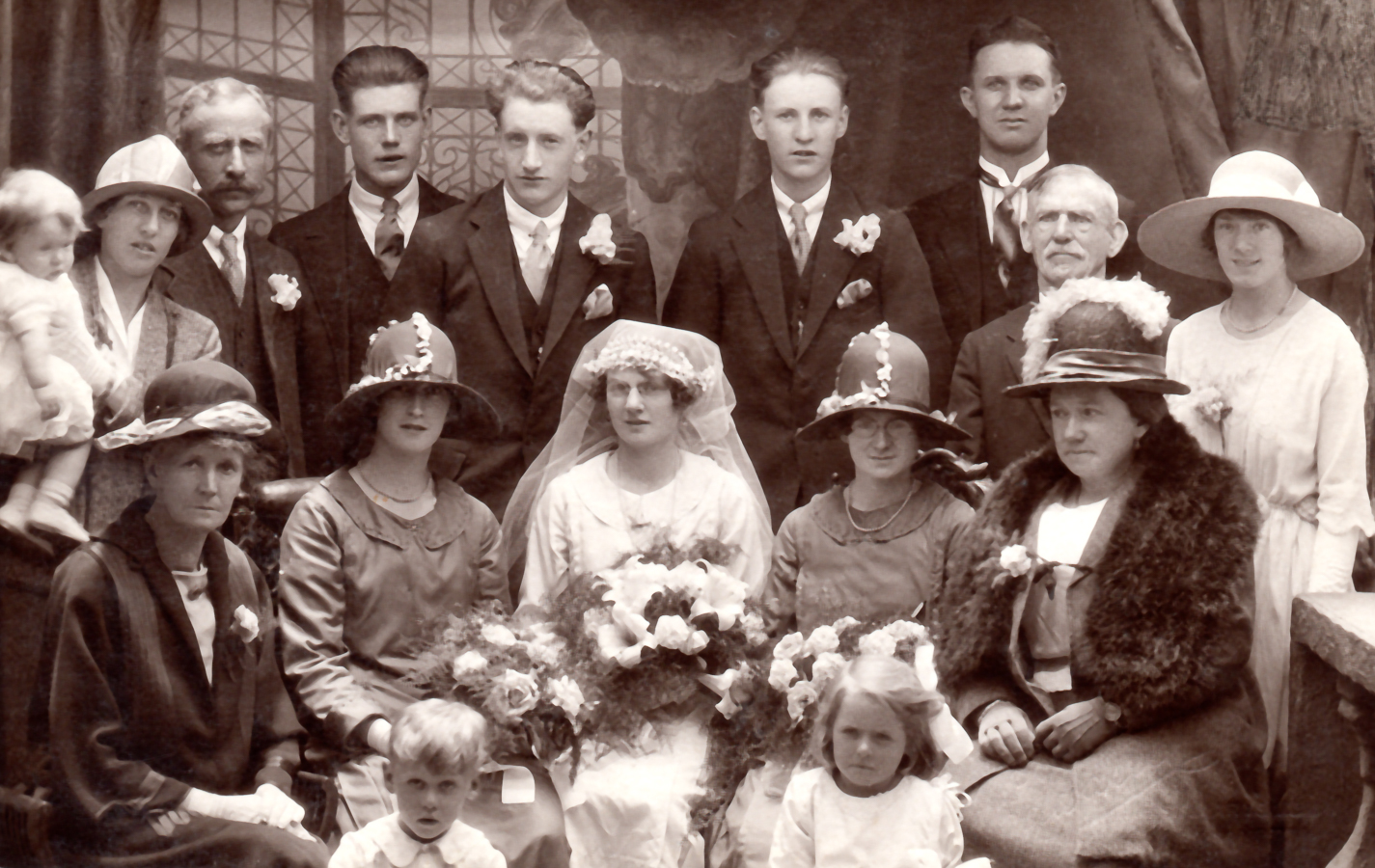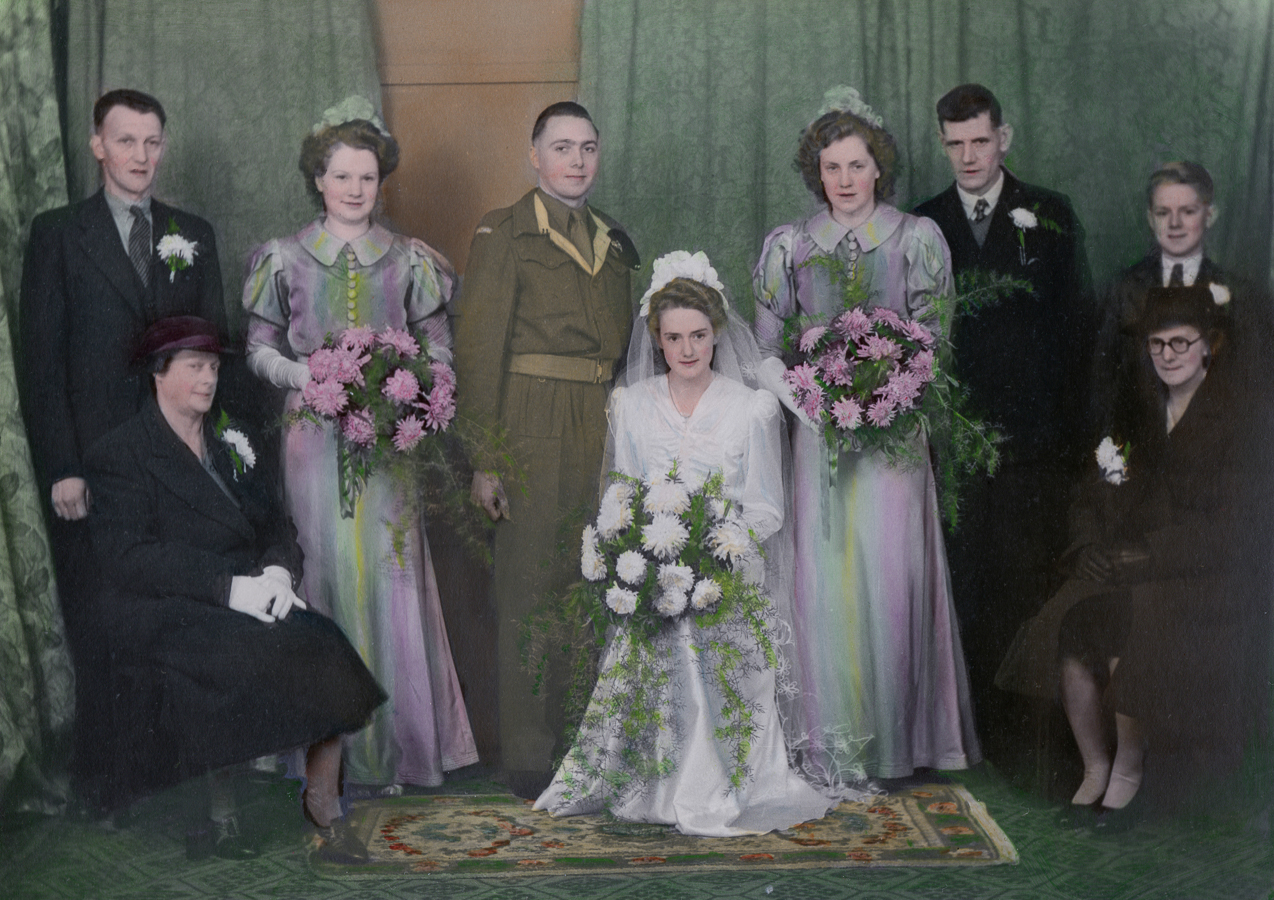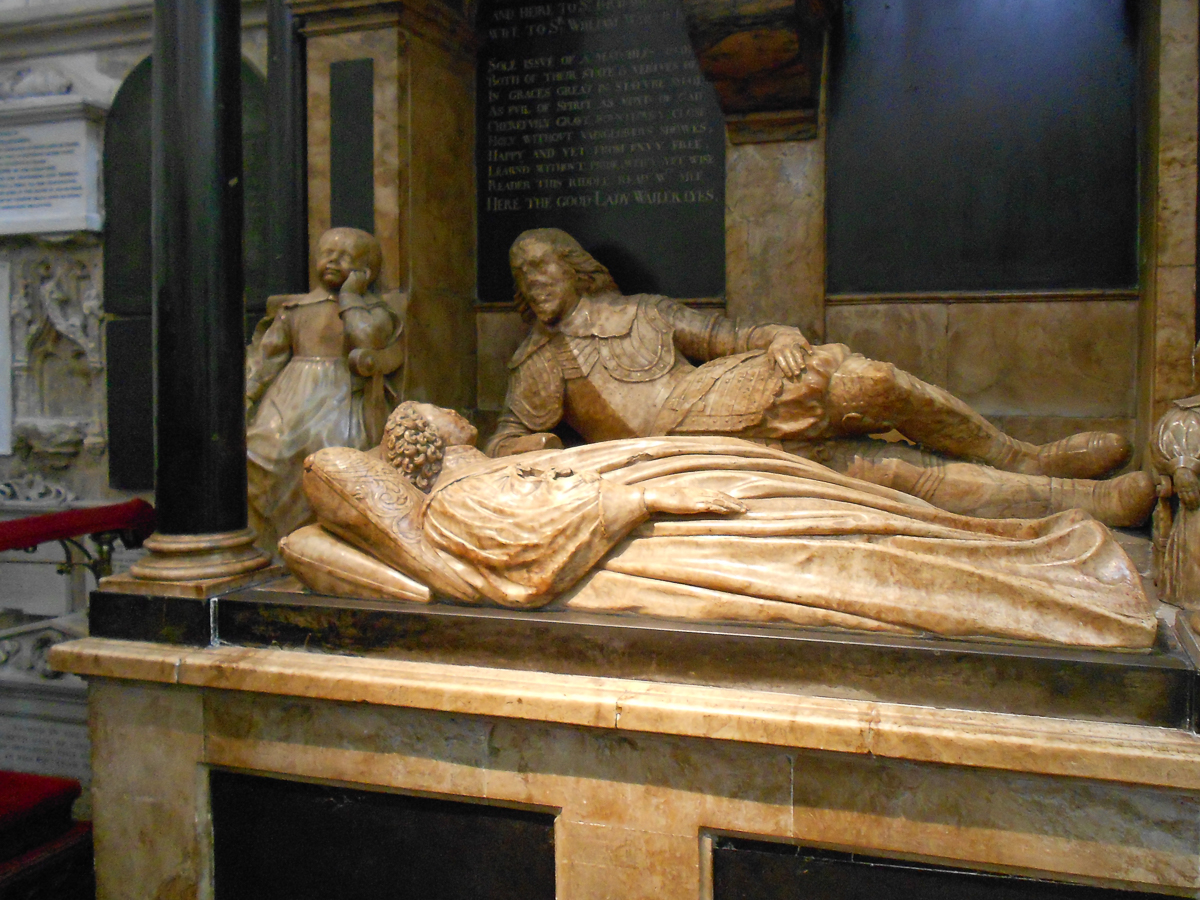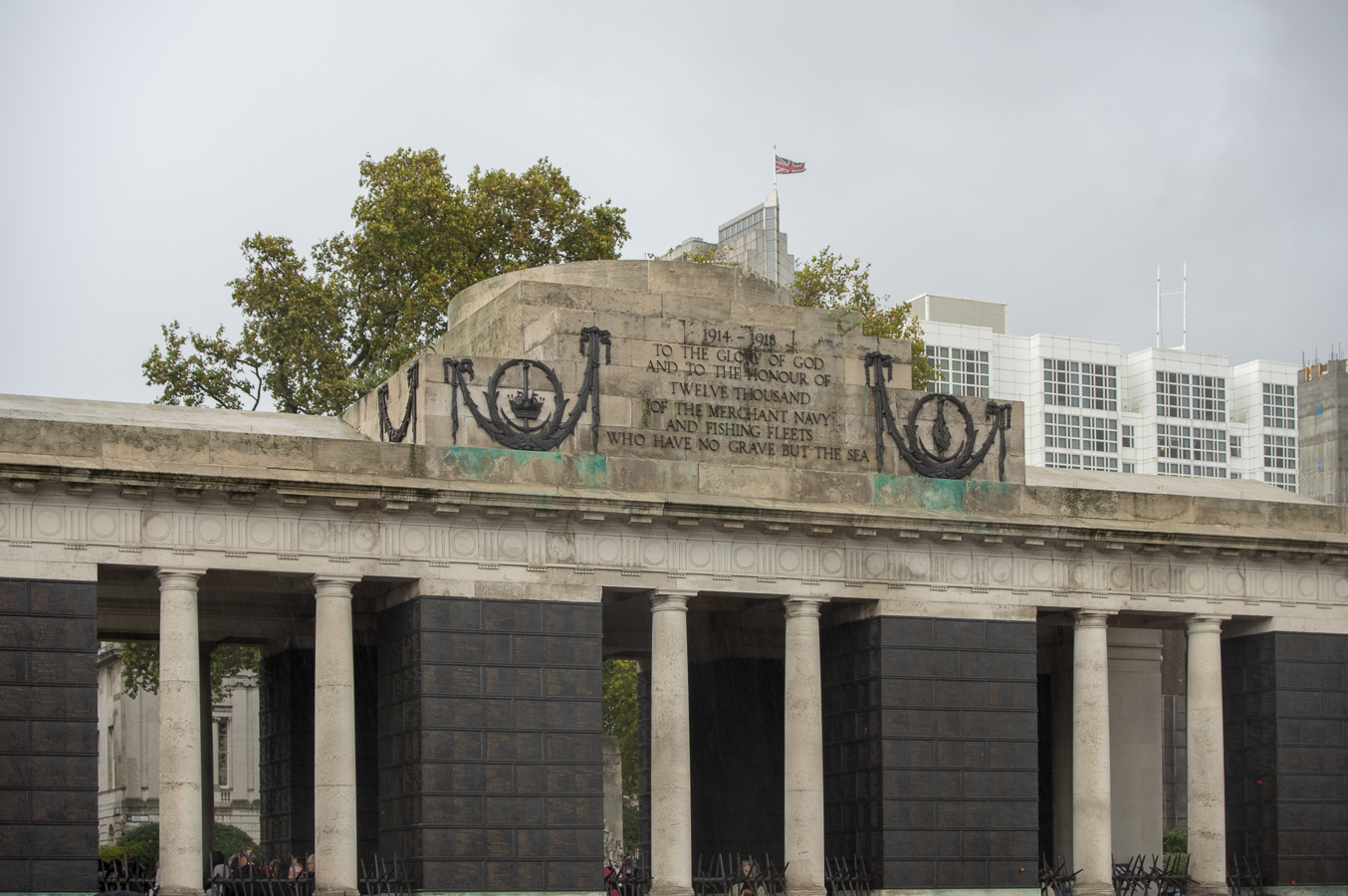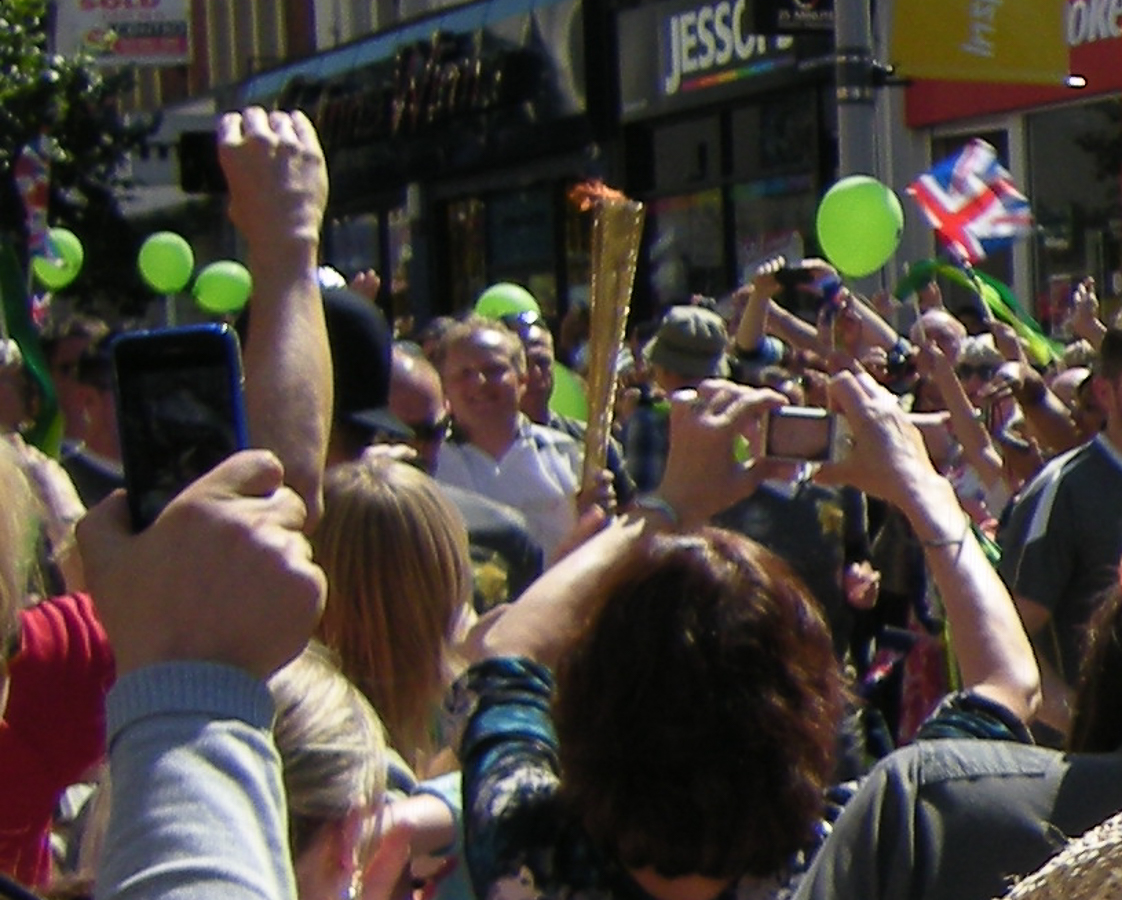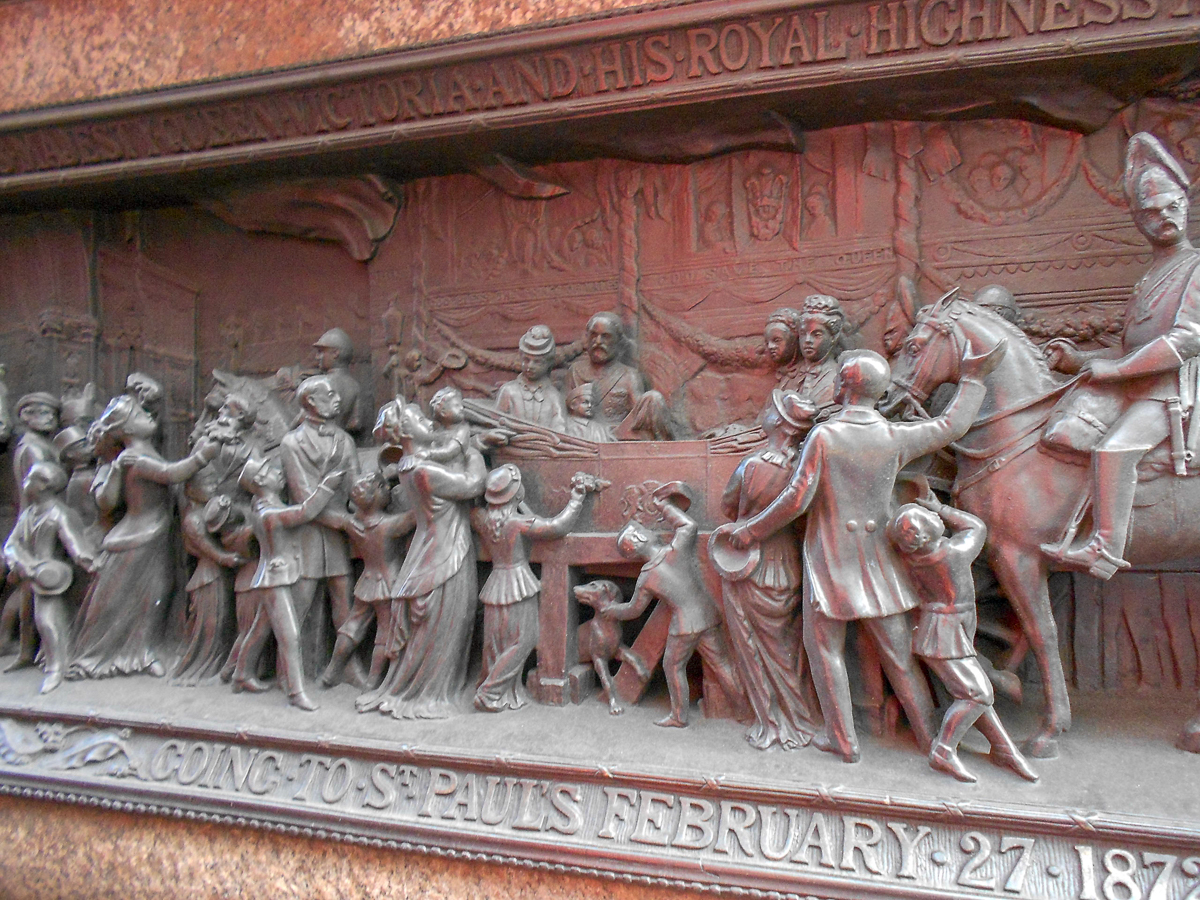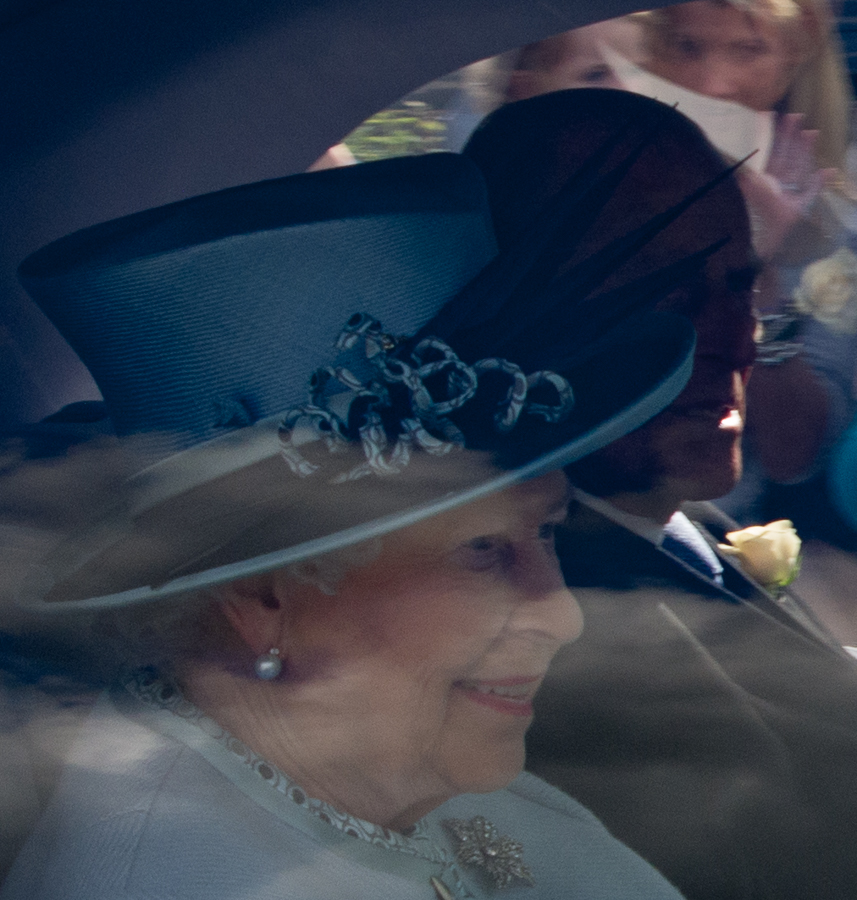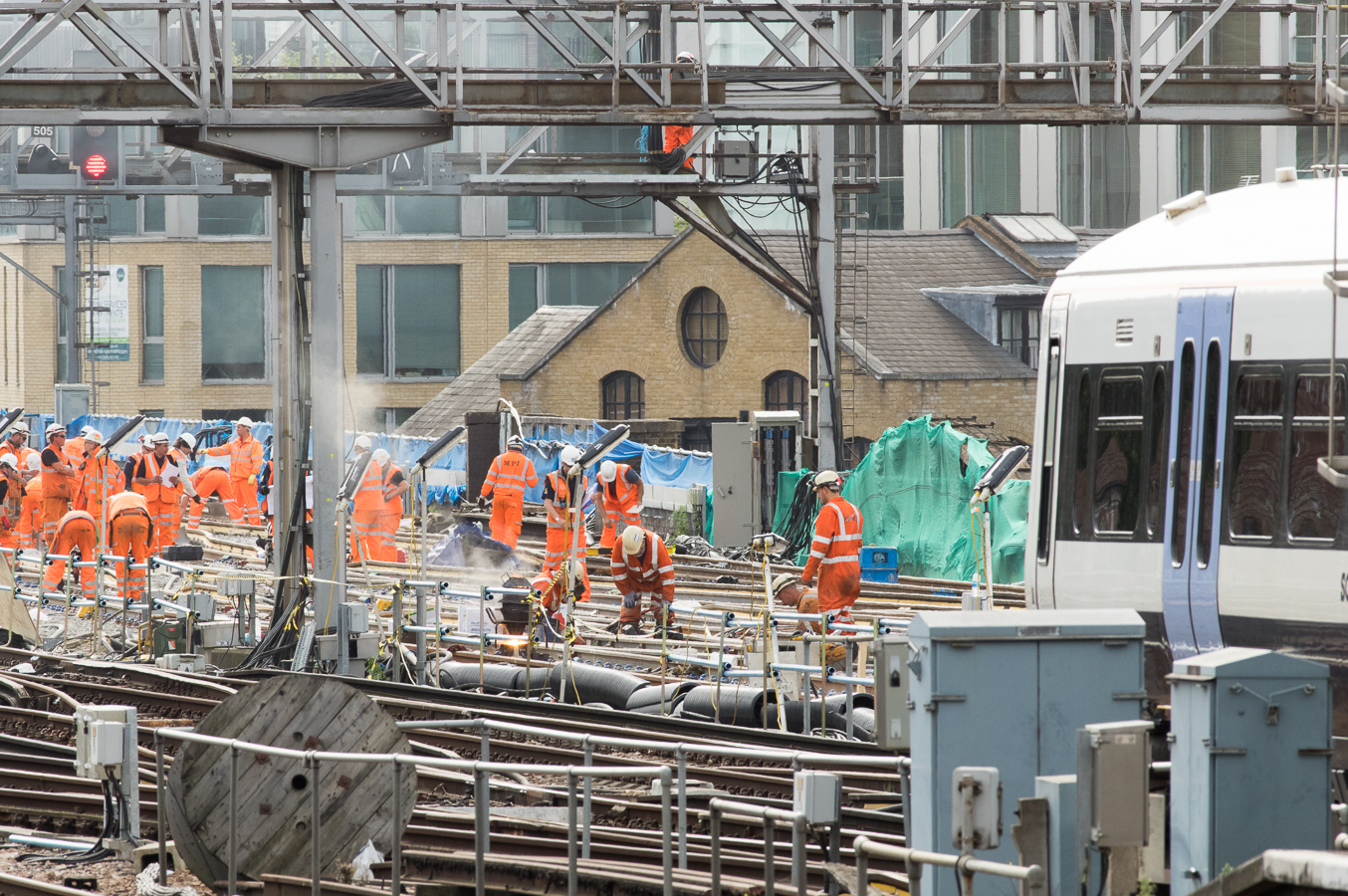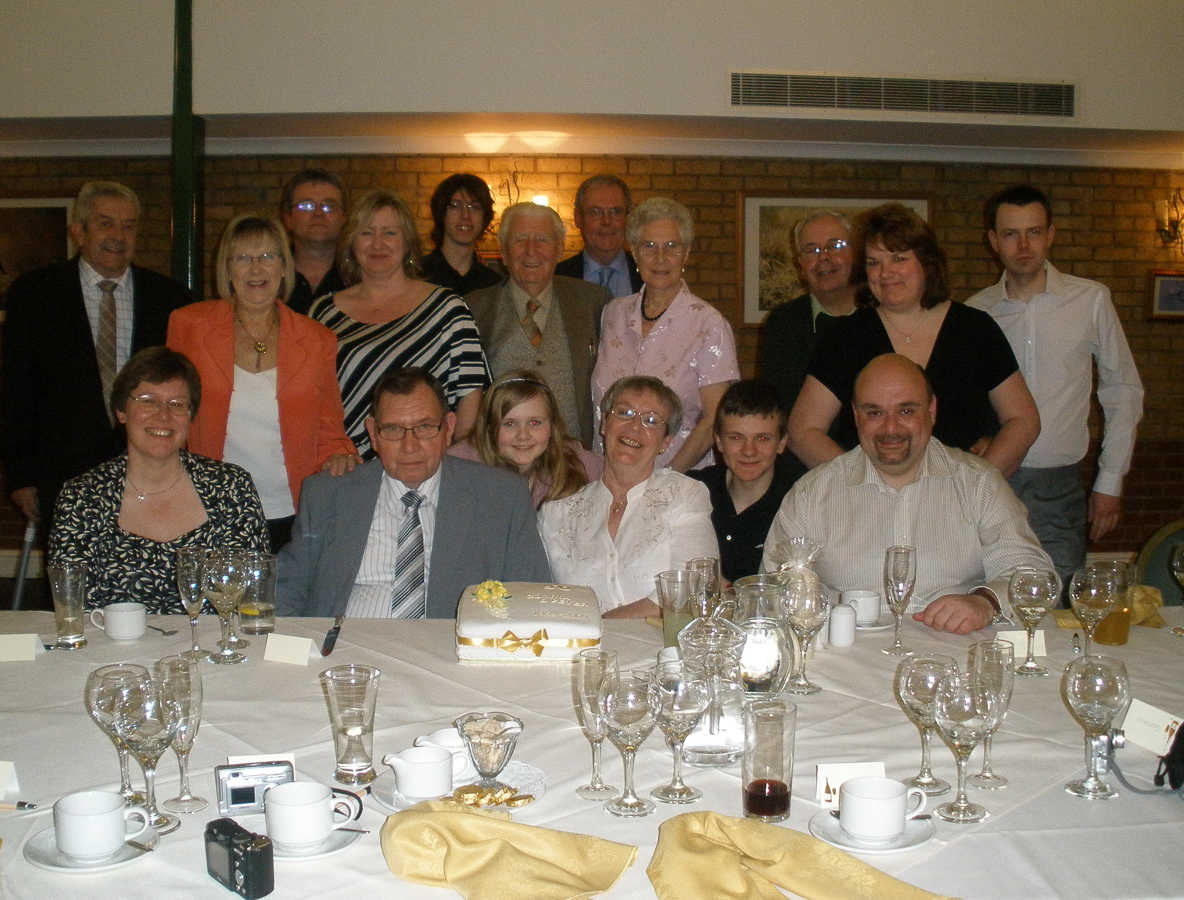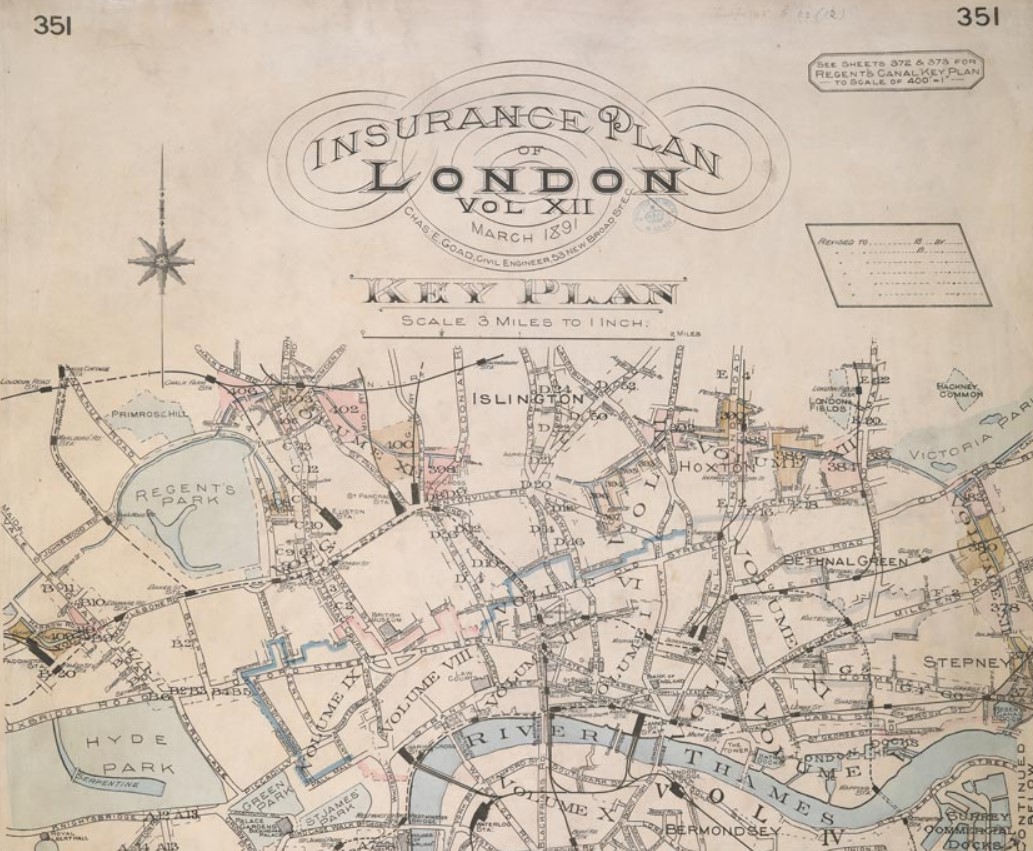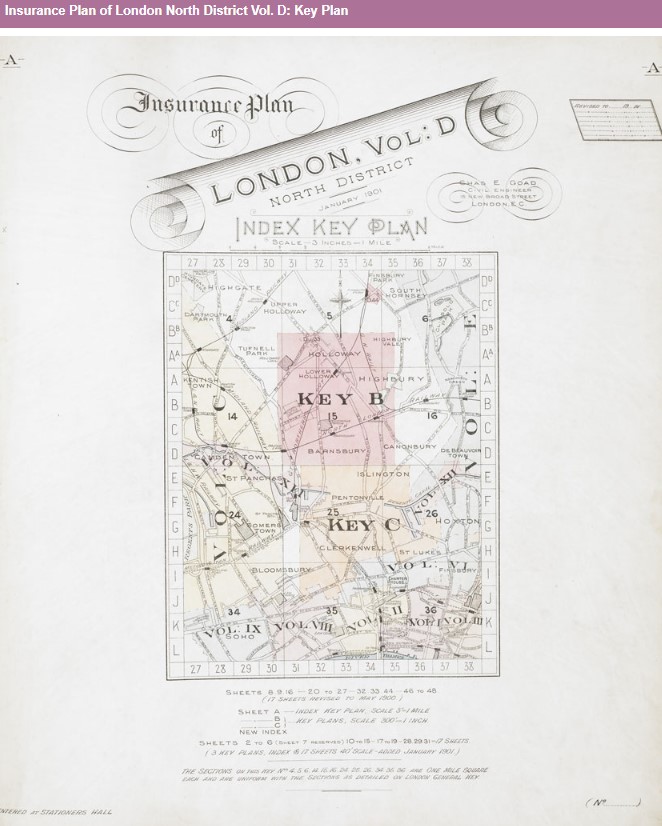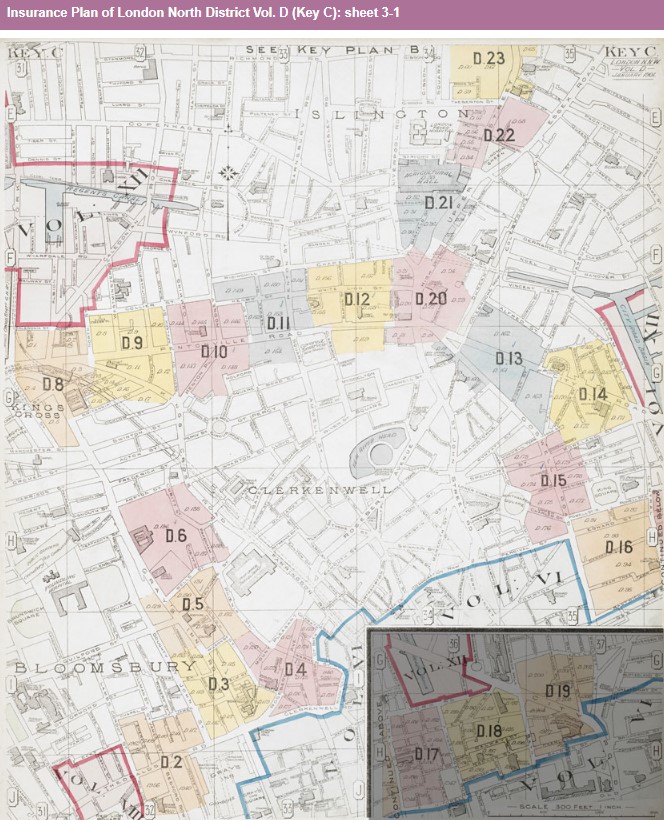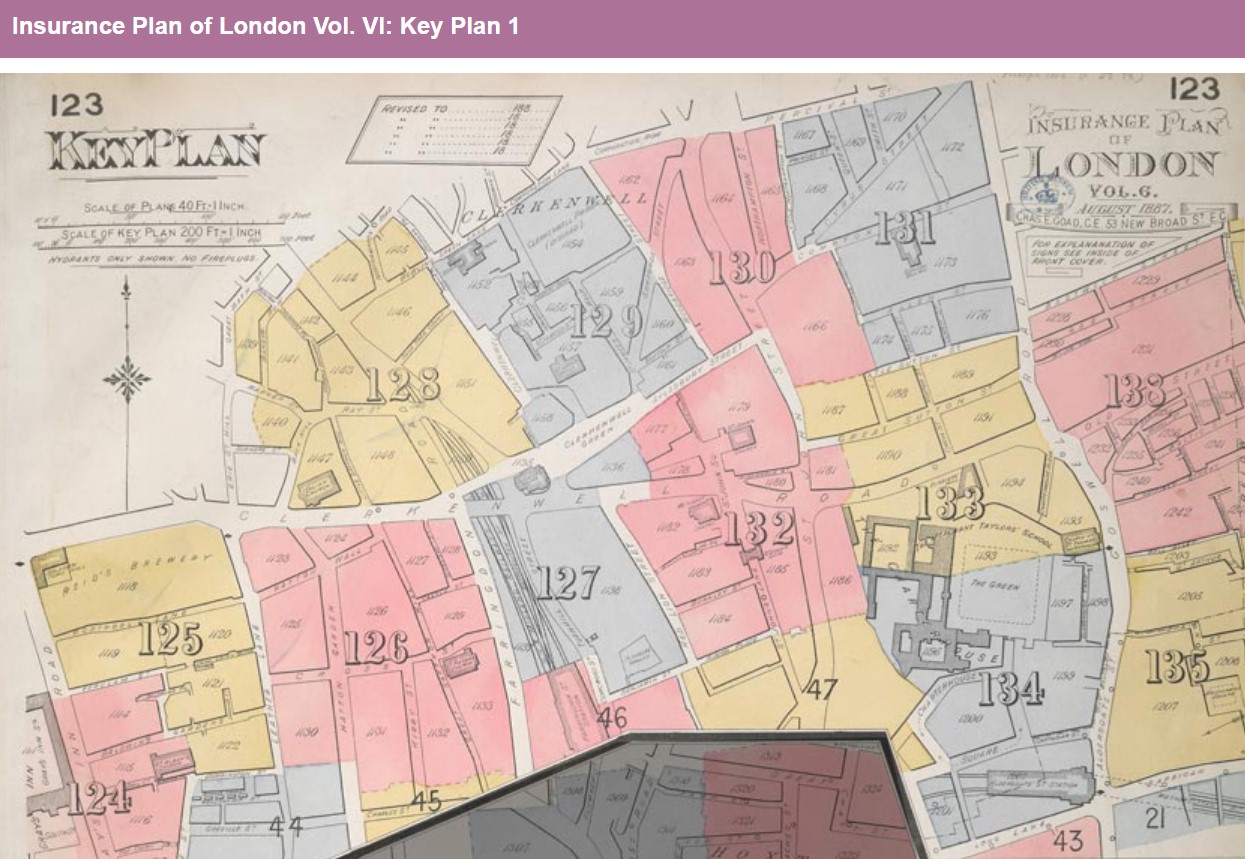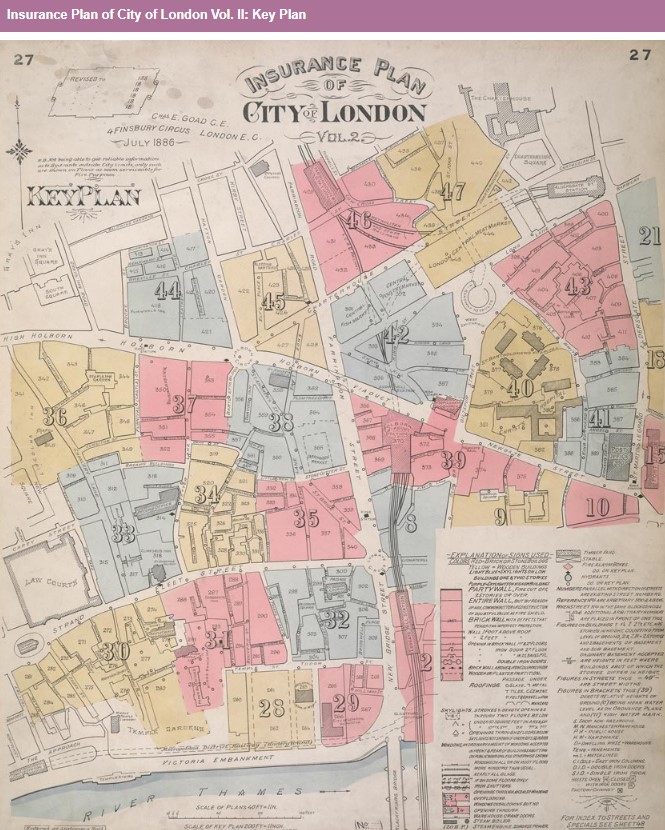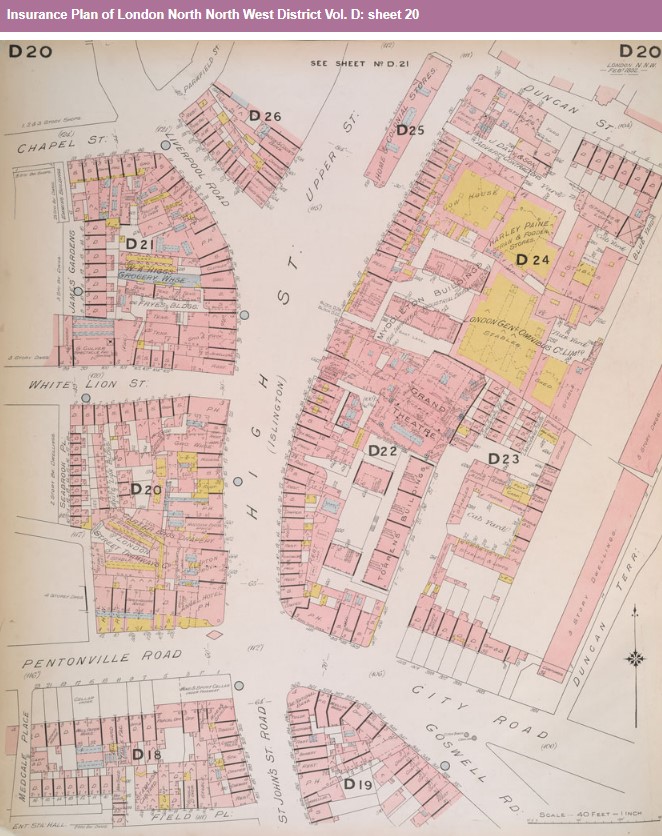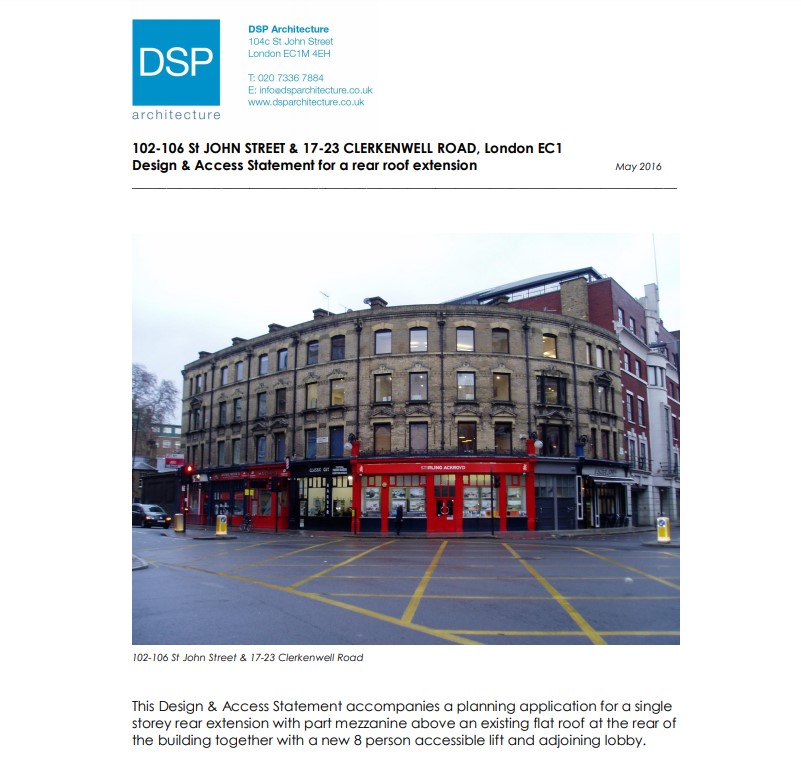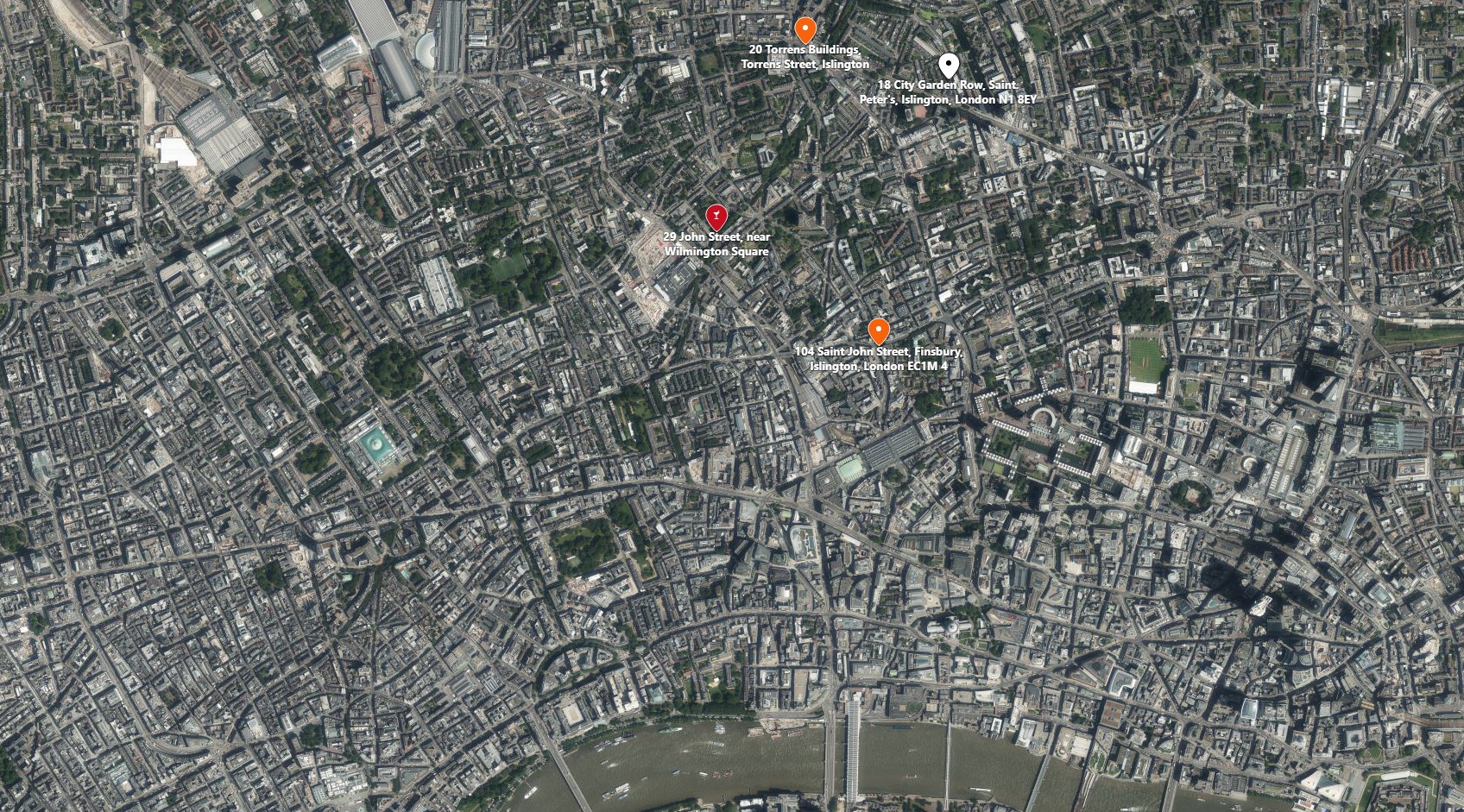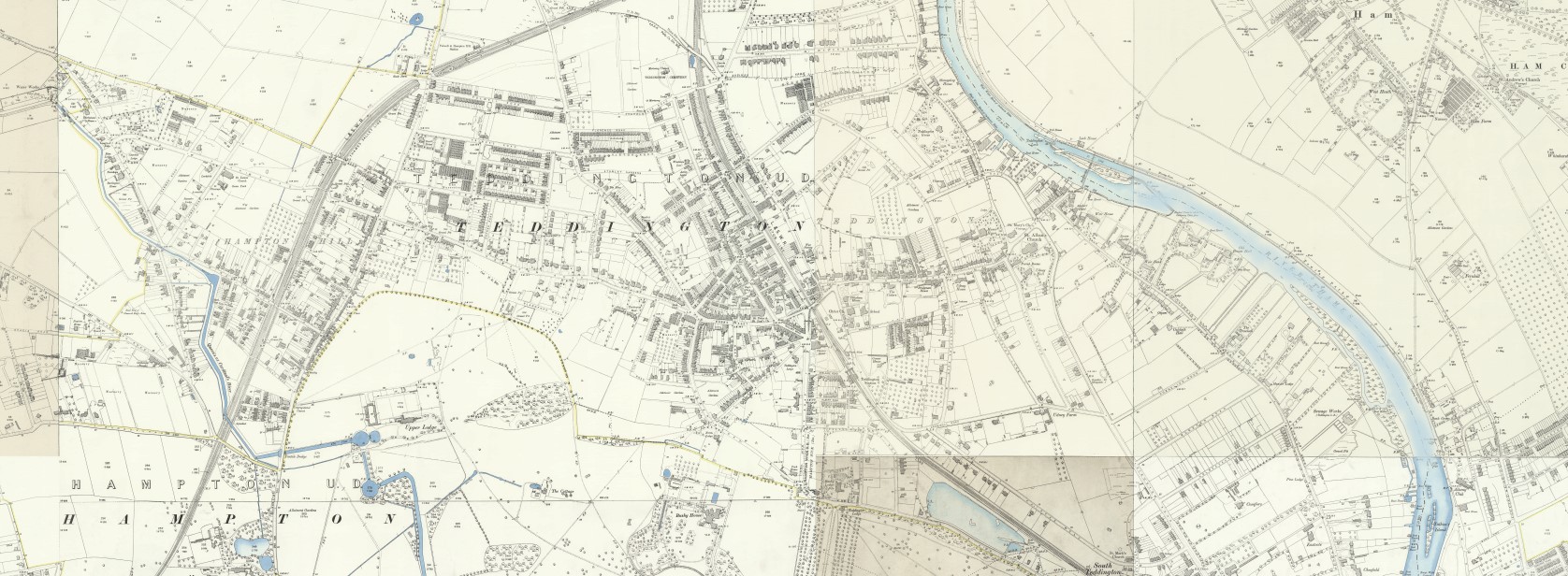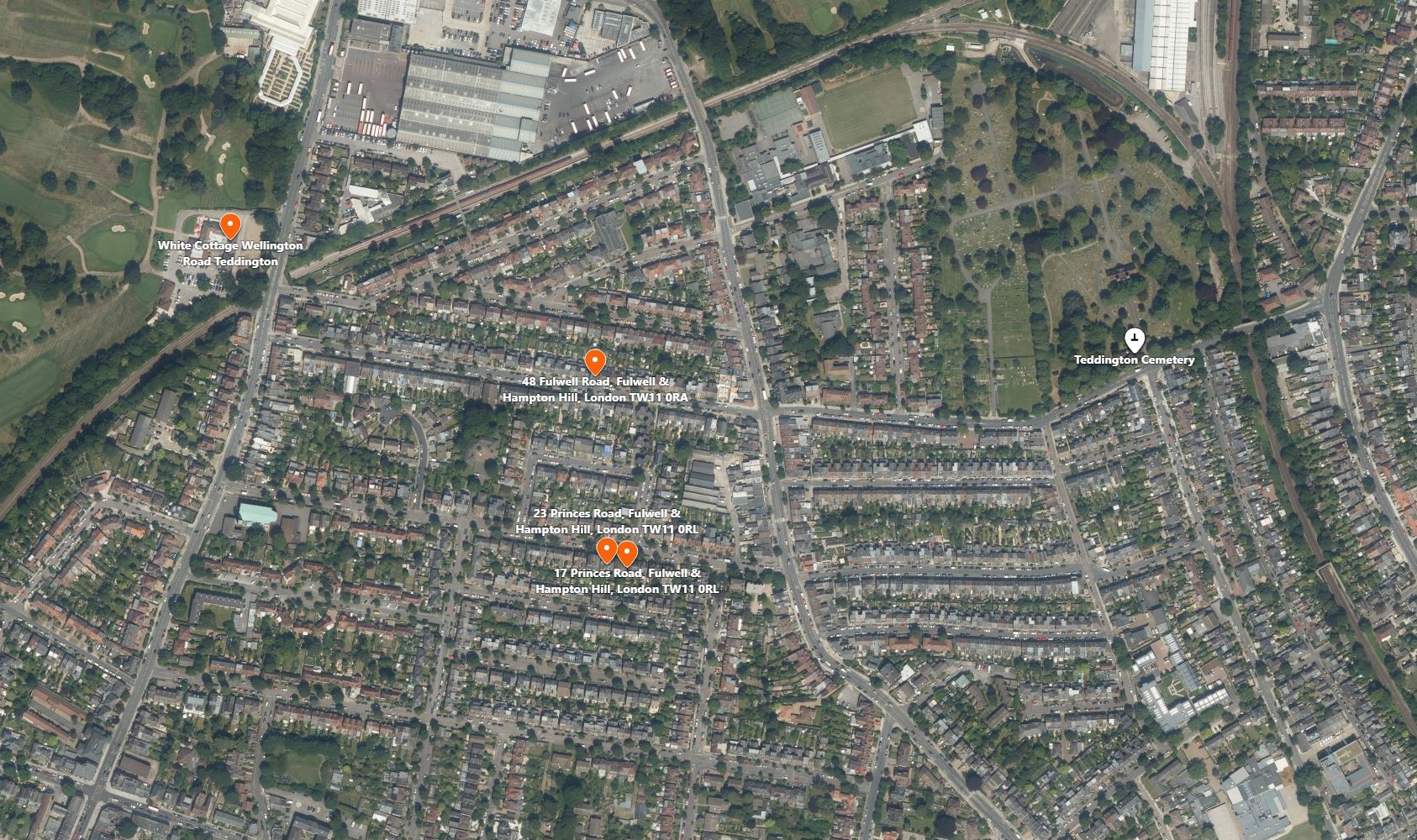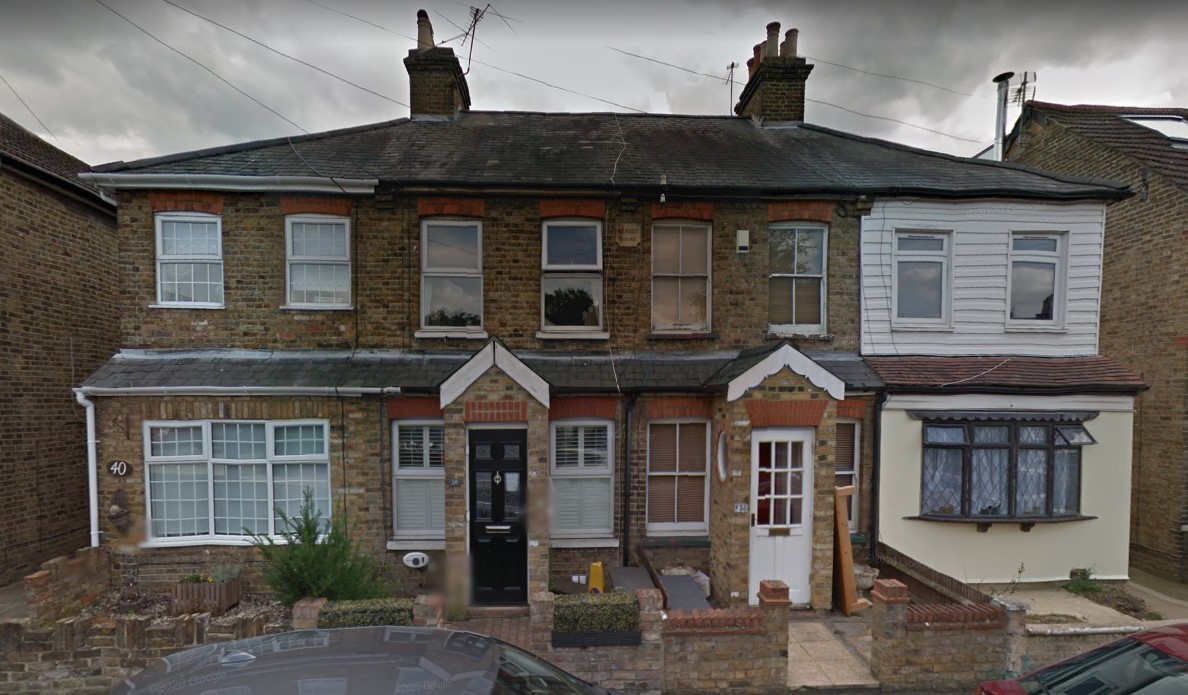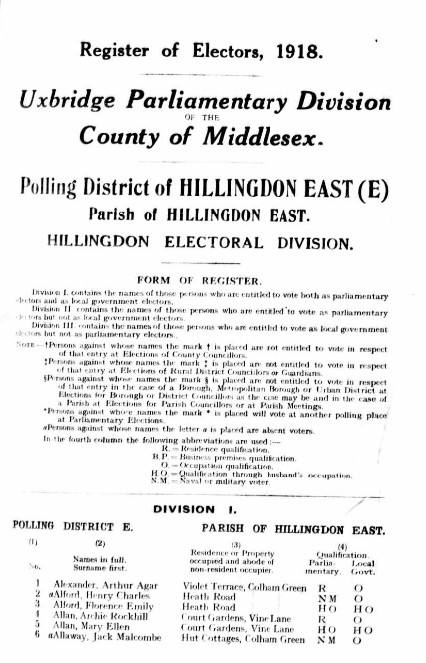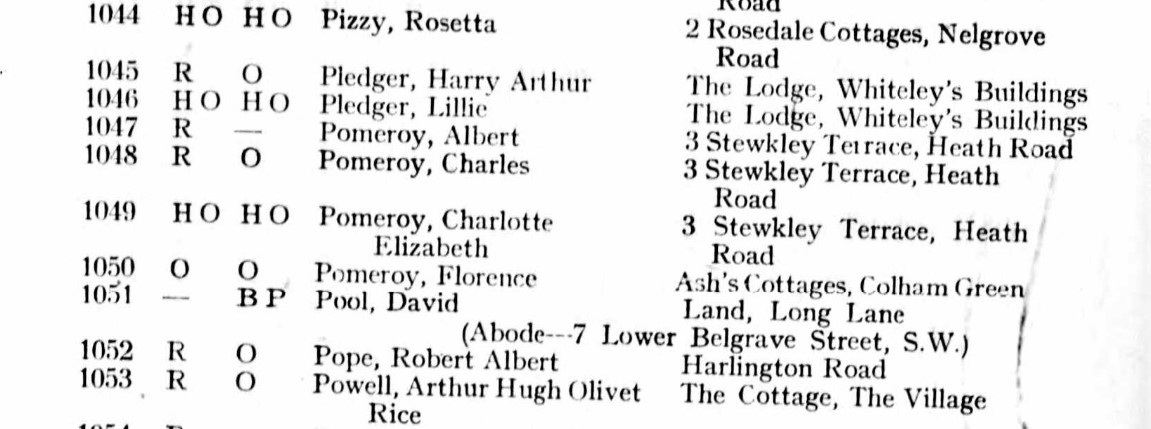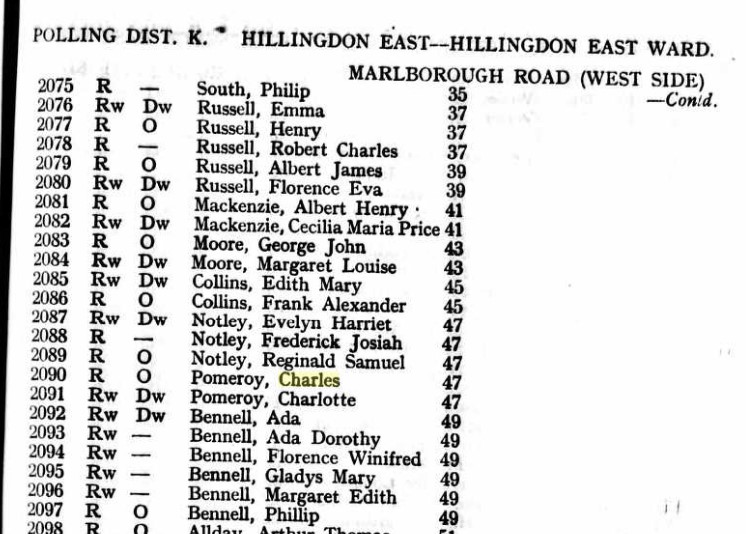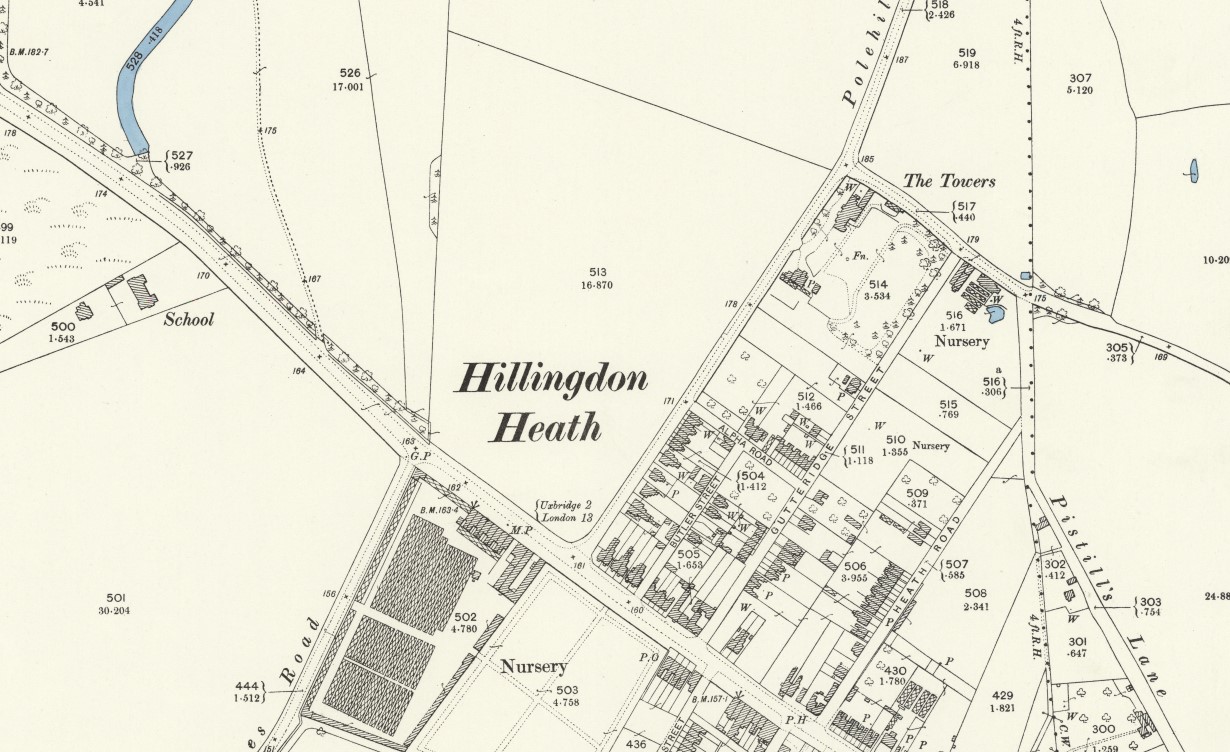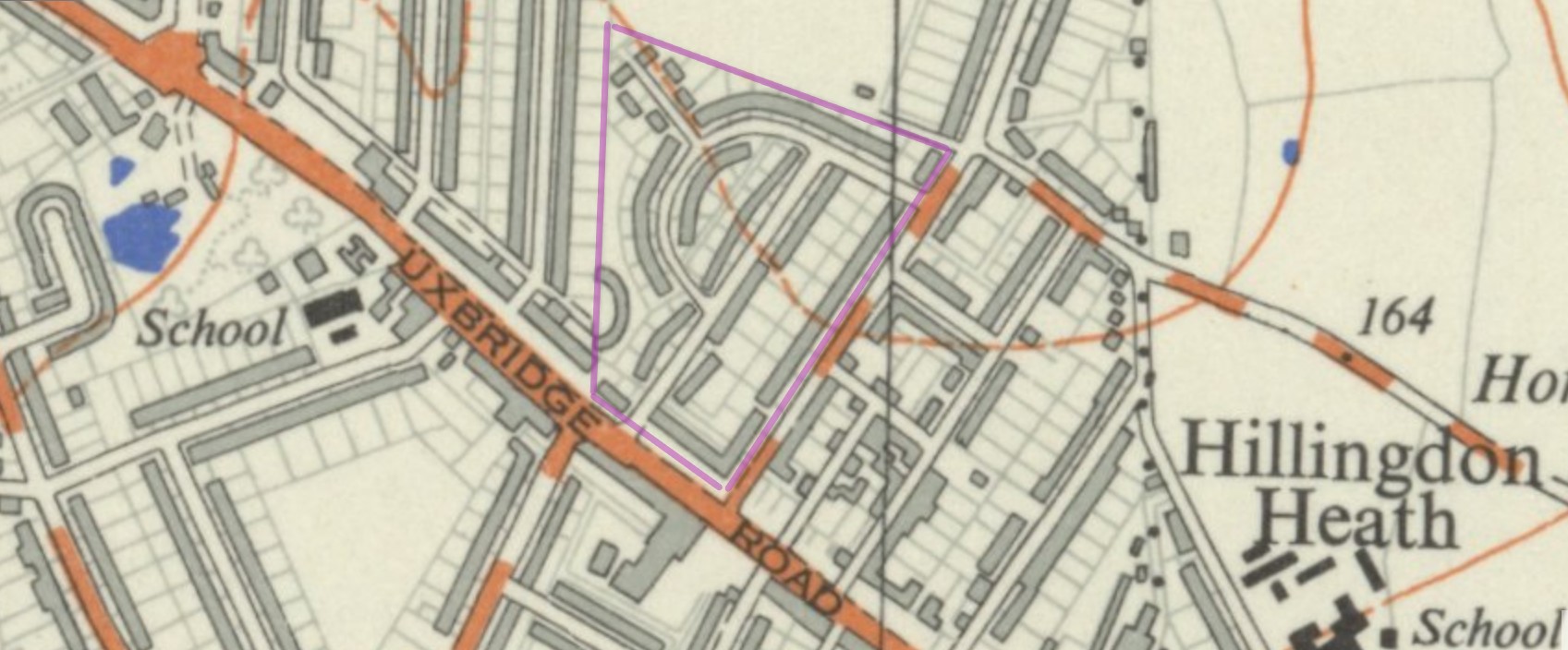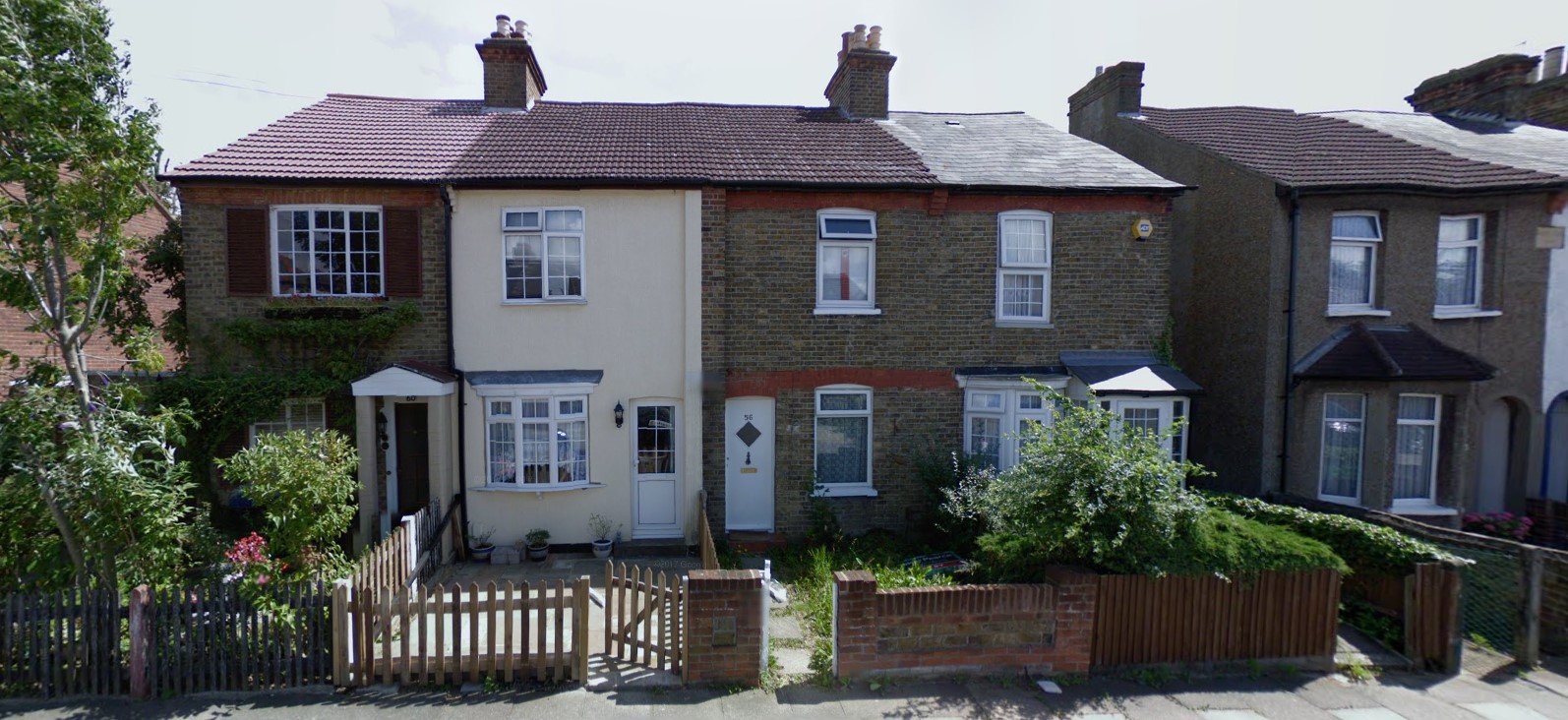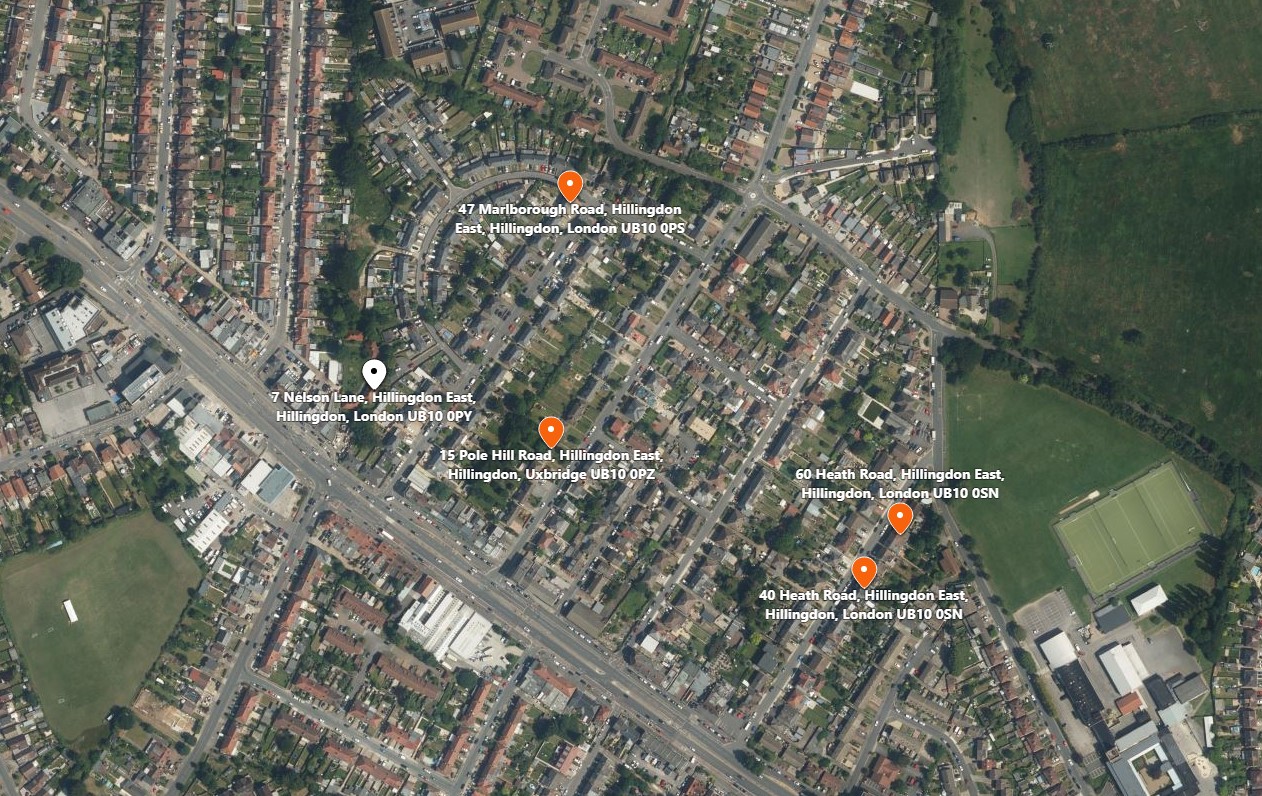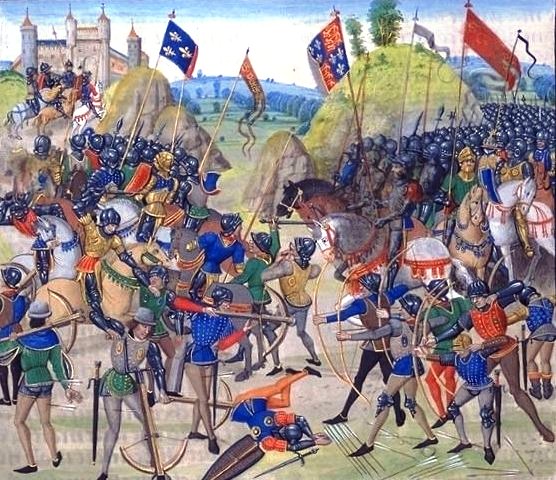Charles Pomeroy b 1854 Supporting Data - Abode
Charles Pomeroy was born in 1854, and Baptised on 29th October 1854. His parents were John and Mary Pomeroy from Broadwindsor. I believe he was born at Giles Cross, Roman Road, Bradford Peverell, Dorchester, Dorset, England. .
This article is an attempt to put together an evidential timelime of places that he lived from various records. It is supporting data to the full article about Charles Pomeroy.
Dorset
Dorset is a county in southwest England. It’s known for the Jurassic Coast, a long stretch on the English Channel where the cliffs contain many fossils, and rock formations show millions of years of geological history. Two prominent natural landmarks are Durdle Door, an ancient stone arch, and the layered cliffs at nearby Lulworth Cove. The towns of Poole, Weymouth and Swanage are popular for their sandy beaches.
The county town is Dorchester. The Romans established the settlement in the 1st century and named it Durnovaria which was a Latinised version of a Common Brittonic word possibly meaning "place with fist-sized pebbles". The Saxons named the town Dornwaraceaster (the suffix -ceaster being the Old English name for a "Roman town"; cf. Exeter and Gloucester) and Dornsæte came into use as the name for the inhabitants of the area from Dorn (a reduced form of Dornwaraceaster) and the Old English word sæte (meaning "people"). It is first mentioned in the Anglo-Saxon Chronicle in AD 845 and in the 10th century the county's archaic name, Dorseteschyre (Dorsetshire), was first recorded.
After the reorganisation of local government in 1974, the county's border was extended eastward to incorporate the Hampshire towns of Bournemouth and Christchurch. Around half of the population lives in the South East Dorset conurbation, while the rest of the county is largely rural with a low population density.
The county has a long history of human settlement stretching back to the Neolithic era. The Romans conquered Dorset's indigenous Celtic tribe, and during the Early Middle Ages, the Saxons settled the area and made Dorset a shire in the 7th century. The first recorded Viking raid on the British Isles occurred in Dorset during the eighth century, and the Black Death entered England at Melcombe Regis in 1348. Dorset has seen much civil unrest: in the English Civil War, an uprising of vigilantes was crushed by Oliver Cromwell's forces in a pitched battle near Shaftesbury; the doomed Monmouth Rebellion began at Lyme Regis; and a group of farm labourers from Tolpuddle were instrumental in the formation of the trade union movement. During the Second World War, Dorset was heavily involved in the preparations for the invasion of Normandy, and the large harbours of Portland and Poole were two of the main embarkation points. The former was the sailing venue in the 2012 Summer Olympics, and both have clubs or hire venues for sailing, Cornish pilot gig rowing, sea kayaking and powerboating.
Dorset is also the ancestral home of my branch of the Pomeroy family, particularily Broadwindsor.
Giles Cross
Giles Cross, Bradford Peverell - 1854 to 1861/1871
Now known as Gascoyne Barn or Bradford Peverell Farm, Giles Cross, Roman Road, Bradford Peverell, Dorchester.
At the junction of Roman Road, Gascoyne Lane and Tilly Whimm Lane.
In the county of Dorset, aka Dorsetshire.
Timeline of Charles Pomeroy
1854 Charles 0 years of age
Baptism

1861 Charles 6 years of age
Charles Edward Pomeroy and first appearance on the 1861 Census in the Parish of Bradford Peverell. Most births were at home in this period, so I will record his place of birth as being Giles Cross, Bradford Peverell.
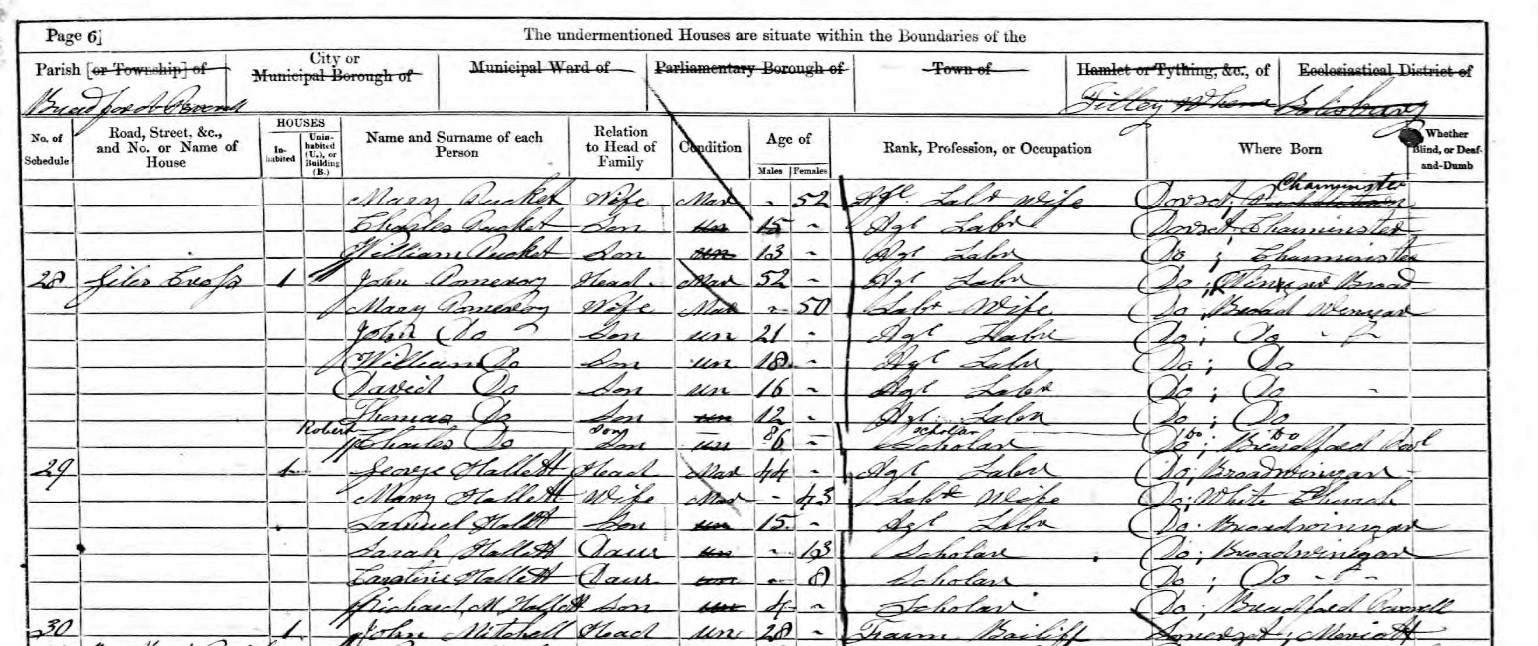
Giles Crofs is in fact Giles Cross as at the time ss was written fs, although the f was without the cross bar and was actually a tall s. The family was all born in Broad Windsor (Broadwindsor), Devon, except for Charles who was born in Bradford Peverell.
Compton Valence
Compton Valence, Dorset - 1861/1871 to c1878
A small Parish and a countryside village off the main road, which is also called Roman Road, but is not the same road as in Giles Cross. Post Town, Dorchester.
In the county of Dorset, aka Dorsetshire
1871 Charles 16 years of age
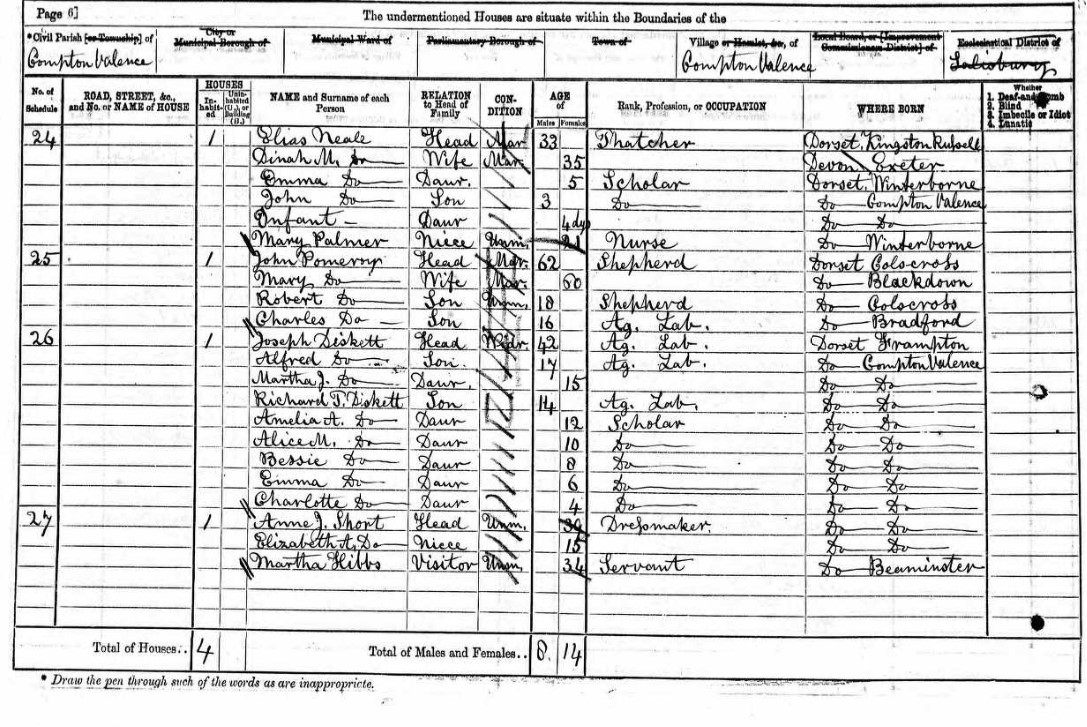
This page of the 1871 Census is the first evidence of the families move from Giles Cross in the Parish of Bradford Peverell to the Parish of Compton Valence.
John and Mary Pomeroy together with children Robert 18 and Charles 16. John and Robert are Shepherds and Charles is an Agricultural Labourer. John and Mary are 62 and 60 years old.
Robert was born in Coles Cross and Charles in Bradford (Peverell) making the families move from Coles Cross to Giles Cross, between 1852 and 1854.
On 6 May 1878 he joined G Division of Metropolitan Police in London, when he was still single and 23 years of age. I think it is a safe assumption that Charles had moved to London for this job.
The next record of place of abode is his Marriage Certificate, and that is 1878.
Go to the next area of interest, his move to London, Clerkenwell. Opens below.
Clerkenwell
The Clerkenwell area apears to be the first place of landing in London both before and after marriage. Clerkenwell is an old parish, outside London Walls. It had something of a poor reputation in the past.
It also had a historic one.
Clerkenwell took its name from the Clerks' Well in Farringdon Lane (clerken was the Middle English genitive plural of clerk, a variant of clerc, meaning literate person or clergyman). The first surviving reference to the name is from 1100. In the Middle Ages, the London Parish clerks performed annual mystery plays there, based on biblical themes. Part of the well remains visible, incorporated into a 1980s building called Well Court. It is visible through a window of that building on Farringdon Lane.
The Worshipful Company of Parish Clerks is one of the oldest London Guilds, having received its first charter from Henry VI in 1442. Its predecessor, the Fraternity of St Nicholas, is mentioned in records as early as 1274.
Originally, as the name suggests, our members consisted of the clerks of the local parishes in the City of London. In modern times, the Company has established a separate charity fund, which gives grants to a range of causes. Many members are also involved in the upkeep and oversight of some of London ancient churches.
St James Clerkenwell
• The parish of St James, Clerkenwell, has had a long and sometimes lively history. The springs which give Clerkenwell its name are mentioned during the reign of Henry II.
• The parish clerks of London used to perform their mystery plays based on Biblical themes, in the neighbourhood, sometimes in the presence of royalty.
• In approximately 1100 a Norman baron named Jordan Briset founded a Benedictine nunnery dedicated to St Mary, which became wealthy and influential. It had a place of pilgrimage at Muswell Hill, and the parish kept an outlying tract of territory there until the nineteenth century.
• At the dissolution of the nunnery under Henry VIII, the church, which by then seems to have acquired a second dedication to St James, was taken into use by its parishioners who had already been using a part of it for some considerable time. The site of the nunnery was granted to Thomas Howard, 3rd Duke of Norfolk in 1540 but the freehold of the church passed through various hands until it was conveyed in 1656 to trustees on behalf of the parishioners, who at the same time obtained the right to appoint the vicar. Unlike other parishes, they retained it after the Restoration of 1660. Elections of vicars were held, with all the excitement and paraphernalia of parliamentary elections, right down to the early years of this century and a distinctly Low Church tradition was thereby established.
Charles Pomeroy and family, places of abode, aka homes.
Not all of the abodes are strictly within the Parish Boundary of Clerkenwell, but for our purposes, they will be treated together, under the general heading of Clerkenwell.
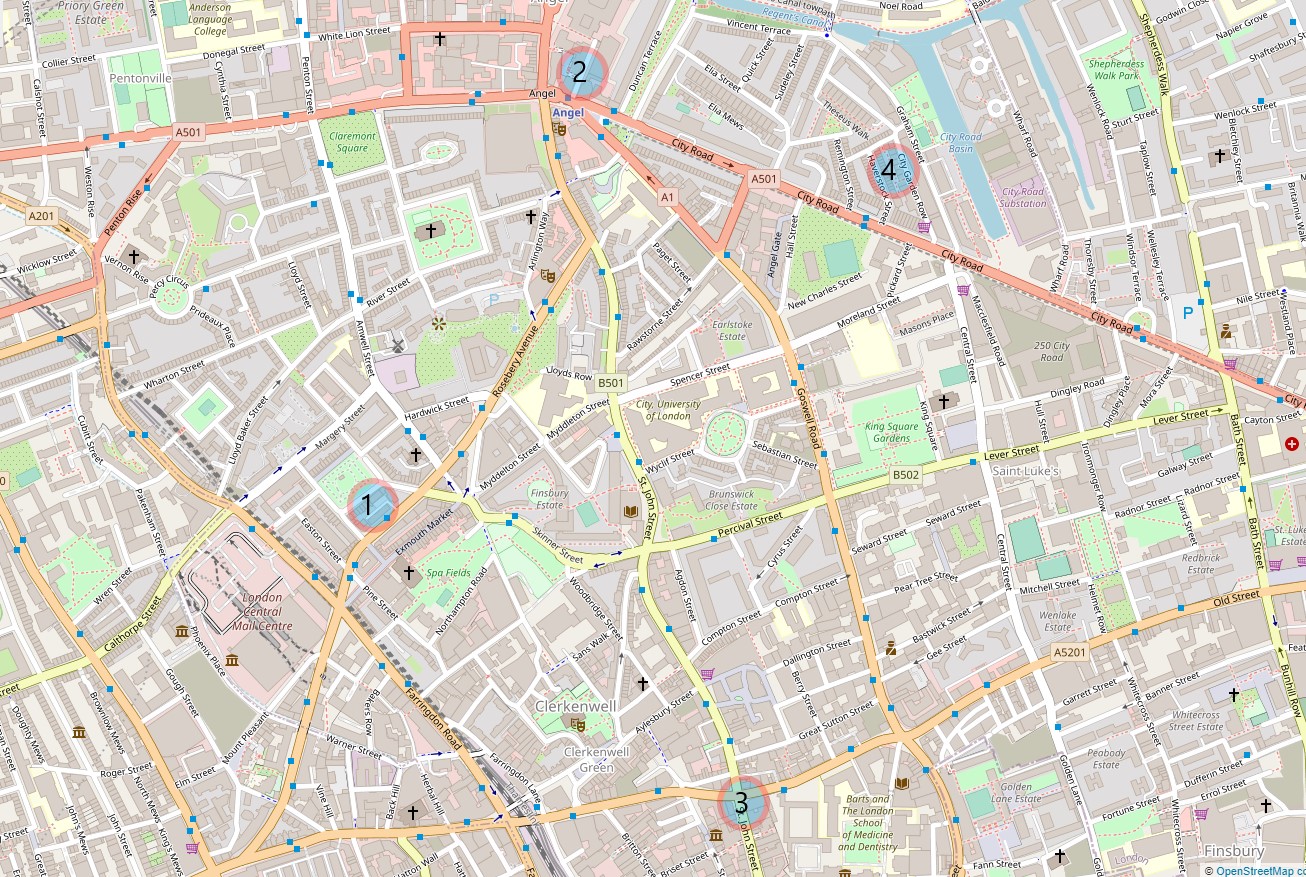
An OpenStreetMap of the area with the four places of residence identified so far. Each less than 1m to the next as the crow flies. The information about the places of abode are brought forward from the investigations outlined below, so this is out of chronological order.
- 29 John Street was probably between Wilmington Square and Spa Fields. Lost to the construction of Rosebery Avenue.
- 20 Torrens Buildings, Torrens Street, Angel, Islington, the street is still there but the buildings are demolished.
- 104 Saint John Street, Clerkenwell, the building still exists.
- 18 Palmerston Buildings, City Garden Row, the street is still there but the buildings are demolished.
Something of a summary conclusion brought forward.
The investigations in Clerkenwell area residency begin.
Having found the locations of Charles Pomeroy's home, the next task is to find out the current Parish and from there the date appropriate Parish and the associated Parliamentary Division and Ward.
The above map is ESRI Church of England parish map. It is open at the approximate location of 29 John St near Wilmington Square. The orange dot that you can see on opening is the location of the Church of the Our Most Holy Redeemer. Click on the dot for information about the church, and elsewhere on the map for data about the Parish. Below, a bit later on, you can see an image of the Spa Fields Chapel. The distinctive round dissenting chapel, once the Pantheon, was demolished in 1886 and replaced with the Church of the Holy Redeemer that still stands there today. The orange dot.
Boundary Maps and administrative names
The search for the Parish name and which Ward to help find the correct Register of People eligible to vote, aka Register of Voters, aka Electoral Roll.
Start with County and Hundreds.
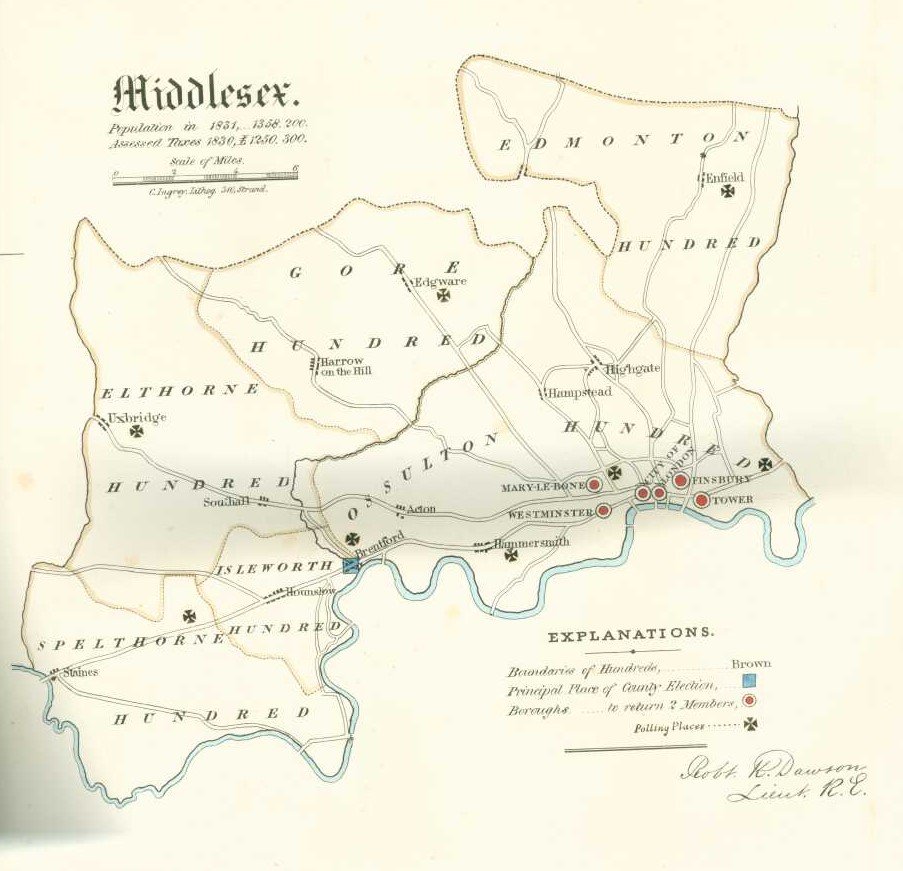
The parish map of Middlesex 1880 from 'A Vision of Britain Through Time', zoomed in to the Clerkenwell area.

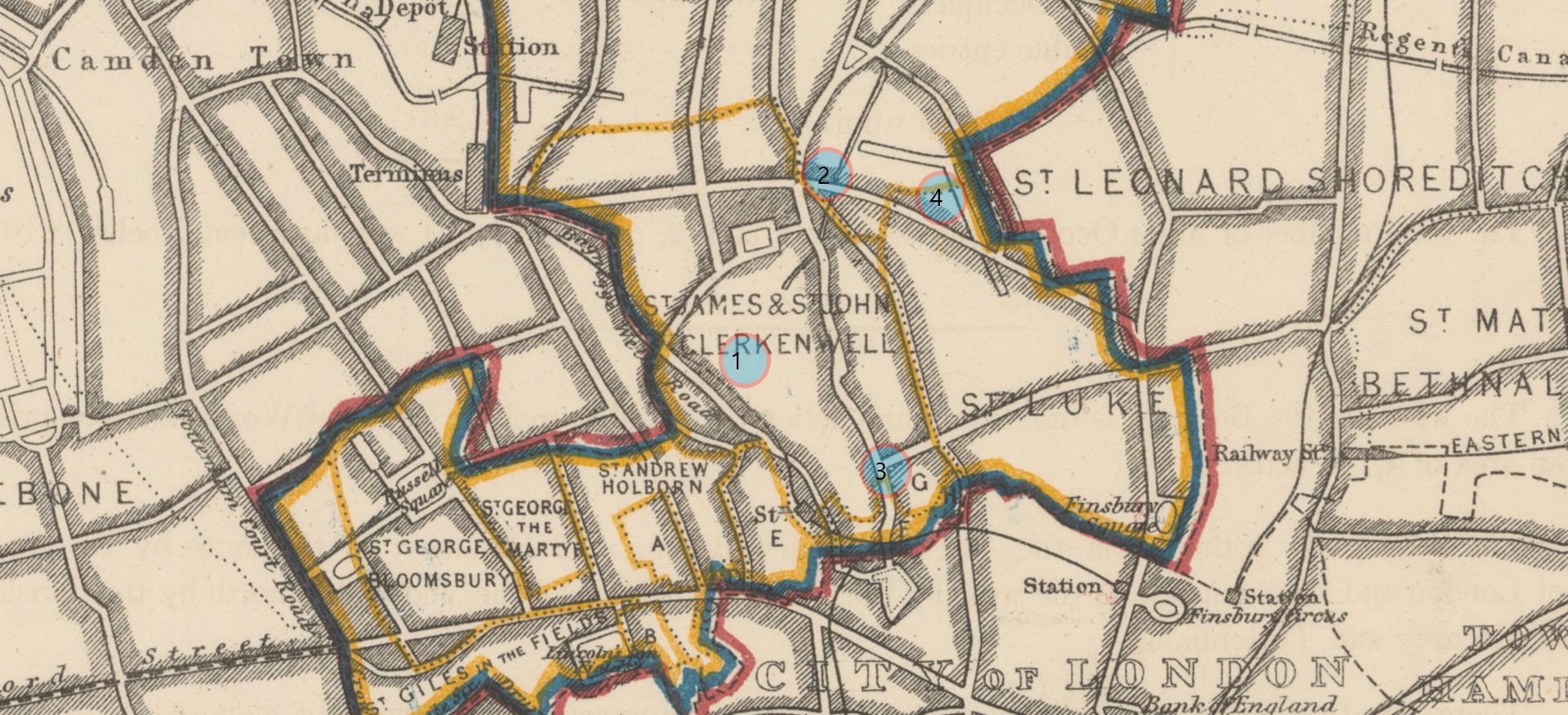
The same map but zoomed in to the Clerkenwell area. The Map has additions of red and blue circles from the summary OpenStreetMap above, indicating the approximate position of Charles Pomeroy's homes with his growing family.
A later 1885 Map of Islington

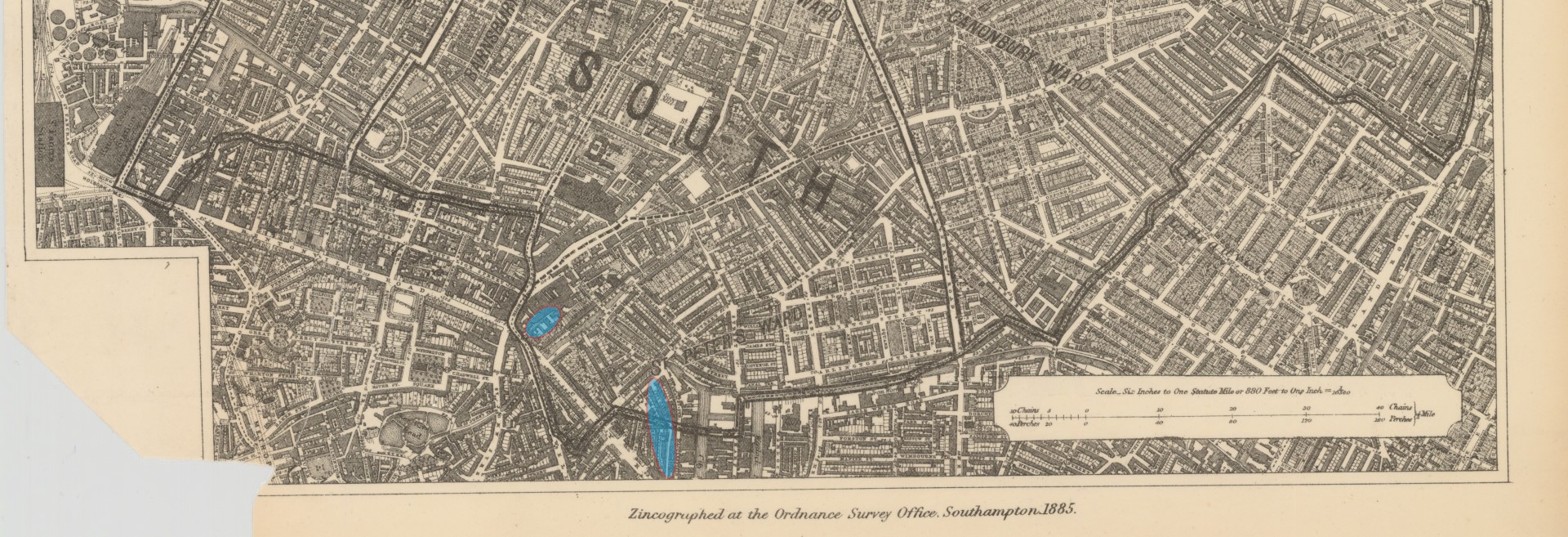
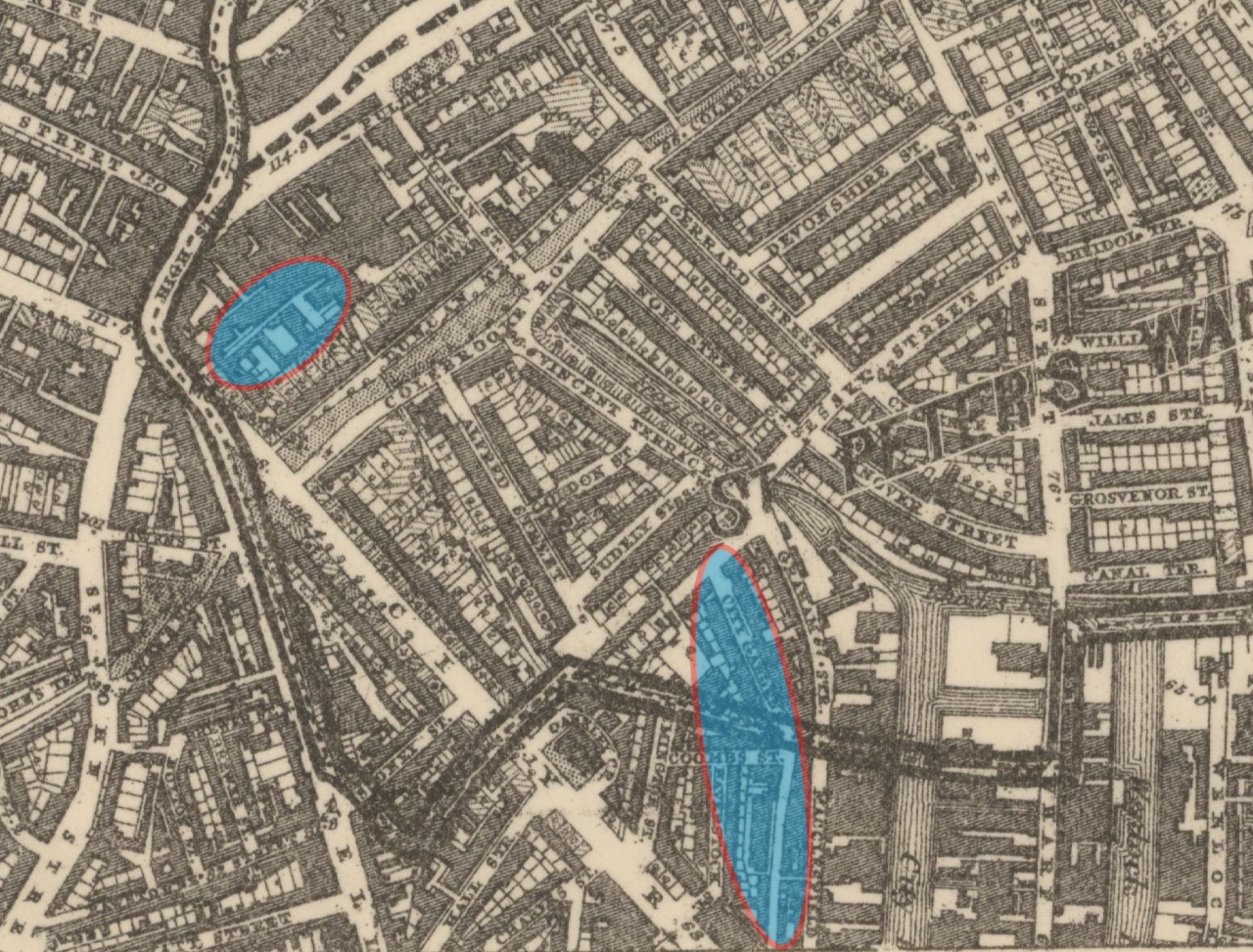
Islington, then Islington South, then part of St. Peter's ward with Torrens Street and City Garden Row picked out. Map downloaded from 'A Vision of Britain Through Time'
Honing in on the exact location of the address of the abode
British Library Fire Insurance Plans
Another great find.
A source of information to help identify places is the British Library. The above map is part of a series of fire insurance plans. It is part of the Crace Collection of Maps of London.
Individual sheets should identify streets and perhaps buildings, at each abode. The general Key plans first, to help identifiy which detail sheets to look at. Each detailed sheet covers a very small area.
The timeline of Charles Pomeroy continued
1877 Charles 23 years of age
1877 Register of Voters
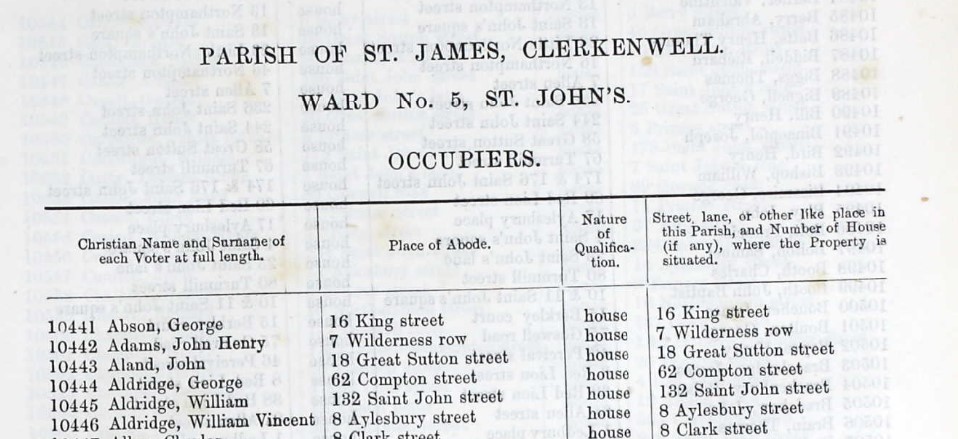
Not necessarily expecting to find anything of significant in 1877, the first viable 'Register of People entitled to Vote' for our purposes. Part of the Finsbury Parliamentary Division, St. James Clerkenwell, has five Wards.
- St. James, Pentonville
- St. Phillip's
- St. Mark's
- St. James Clerkenwell
- St. John's
Page turning through the digital book, through Occupiers and Lodgers, there are no entries with the surname Pomeroy.
He would have had to be a qualifying person in 1876 in the Parish to have made it onto the register for 1877.
1878 Charles 24 years of age
Similarly, again page turning through the digital 'Register of People entitled to Vote' book for 1878, through Occupiers and Lodgers, there are no entries with the surname Pomeroy. There is now a gap in source records on Ancestry from 1878 to 1885, for this Register.
From the find in the 1885 Register that 29 John Street was in Ward no. 2, St. Philip's, I have come back to the 1878 register to look for addresses instead of people. I have found that there is a John Street in Ward 1, St. James, Pentonville, as well as a John Street, Spafields, in Ward no. 2, St. Philip's. Spa Fields is just to the South of Wilmington Square, the other side of the soon to be constructed Rosebery Avenue. Spa Fields has and interesting history, including some riots and bad Graveyard practices.
 19TH CENTURY · CLERKENWELL -- Among the rioters and resurrectionists: the turbulent history of Spa Fields --- Spa Fields Chapel, formerly the Pantheon, as seen in Walter Thornbury’s Old and New London: Volume 2, 1878
19TH CENTURY · CLERKENWELL -- Among the rioters and resurrectionists: the turbulent history of Spa Fields --- Spa Fields Chapel, formerly the Pantheon, as seen in Walter Thornbury’s Old and New London: Volume 2, 1878
1878 Register of Voters

The 1878 Register not only confirms the suspicion of John Street being in the anticipated location, but that as it is recorded as being in the occupation of John Thomas Hodges, and not Charles Pomeroy. Look out for this name in the 1881 Census. It is therefore unlikely that Charles Pomeroy was eligible to vote, as a secondary resident in a multi-occupancy residence. Though, not conclusive without the missing registers between 1879 and 1884.
Metropolitan Police

On 6 May 1878 he joined G Division of Metropolitan Police in London, when he was still single and 23 years of age.
Marriage
Charles Pomeroy returned his home County of Dorset, to marry Charlotte Elizabeth Cousens in the Parish Church of St Mary Maiden Newton, on 15 December 1878.
He is confirmed as a Police Constable living in Clerkenwell which is in London.
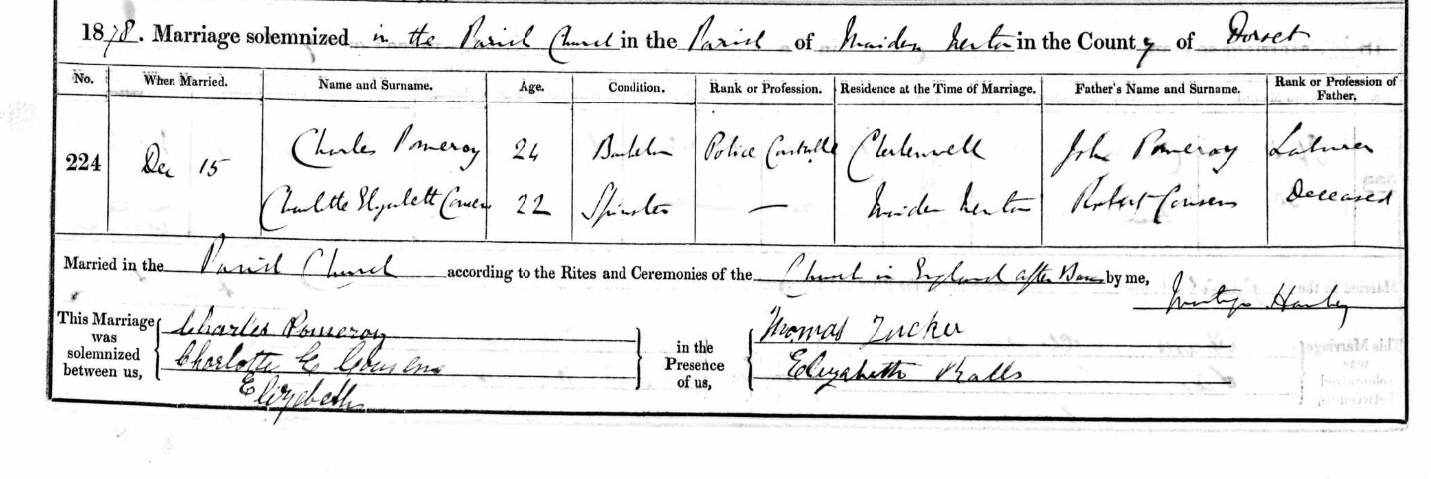
Lets look at each address in order.
29 John Street
29 John Street - 1878/1880 to 1882/1884
John Street was near Wilmington Square by reference to the nearby roads recorded in the Census. I believe it was demolished to enable the construction of Rosebery Avenue, planned by the Metropolitan Board of Works, but completed by London County Council.
Clearance of the route commenced in 1887, and the new street was opened in July 1892. The new street was named after Lord Rosebery, the first chairman of the London County Council
In the county of Middlesex at the time, and subsequently County of London in 1889. Now part of London Borough of Islington since 1965, part of Greater London.
Currently in the Ecclesiastical Parish of Clerkenwell: Holy Redeemer
Parliamentary borough of Finsbury, the parish of St James, Clerkenwell. Ward no. 2, St. Philip's
Parliamentary borough of Finsbury, Post 1885, in the Division of Finsbury Central, consisting of the parish of St James and St John, Clerkenwell. Ward no. 2, St. Philip's
Location

An extract of British Library Fire Insurance Plan of London North District Vol. D (Key C): sheet 3-1 with Wilmington Square circled, the possible location of John St. With John Street a casualty of the construction of Rosebery Avenue.
Registers of Voters
The Registers of Voters on Ancestry for St. James Clerkenwell are 1832, 1865, 1877, 1878, 1885, and 1889. Using the date range from above, 1878/1880 to 1882/1884, only 1877, 1878, and 1885 have any possibility of having a relevant entry, and of those 1877 and 1885 are both remote chances. As stated above 1877 register does not have any surnames of Pomeroy. The 1878 Register has and entry for 29 John Street, but not for Charles Pomeroy, instead, the first occupant of 29 John Street on the 1881 Census. The 1885 register could possibly have a residual entry, from 1884, but the name at 29 John Street is George Barnett, neither Charles Pomeroy nor John Thomas Hodges. In this instance the Registers have not helped place people but have helped with the location of the address.
Timeline
Move to 29 John Street - 1878/1880
1880 Charles 25 1/2 years of age
Baptism

After the marriage they went back to Clerkenwell, and soon had their first baby. Charlotte Mary, born on 15 March 1880, 1 year 3 months after their marriage. Charlotte Mary was baptised at the parish church St Peter Clerkenwell on 25 April 1880.
The family were living at 29 John Street, apparently not to be confused with nearby Saint John Street, nor John Street in Holburn.
It looks as if there was a St under the 29 in the register for St John Street, but the St has been crossed through. It could have been a mistake by the writer of the record as St John St is in Clerkenwell near the church as opposed to John St near Wilmington Square.
1881 Charles 26 1/2 years of age
Census

It is April 3rd, 1881, and another decade has passed since the last census had Charles Pomeroy living in the Parish of Compton Valence, Dorset. A lot has happened since then. Moving to London, becoming a Policeman, getting married and having and losing a little girl. The Census confirms Charles and Charlotte Pomeroy living at 29 John Street with another family. A multiple occupancy house is not a surprise.
Later in 1881 Charles and Charlotte had another baby, this time a boy. I have not found any Pomeroy's Baptised in Saint Peter's Church in 1881. The Civil Registration Birth Index has Charles Henry Pomeroy born in Quarter 3 of 1881 and registered in Holborn. He died in the same Quarter according to the Register of Deaths Index.
1882 Charles 27 years of age
Baptism
Another child is born in 1882 and the register is clear and unambiguous this time, still living at 29 John Street.
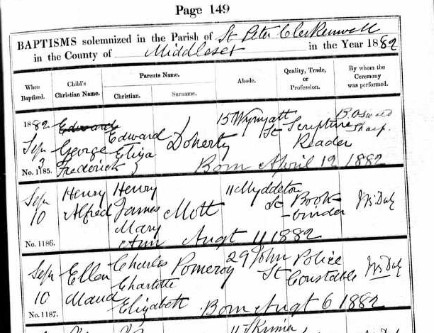
Ellen Maud Pomeroy born to Charles and Charlotte Elizabeth Pomeroy on 6th August 1882 and Baptised on 10th September 1882 in the Parish Church of St Peter, Clerkenwell, which was Middlesex the but would now be considered Islington, London.
Move out of 29 John Street 1882/1884
1885 Charles 30 years of age
1885 Register of Voters

This page is for 1885, after Charles Pomeroy and family had moved to 20 Torrens Buildings. However, I have found the address 29 John Street in Ward no. 2, St. Philip's. It is occupied by George Barnett in the 1885 Register. Now that I know which Ward to look at, I will go back to the 1878 register to find who was the eligible voter register for 29 John Street. The Ward also has Wilmington Place, Wilmington Square, Tysoe Street, and Yardley Street, all expected roads in the vicinity of John Street as evidenced by the 1881 Census.
Date of first confirmed record at 29 John Street 25th April 1880. Date of last record, 10th September 1882. (1882 carried forward)
20 Torrens Buildings
20 Torrens Buildings, Torrens Street, Islington - 1882/1884 to 1887/1889
20 Torrens Buildings, Torrens Street, Angel, Islington, London
In the county of Middlesex at the time, and subsequently County of London in 1889. Now part of London Borough of Islington since 1965, part of Greater London.
Currently in the Ecclesiastical Parish of St James Prebend Street.
In 1887 Register of Electors for Islington, St Mary, Islington, Ward no. 3 St. Peter's Polling District, corresponding to the St. Peter's Ward of the Parish of St. Mary Islington.
Entries found for 20 Torrens Buildings found in 1891 Register of Electors for Islington, Islington South, Ward no. 3 St. Peter's Polling District.
Location
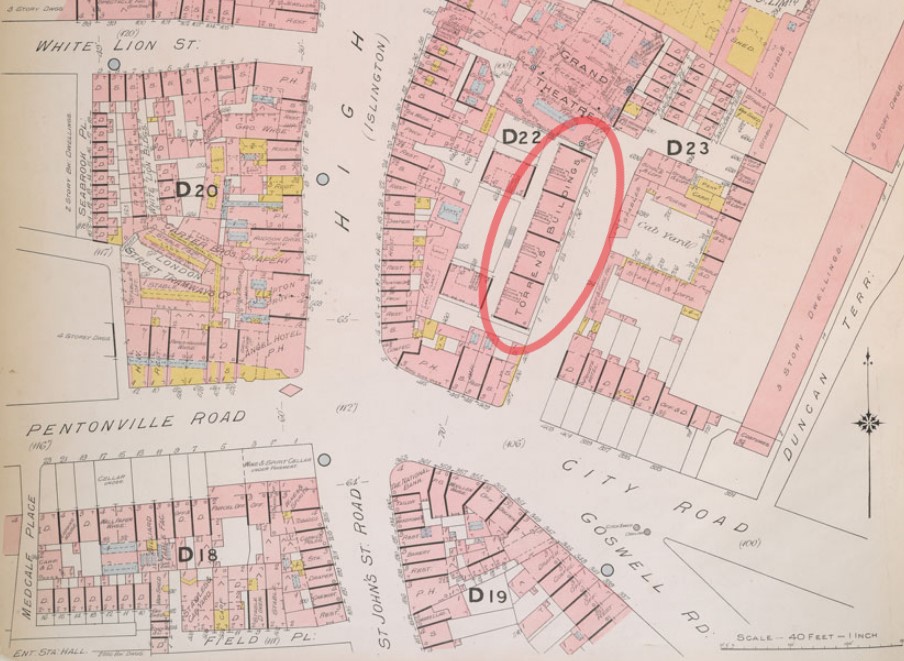 Torren Buildings in Torren Street circled in red, in an extract of Insurance Plan of London North North West District Vol. D: sheet 20
Torren Buildings in Torren Street circled in red, in an extract of Insurance Plan of London North North West District Vol. D: sheet 20
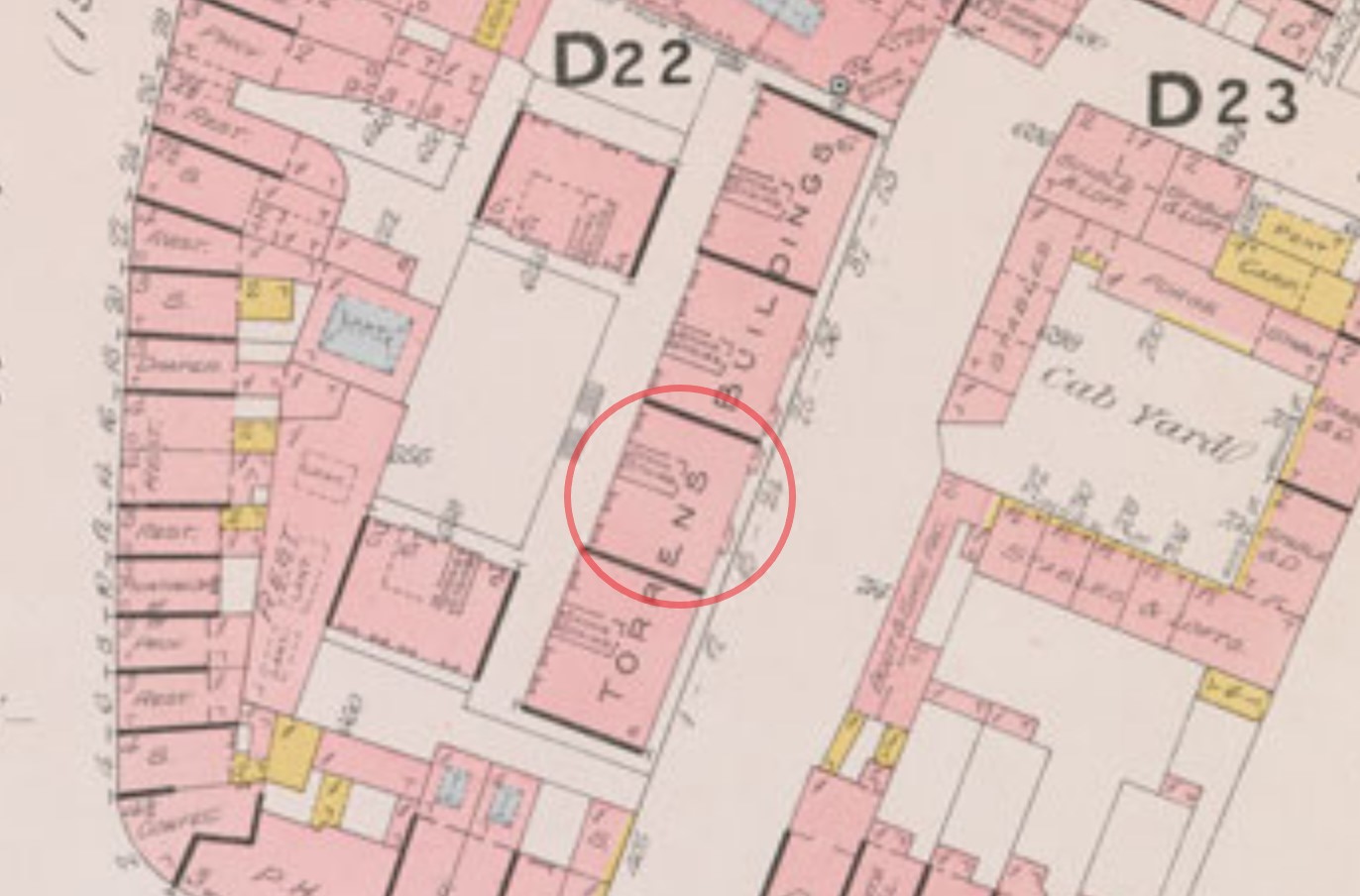
Torren Buildings, Block 13 - 24
Register of Voters
From above the potential period of appearing in the Register of Voters at this address could be 1882/1884 to 1887/1889.
1885 Register of Electors for Islington, South Division, Ward no. 3 St. Peter's Polling District
1887 Register of Electors for Islington, St Mary, Islington, Ward no. 3 St. Peter's Polling District
The Register of Electors for Islington, Islington South, Ward no. 3 St. Peter's Polling District begins in 1891 and continues for each year until 1915.
Timeline
Move to 20 Torrens Buildings, Torrens Street, Islington 1882/1884
1884 Charles 29 years of age
Baptism

Charles and Charlotte had moved to 20 or 26 Torrens Buildings, Islington.
Torrens Buildings are not surprisingly on Torrens Street.
1885 Charles 30 years of age
1885 Register of Voters

1885 Register of Electors for Islington, South Division, Ward no. 3 St. Peter's Polling District, Charles Pomeroy at 20 Torrens Buildings, Torrens Street.
1887 Charles 32 years of age
1887 Register of Voters

Charles Pomeroy entitled to vote due to occupation of a dwelling house, 20 Torrens Buildings, Torrens Street, in the 1887 Register of Electors for Islington, St Mary, Islington, Ward no. 3 St. Peter's Polling District.
Baptism

Baptised in the Parish Church of St Peter's Clerkenwell in the County of Middlesex on the 6th February 1887 Edward Pomeroy, born to Charles and Charlotte Elizabeth Pomeroy on 15th December 1886, of 20 Torrens Buildings.
Move out of 20 Torrens Buildings, Torrens Street, Islington 1887/1889
1891 Charles 36 years of age
1891 Register of Electors
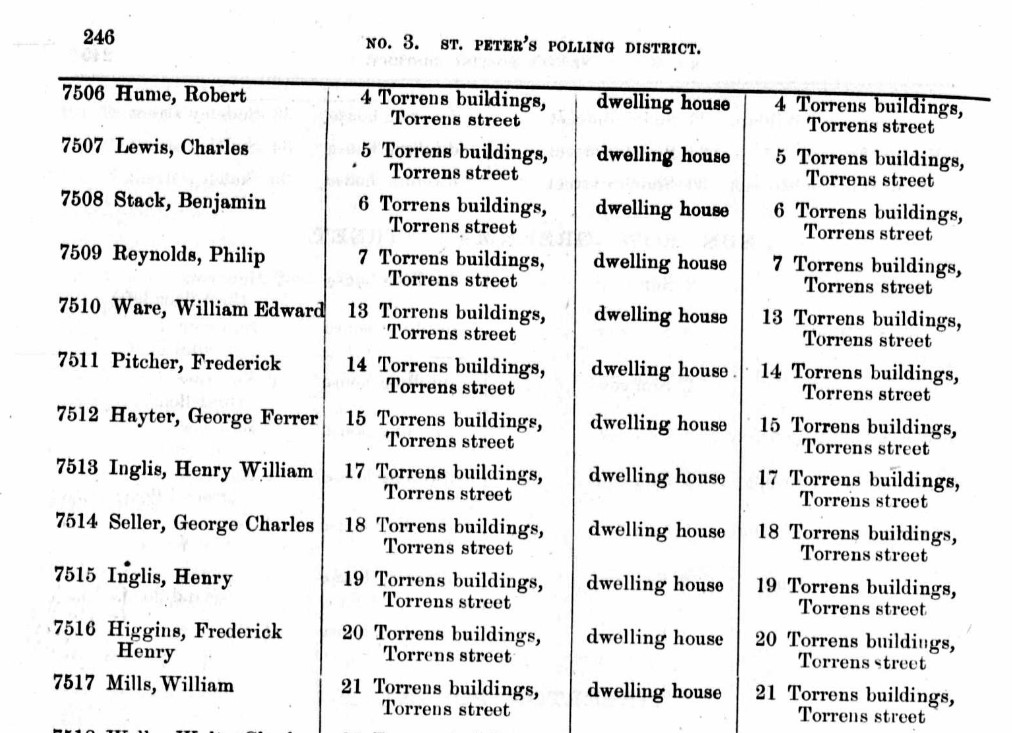
In the 1891 Register of Electors for Torrens Buildings, number 20 was occupied by Fredrick Henry Higgins. Charles Pomeroy had moved to 104 Saint John Street by 1891.
Date of first confirmed record at 20 Torrens Buildings 2nd November 1884. Date of last record, 6th Febuary 1887. (1887 carried forward)
104 Saint John Street
104 Saint John Street, Clerkenwell - 1887/1889 to 1889/1891
Also known as 104 St John Street, Farringdon, London
In the county of Middlesex at the time, and subsequently County of London in 1889. Now part of London Borough of Islington since 1965, part of Greater London.
Currently in the Ecclesiastical Parish of St James Clerkenwell
Parliamentary Borough of Finsbury, Central Division, Clerkenwell Polling District, Ward no.5 St. John.
Location
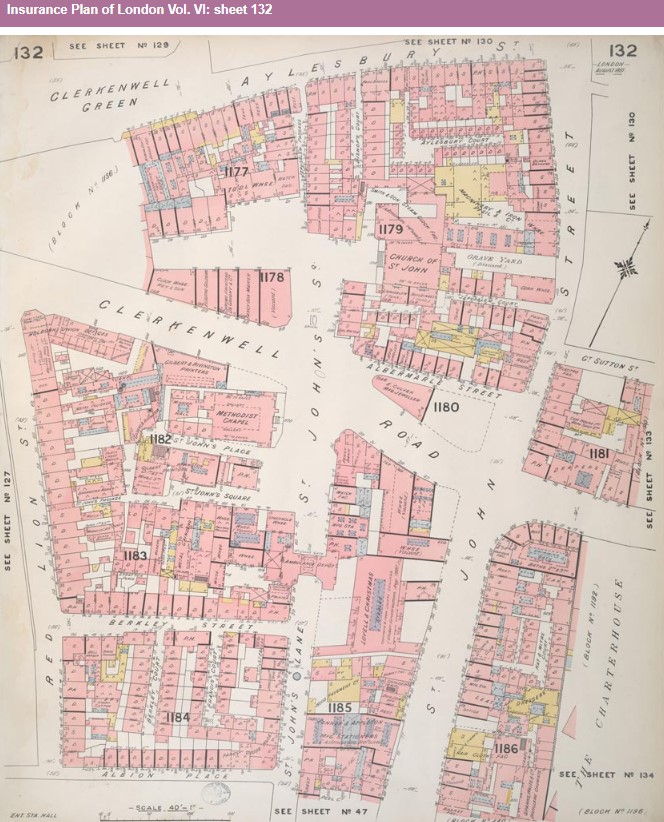

Register of Voters
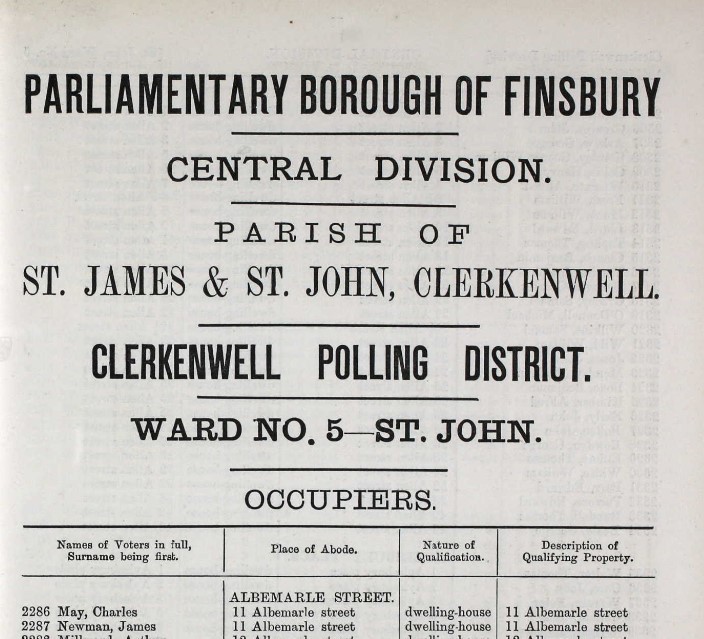

Two entries for 104 St. John Street at the bottom of page 77, but not a third at the top of page 78, instead number 102. From the Register of Voters 1888, Parliamentary Borough of Finsbury, Central Division, Clerkenwell Polling District, Ward no.5 St. John. The layout of the Register is now Address orientated wheres previously it was people focused. Occupied by Frederick Vulliamy as one entry and Richard Giles as another.
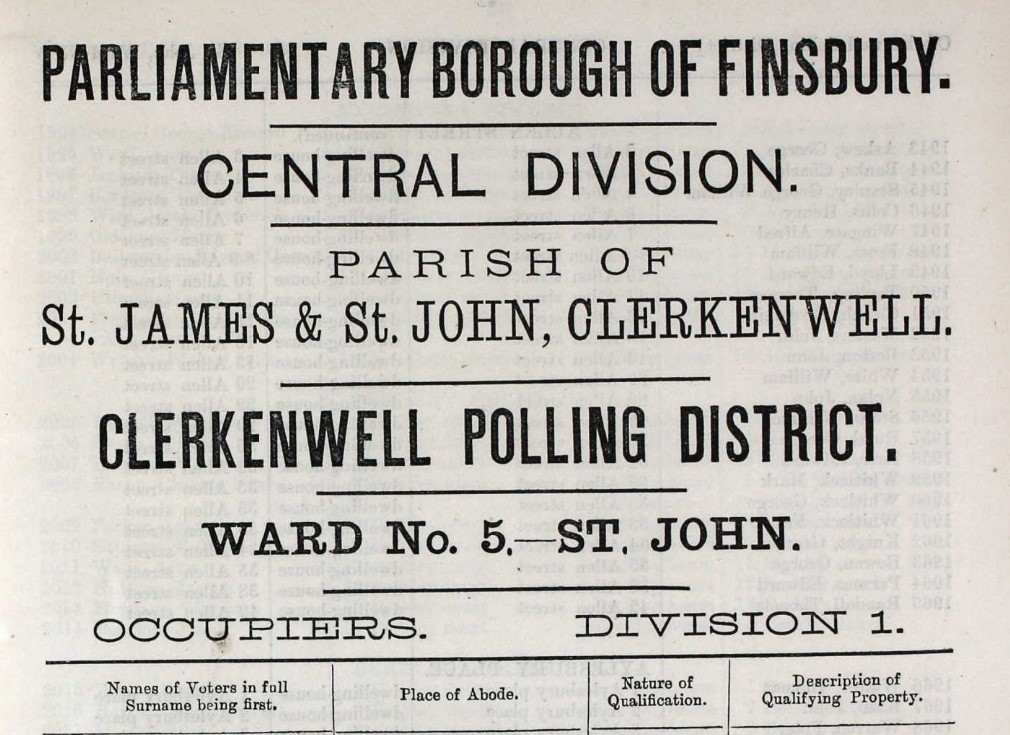
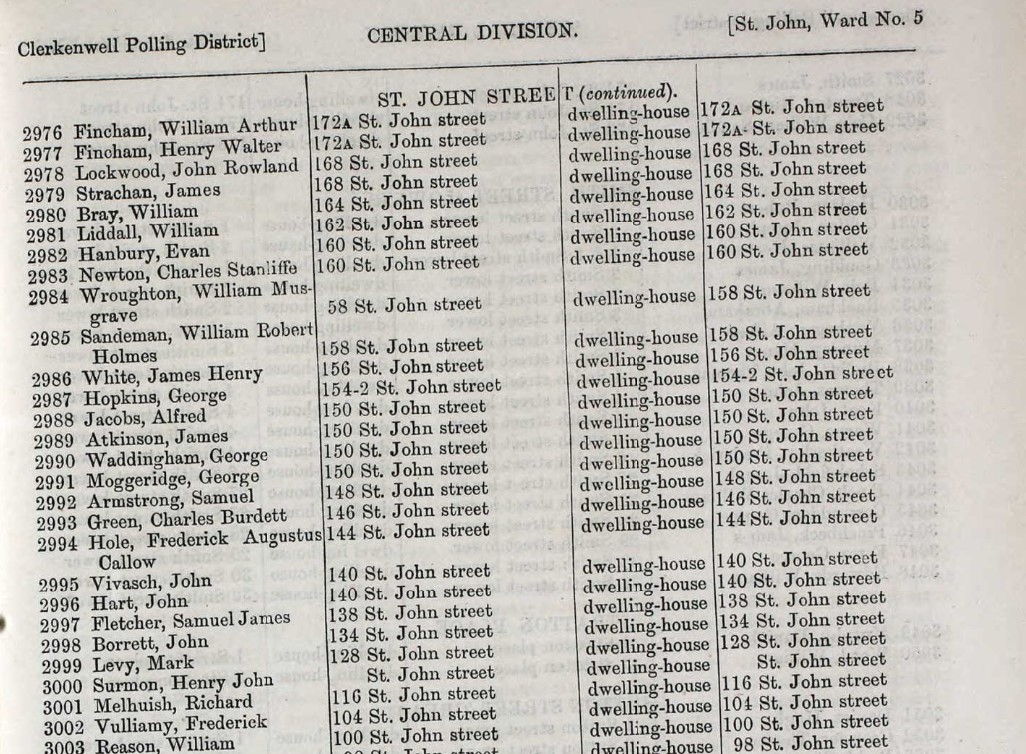
From the 1889 Register of Electors, for Finsbury, Central Division, St James and St. John Clerkenwell, Ward no. 5, St. John. The address of interest is 104 St. John Street. It is towards the bottom of the shown list, and is Occupied by Frederick Vulliamy, as it was in 1888.
Timeline
Move to 104 Saint John Street, Clerkenwell - 1887/1889
1889 Charles 34 years of age
Baptism
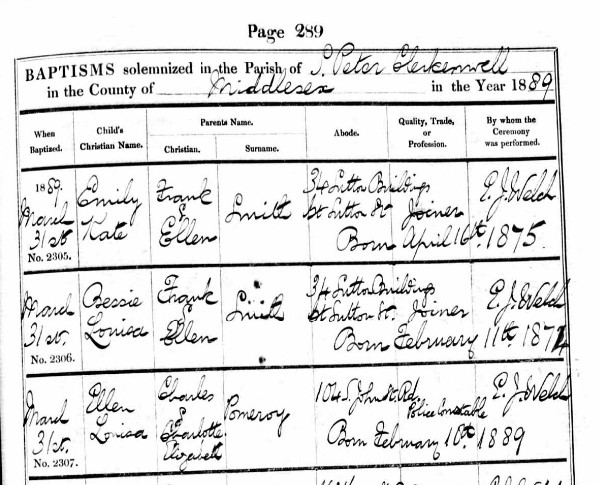
On 18th February 1889 Ellen Louisa Pomeroy was born to Charles and Charlotte Elizabeth Pomeroy.
Ellen Louisa Pomeroy was Baptised at the Parish Church of St Peter's Clerkenwell in the County of Middlesex on the 31st March 1889.
They have moved again, this time to 104 St John St, on the junction with Clerkenwell Road.
However, they did not stay there very long.
Move out of 104 Saint John Street, Clerkenwell 1889/1891
Date of first confirmed record at 104 Saint John Street 31st March 1889. Date of last record, 31st March 1889. (1889 carried forward)
18 Palmerston Buildings
18 Palmerston Buildings, City Garden Row - 1889/1891 to 1892/1893
City Garden Row, City Road, Angel, Islington, Middlesex.
In the county of Middlesex at the time, and subsequently County of London in 1889. Now part of London Borough of Islington since 1965, part of Greater London.
Currently in the Ecclesiastical Parish of St James Prebend Street.
In 1889, Parliamentary Borough of Finsbury, East District, North Polling District, Parish of St. Luke, Middlesex, Ward No. 1 City Road West
Islington, Islington South, Ward no. 3 St. Peter's Polling District.
Location
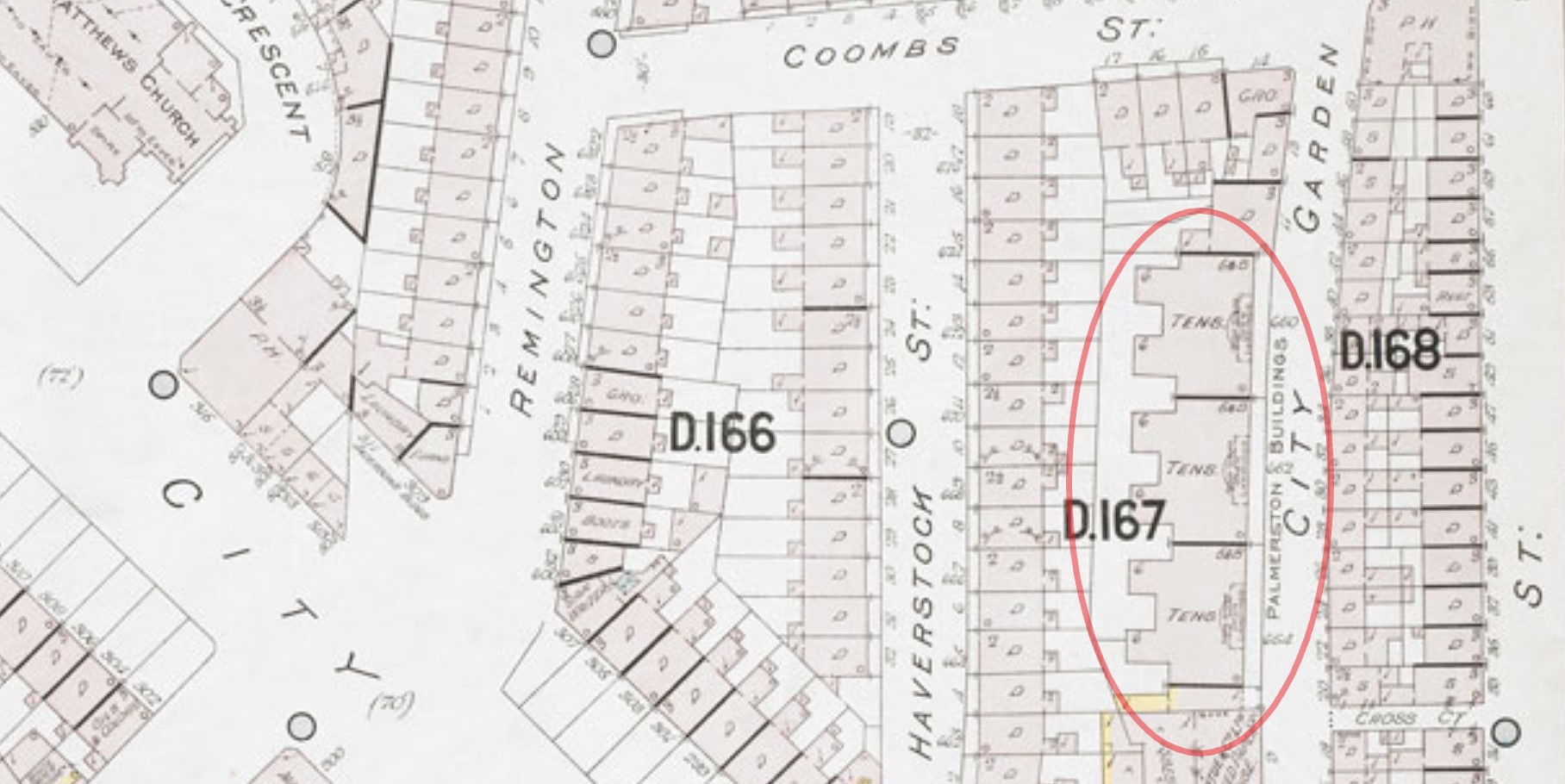
Register of Voters
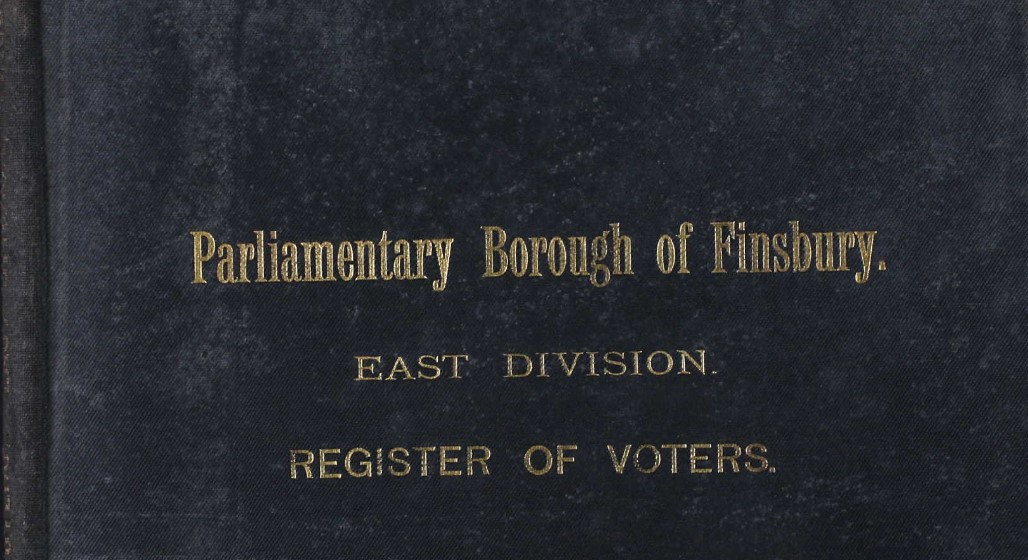
The front cover of one of the Register of Voters books.
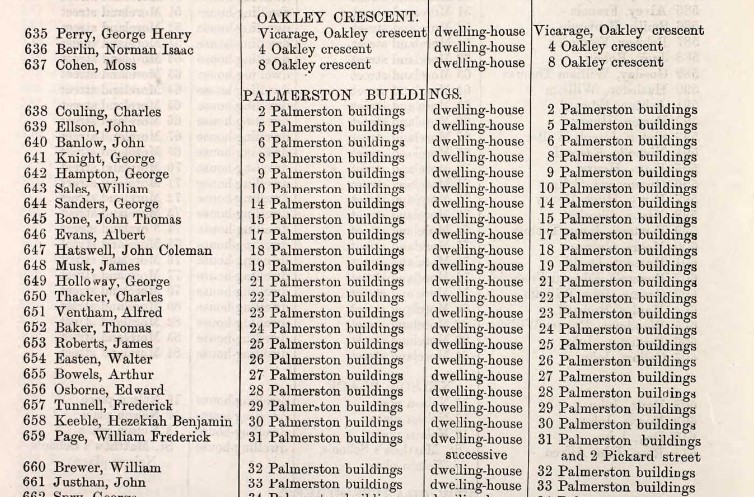
1887 Parliamentary Borough of Finsbury, East District, North Polling District, Parish of St. Luke, Middlesex, Ward No. 1 City Road West. Not expecting to find Charles Pomeroy at number 18 and instead find John Coleman Hatswell, but the interesting part of this record is that Palmerston Buildings is found under P, after O, Oakley Crescent. The next year, below, Palmerston Buildings are under City Garden Row.

1888 and still John Coleman Hatswell at 18 Palmerston Buildings.
Timeline
Move to 18 Palmerston Buildings, City Garden Row 1889/1891
1889 Charles 34 years of age
1889 Register of Voters

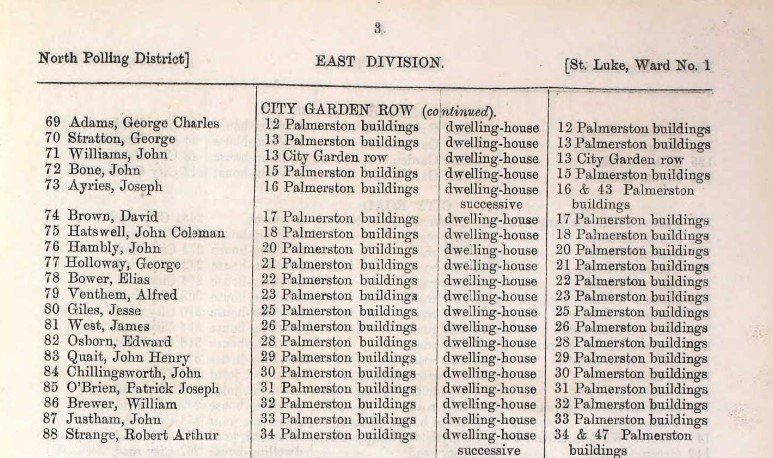
This identifies the correct address of 18 Palmerston Buildings in City Garden Row, which was occupied by John Coleman Hatswell in 1888, when the register for 1889 was prepared. His name in three consecutive Registers of Voters.
1891 Charles 36 years of age
Baptism
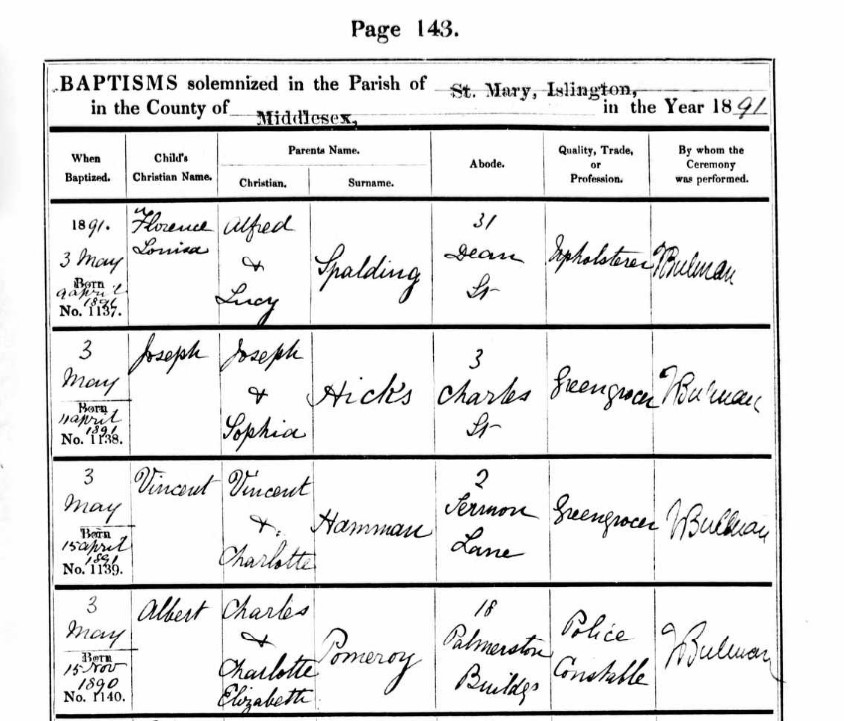 1 year 8 months 28 days after the birth of Ellen Louisa Pomeroy born along comes another child, Albert Pomeroy, born 15th November 1890 and baptised the next year on 3rd May 1891. This time the church changed, to St Mary, Islington in the county of Middlesex.
1 year 8 months 28 days after the birth of Ellen Louisa Pomeroy born along comes another child, Albert Pomeroy, born 15th November 1890 and baptised the next year on 3rd May 1891. This time the church changed, to St Mary, Islington in the county of Middlesex.
A new church and a new address, 18 Palmerston Buildings, which was in City Garden Row, City Road, Angel, Islington, Middlesex.
1891 Charles 36 years of age
Census

In the 1891 Census taken on the 5th April, Charles and Charlotte Pomeroy were living in 18 Palmerston Buildings, City Gardens Row, in the parish of St Matthews, civil parish of St Luke. He was a Police Constable aged 36. Charlotte was aged 34. They have aged by ten years since the last census as expected.
They have three unmarried/single sons living with them.
William H aged 6 born Islington
Edward aged 4 born Islington and
Albert aged 4 months born St Luke
These names and ages correlate with the baptism records above. Three surviving children and another 4 who died in infancy.
Again a lot has happened in the decade between the Census
1892 Charles 37 years of age
1892 Register of Voters
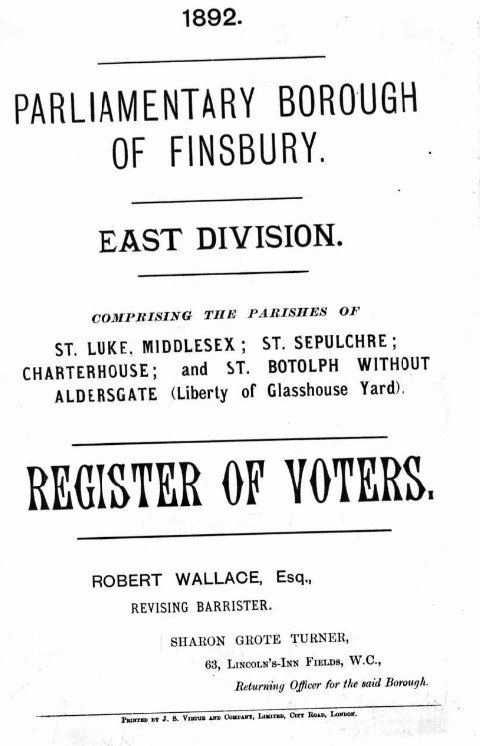
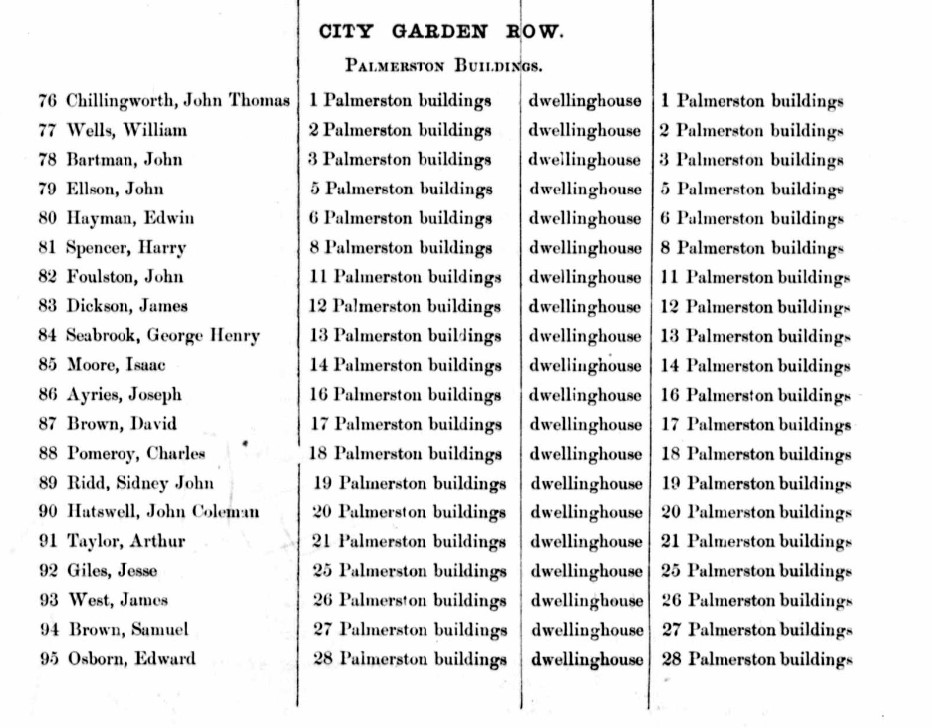
Success, 18 Palmerston Buildings, in City Garden Row, in the Parish of St. Luke, has a voter registered by the name of Charles Pomeroy. This is in 1892. In similar lists for 1890 and 1891, both had no entry for either 18 or 19 Palmerston Buildings. This may be the only occurrence as in the Register for 1893, again numbers 18 and 19 are absent. I searched the register for 1893 in Voter Divisons 2, 3, and Lodgers for the same ward, and again found no entries for 18 and 19. The same result for 1891 and for 1890. There are a few entries in those voter divisions for City Garden Row, and sometimes for Palmerston Buildings, but not for numbers 18 and 19. 1890 is the first available year of records in Ancestry for Finsbury East. Before that date the records are in Finsbury - East Division.
Move out of 18 Palmerston Buildings, City Garden Row 1892/1893
1894 Charles 39 years of age
1894 Register of Voters

Numbers 18 and 19 Palmerston Buildings make a reappearance in the 1894 Register, but are occupied by Alfred Heel and John Louis Stocker respectively. Again, not a surprise as Charles Pomeroy had moved to Teddington.
Of general interest, pertaining to Palmerston Buildings, a 'Report on the sanitary condition, vital statistics, &c., of the Parish of St. Luke, Middlesex for the year 1894.'
Date of first confirmed record at 104 Saint John Street 3rd May 1891. Date of last record, 1st January 1892. (1892 carried forward)
Time to move on to Teddington, but not before a quick look at Hammersmith
Clerkenwell
Fielded by Euston Station, British Library, St Pancras and King's Cross Stations in upper left and the River Thames at the bottom, the location of the four homes of Charles and Charlotte Elizabeth Pomeroy, in and around the Clerkenwell area on a Bing Aerial Map. Click the map to open in a new tab.
Hammersmith
Metropolitan Police

I have not yet found out when Charles Pomeroy transferred out of G Division but as hie retirement papers are drawn up in Hammersmith Division. From page 2 of the retirement papers, he is married to Charlotte Pomeroy and lives at 6 Beaconsfield Villas, Fulwell Road, Teddington, Middlesex, in May 1903.
His last firm record in the Clerkenwell section is in the 1892 Register of Voters.
Location
Starting with an Ordnance Survey First Series map from 'A Vision of Britain Through Time'.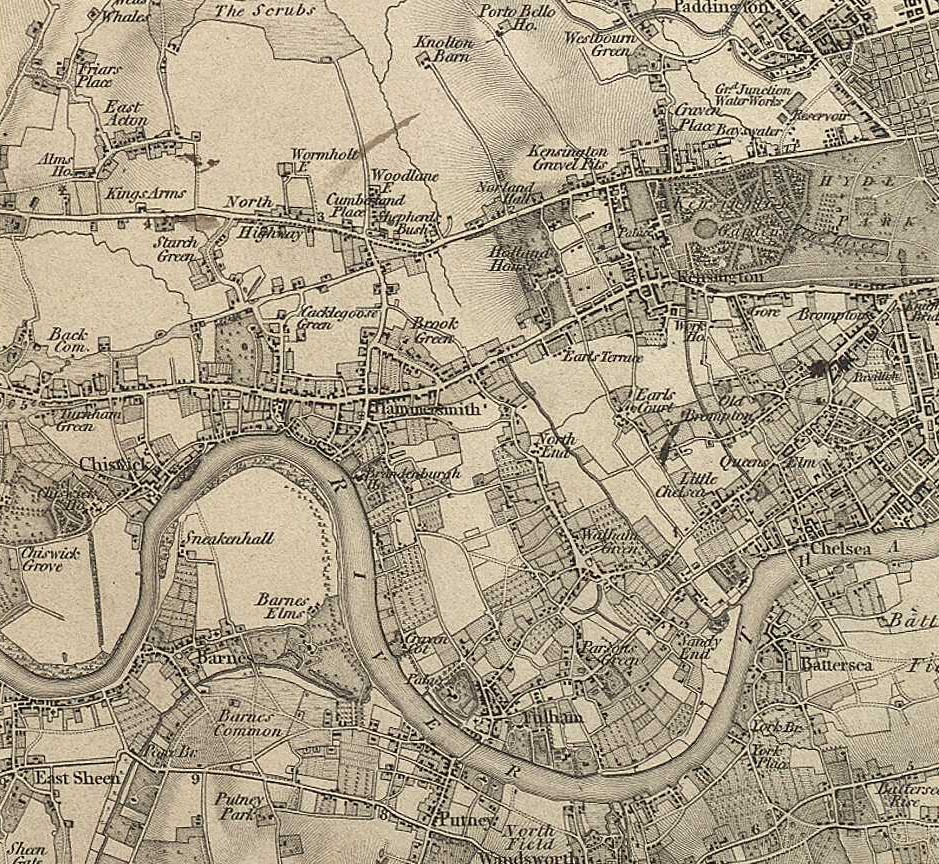
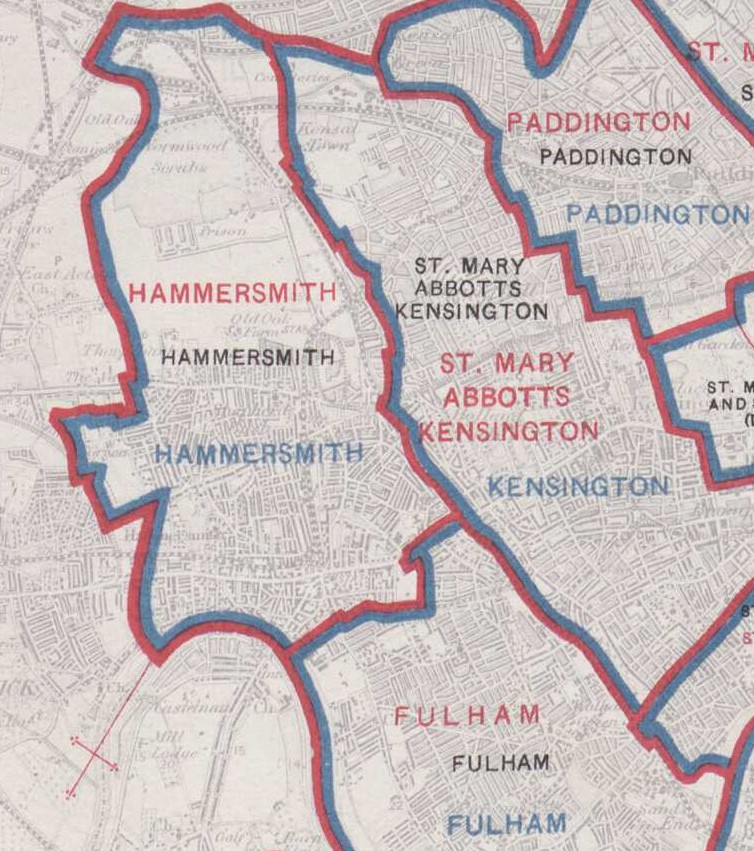
An extract of a boundary Map of Hammersmith 1900.
Mansion House Street lies between King Street, with the Tramway, and Glenthorne Road, to the North. Latterly called Leamore Street.
The photo is from Google Streetview of 16 Leamore Street. If the street numbering did not change with the street name, this could have been 16 Mansion House Street. Click on the photo to go to Google Maps.

Approximate extent of The Grove Ward, Hammersmith based on locating and colour washing the roads listed in the Register of Voters for that Ward, 1901. Mansion House Street highlighted.
Register of Voters
Moving on from the location, to evidence of occupation at a particular location.
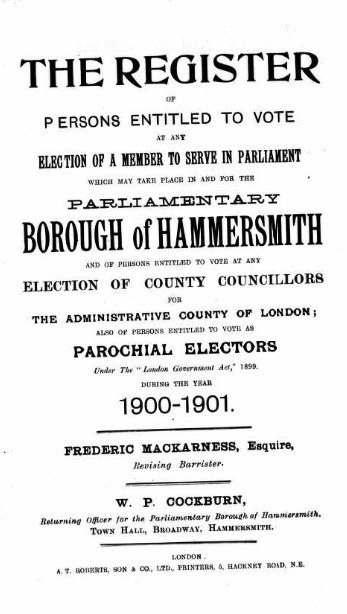
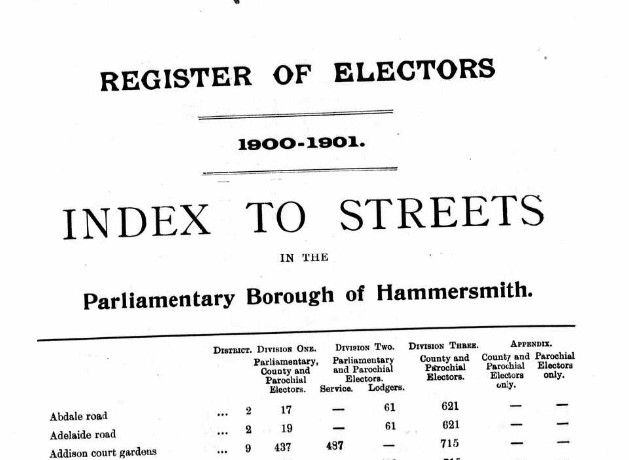
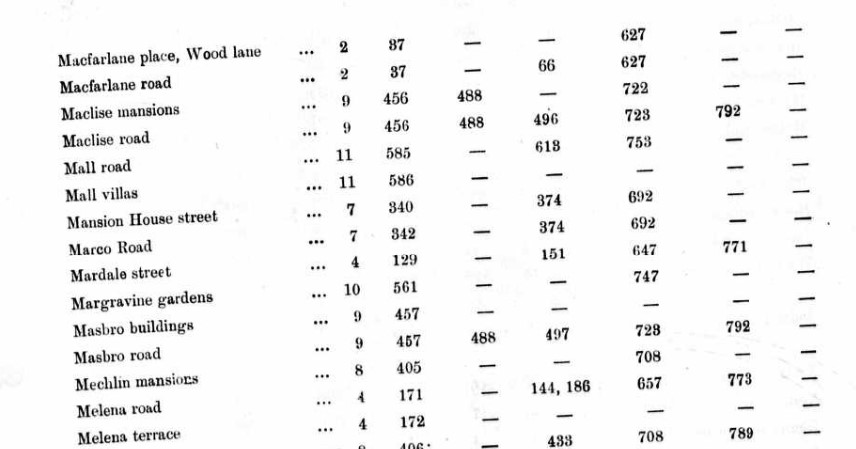
It has definitely been easier finding data for Hammersmith than Clerkenwell. Firstly, I found the reference to Charles Pomeroy on a general search in FindmyPast. That led me to The Grove Ward and Mansion House Street. A search on Google Maps did not reveal a street map of that name, but National Library of Scotland Maps, Ordinance Survey 25" Map did reveal its position. The Hammersmith book of Register of Voters has a a Street Index, which indicates that Mansion House Street is in District 7, and that the main section, Division 1 voters, commences on page 340.
Clerkenwell was complicated by a number of Boundary changes and name changes. Hammersmith around 1900 does not suffer the same problem.
1901 Register of Voters
Following on from the list of potential records I found in FindmyPast, I located the 1901 record on Ancestry. FindmyPast takes you to the image of the record in the same way that Ancestry does, but Ancestry allows the navigation through the whole of what was once a microfilm. It could be that you can do that on FindmyPast, but I have not explored to find out how. Being able to scan along allows me to find front cover and header pages, and the information therein, as above.
A bonus, a record for a Richard Henry Pomeroy in Mansion House Street, as well as a Charles Pomeroy.
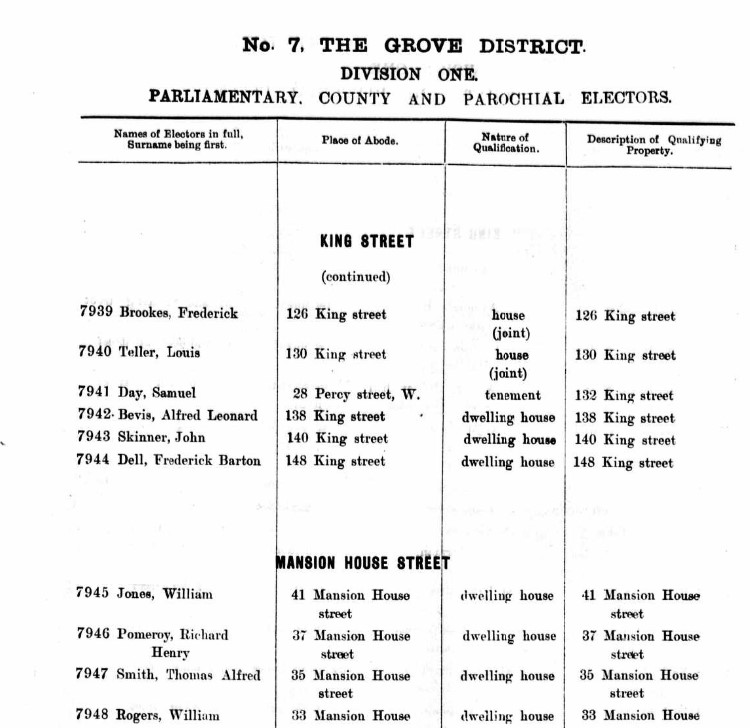
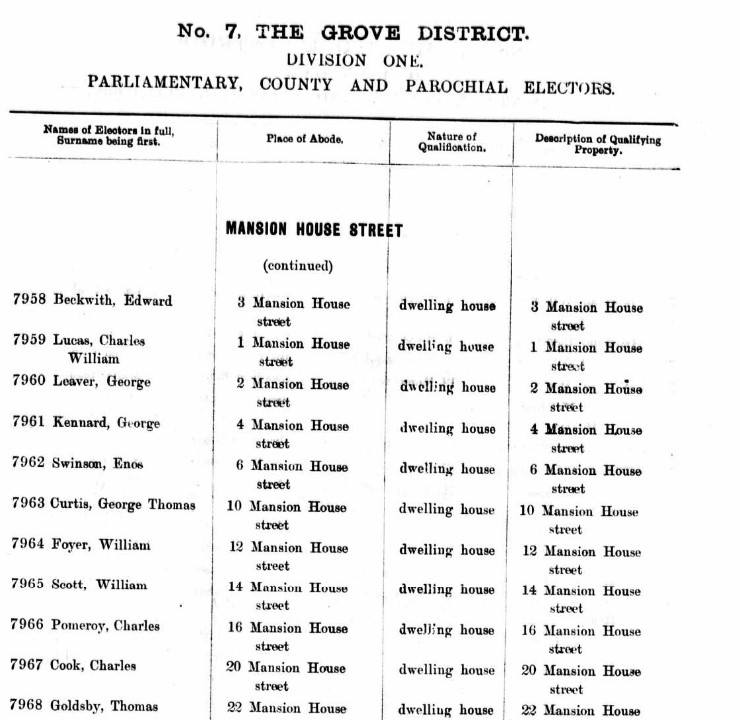
Now we have established an entry for Charles Pomeroy at 16 Mansion House Street, we need to track back in time to find out how long he has been registered there.
Starting with 1890. In fact worked back to 1890, but it is easier to read 1890 onward.
1890 Register of Voters
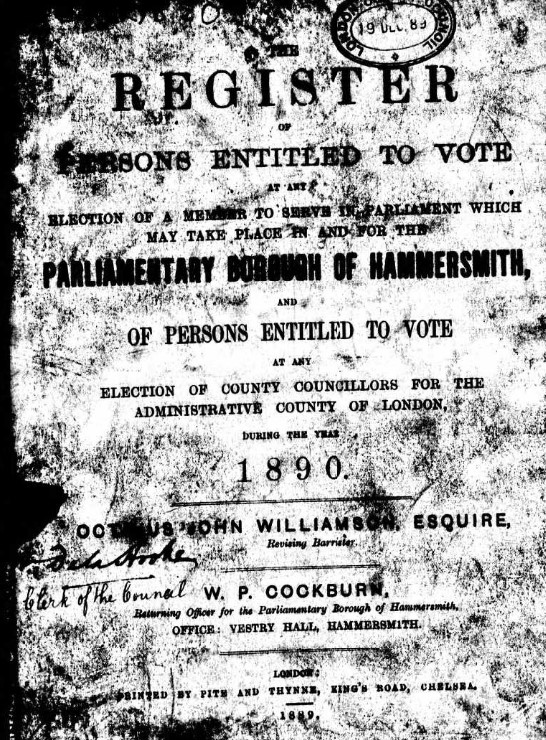
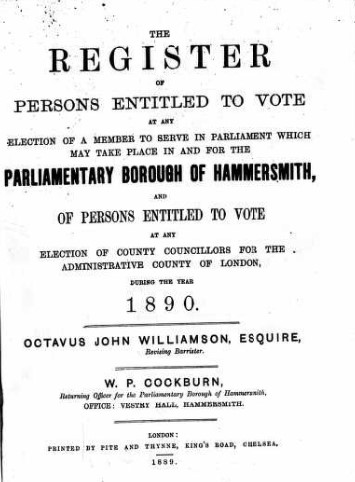
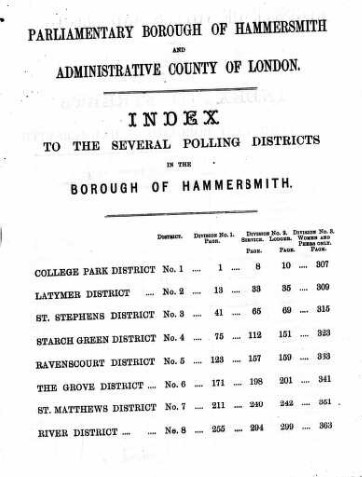
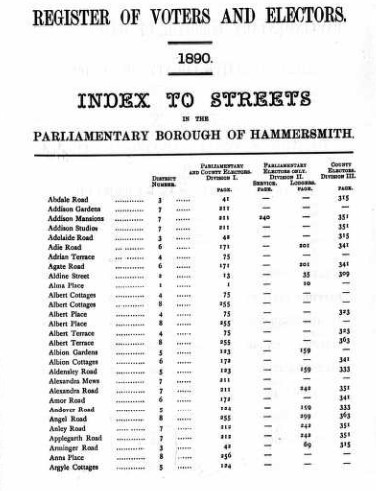

Time for a rethink. Coming backwards, I had thought that the reason the Even numbers on Mansion House Street were missing was that only one side of the street had been built. No, that is not the reason, they are in different Wards. With the absence of the even numbers there was also an absence of Charles Pomeroy.
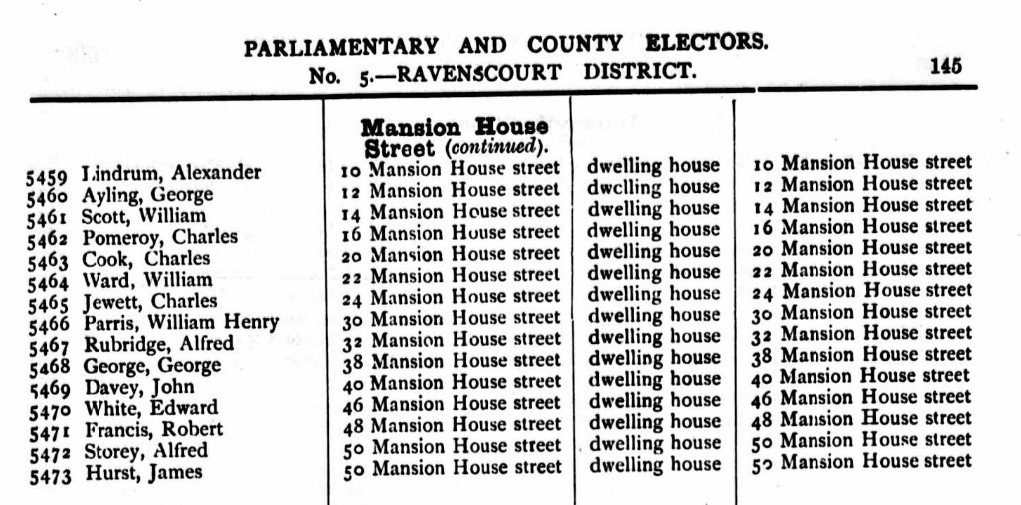
There is Charles Pomeroy at 16 Mansion House street in the 1890 Register of Voters. To avoid you having to read the next records until 1901, let us think about dates. To be in the 1890 register, Charles Pomeroy was in Hammersmith in 1889. Our Charles Pomeroy was living at 18 Palmerston Buildings in the 1891 Census entry, and was in the 1892 Registers of Voters for Parliamentary Borough of Finsbury, East District, North Polling District, Parish of St. Luke, Middlesex, Ward No. 1 City Road West, at number 18 Palmerston Buildings. He was therefore there for the period up to 1891. It is very improbable that our Charles Pomeroy was both at 18 Palmerston Buildings and 16 Mansion House at one and the same time. I therefore conclude that the Charles Pomeroy of 16 Mansion House is a different person.
Ward 5, Ravenscourt District.
I have done the research, so I will continue posting it here.
There are also records for a Richard Henry Pomeroy, also of Mansion House Street. No known connection but reproduced here for completeness.

Ward 6 - Thr Grove District.

Another interesting find, also in Ward 6 - Thr Grove District., a collection of Police Cottages in Brook Green, which is outside the 1901 version of the Ward.
1891 Register of Voters
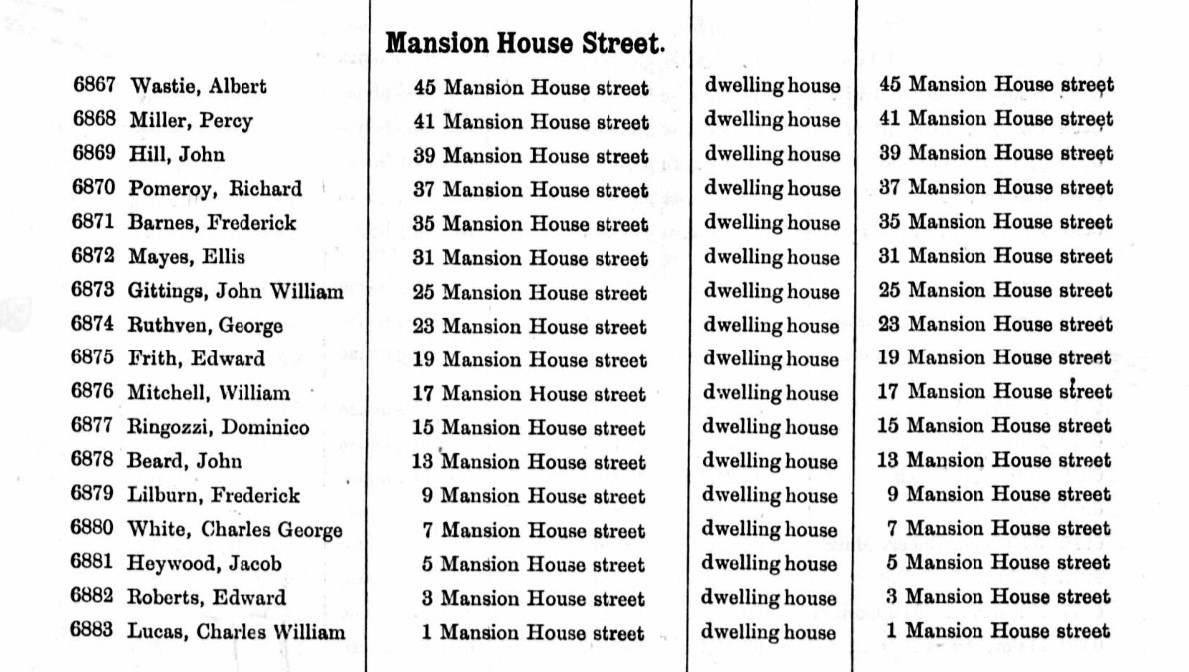

1892 Register of Voters
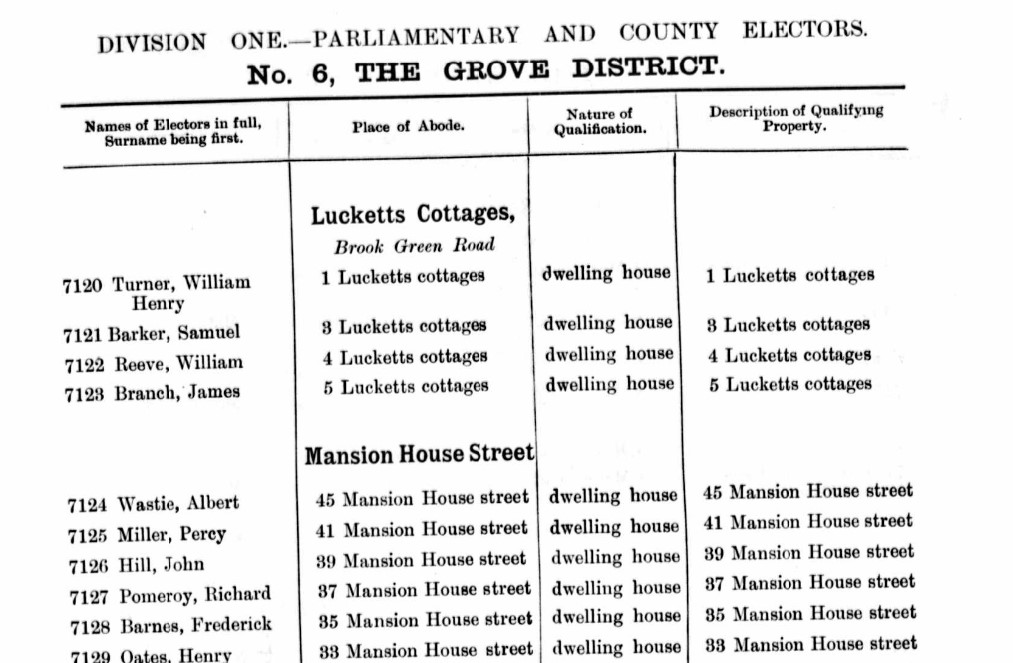
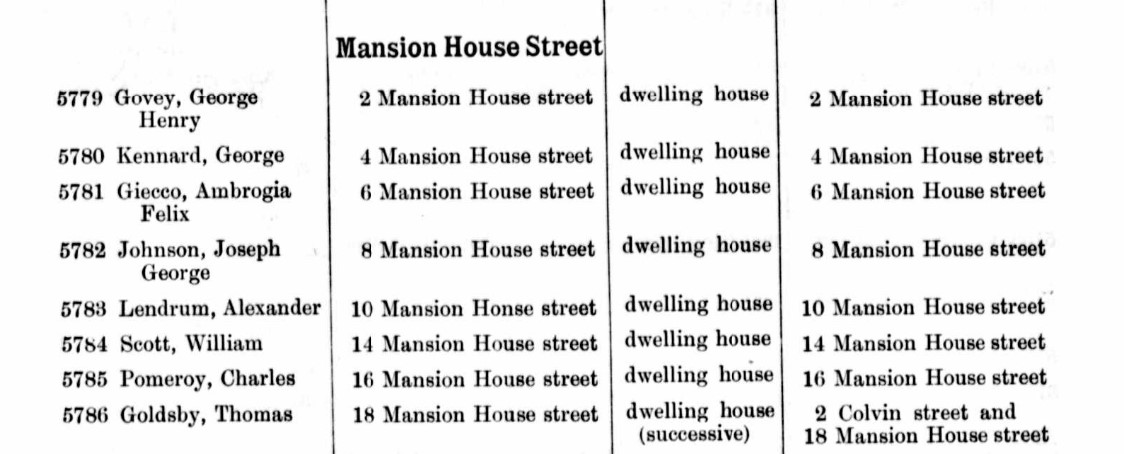
1893 Register of Voters
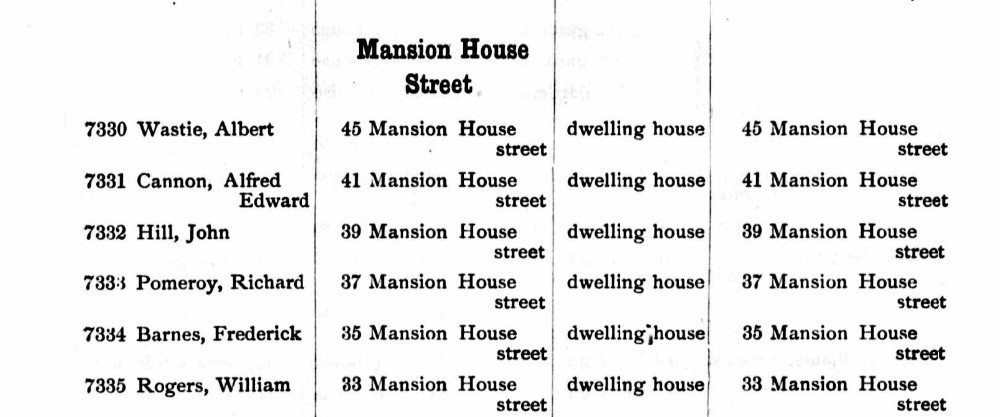

1894 Register of Voters
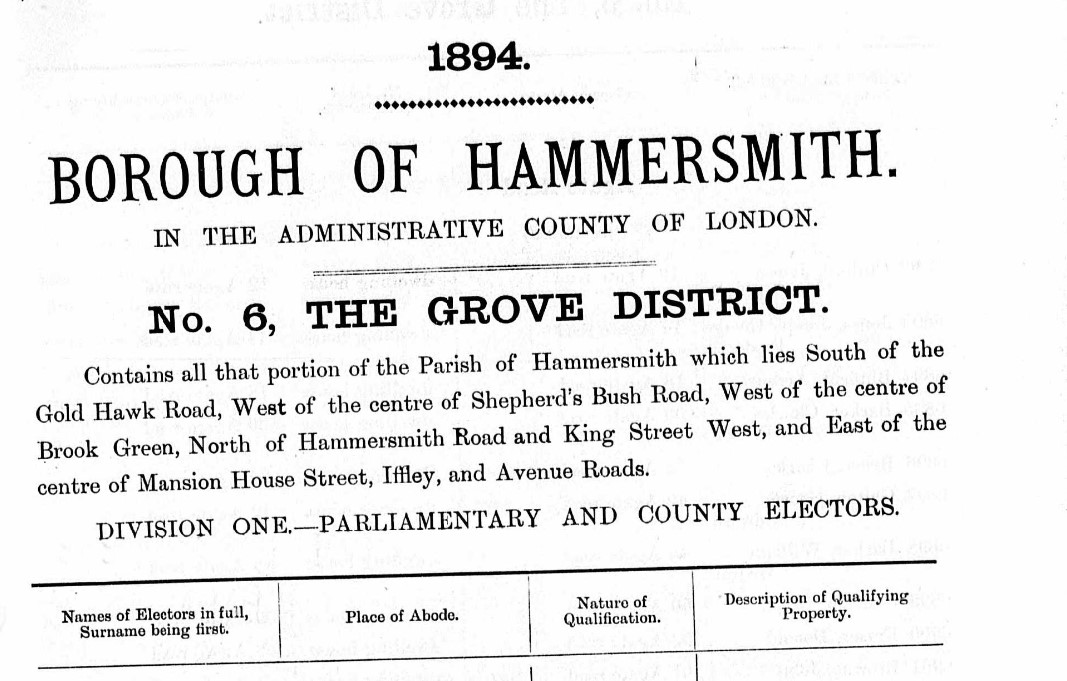
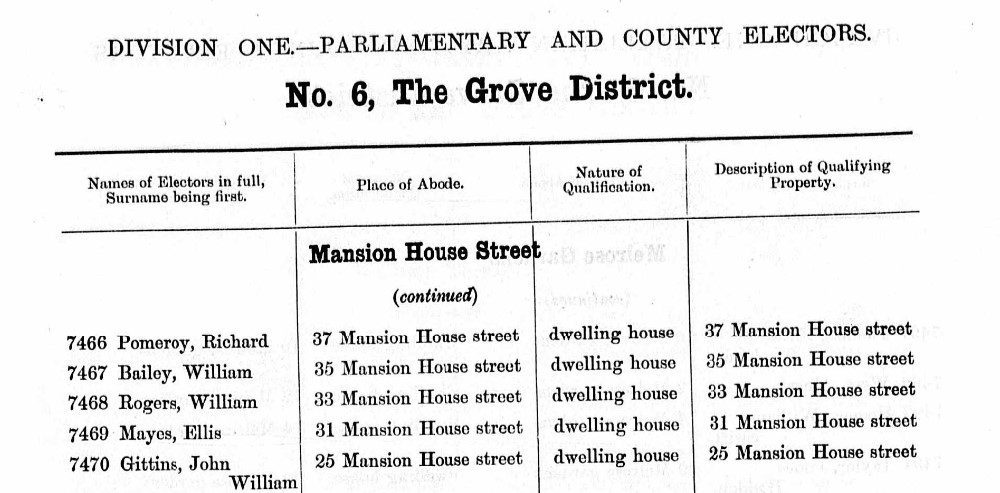
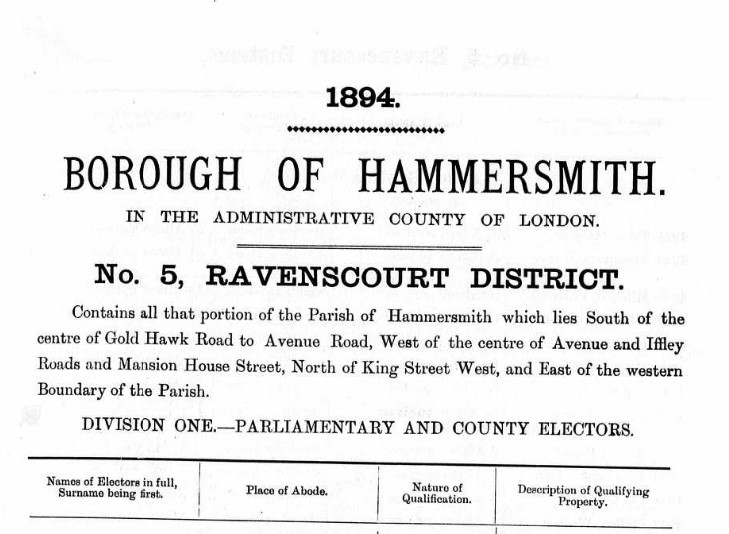

1895 Register of Voters


From this year the odd and even numbers of Mansion House Street are both in the same Ward, Number 7 The Grove.
1896 Register of Voters
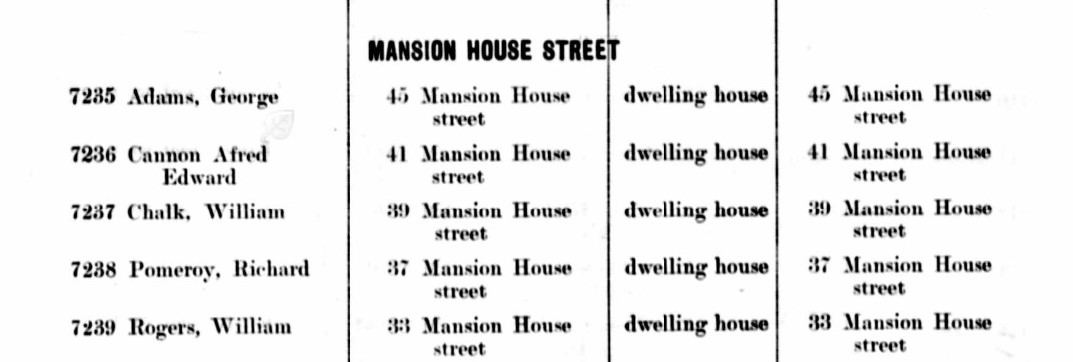
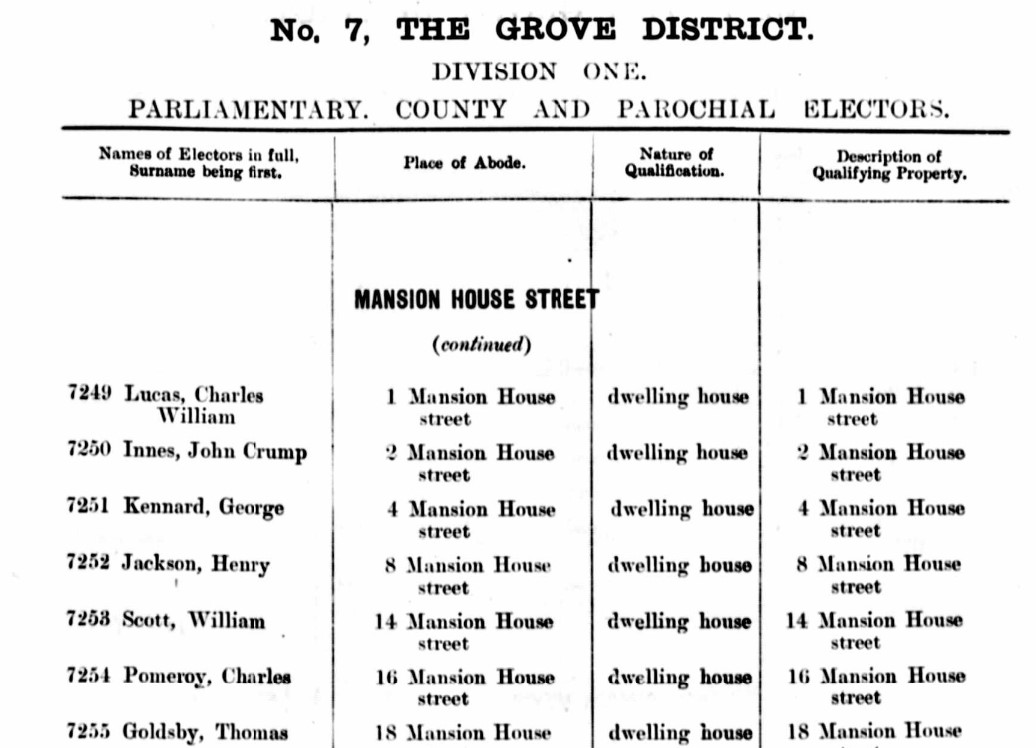
1897 Register of Voters
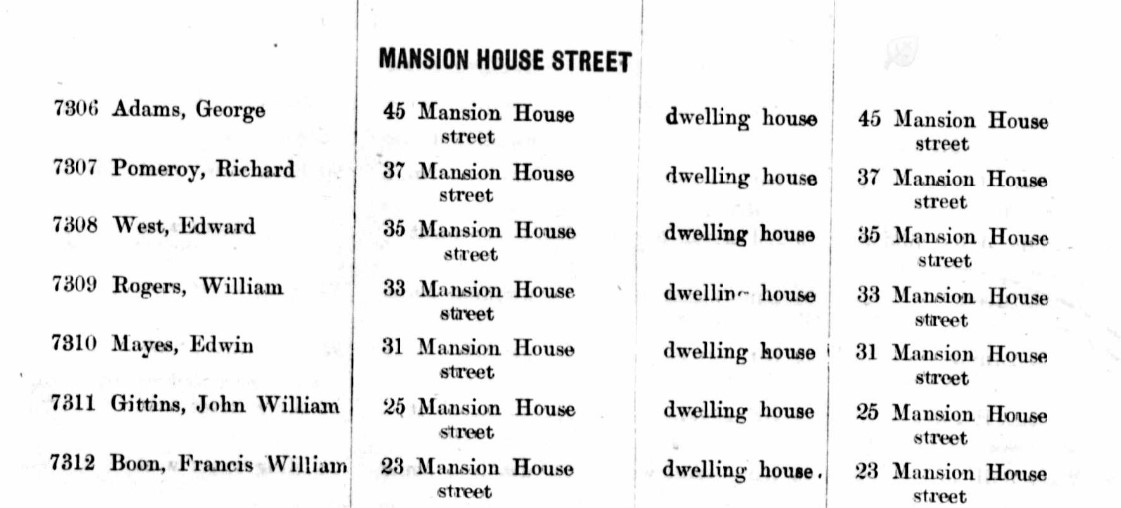

1898 Register of Voters
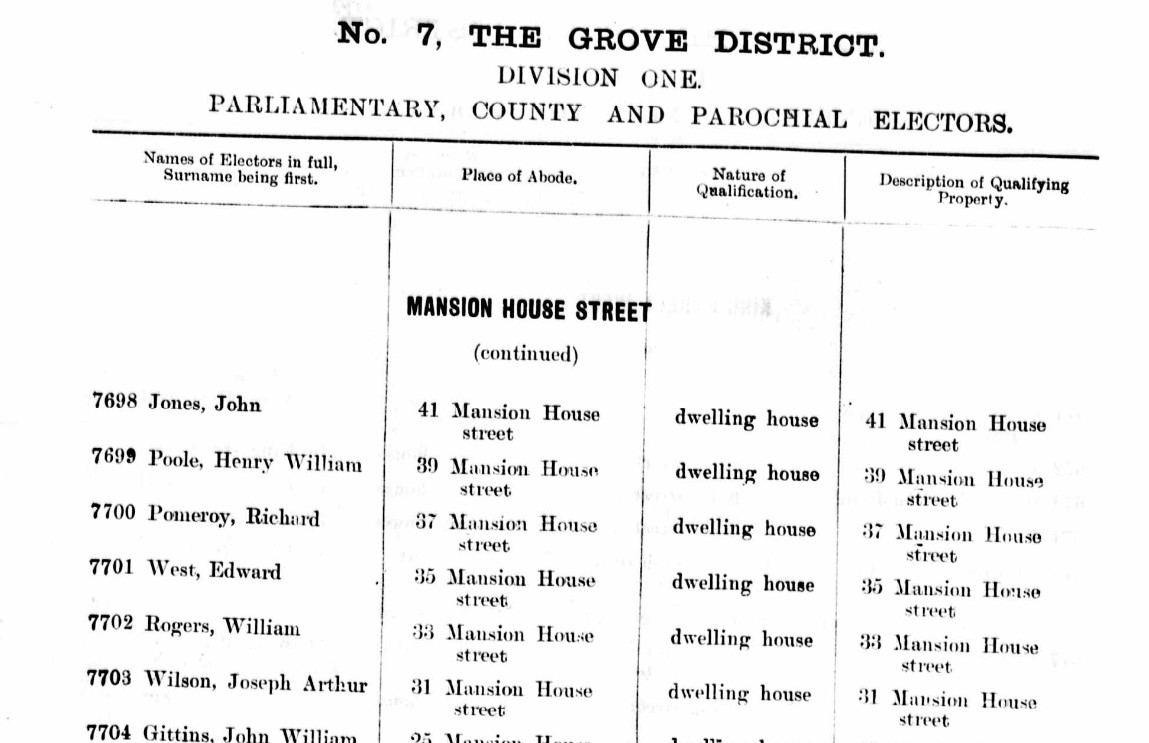
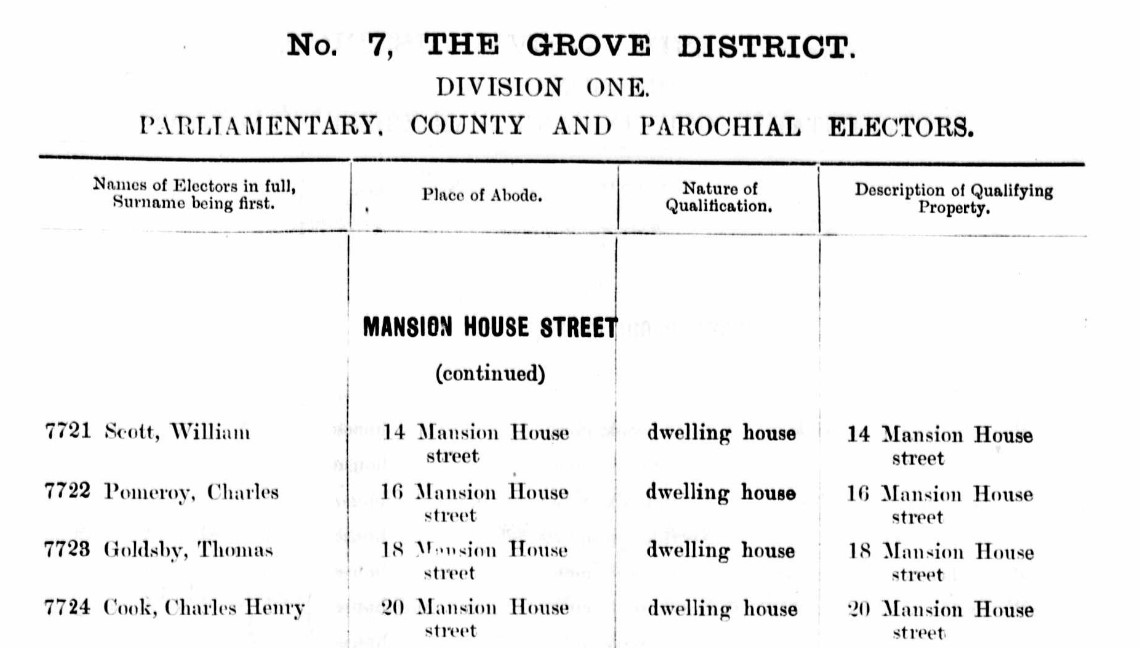
1899 Register of Voters


Teddington
Teddington is a Parish and Town in the Parliamentary Division of Uxbridge in the County of Middlesex. It is in the Hundred of Spelthorne, at the southern end of the ancient County of Middlesex. According to the below map the population of Middlesex in 1831 was 1,358,200, which includes London. London was the largest city in the world between 1831 and 1925 and is the only city to have held the Summer Olympics three times. Another site states it was the Largest in 1825.
London was the first Megacity in the world.
At the beginning of the Industrial Revolution almost a million people lived in London. It was the largest city in the world and the centre of the British Empire , which, at that time was growing at a rapid pace .
As more and more people moved to the city from the countryside London needed more and better transportation systems. In 1863 it became the first city in the world to start an underground railway system.
London was still in the County of Middlesex, and subsequently County of London in 1889. London still contains the City of London and the City of Westminster. Teddington remained in Middlesex but is now part of London Borough of Richmond upon Thames, since 1965, part of Greater London.

Part of the OS 25" Maps, centred around Teddington, with Hampton and the River Thames.
Teddington's beginnings
Bushy House was built in 1663, and its notable residents included British Prime Minister Lord North who lived there for over twenty years. There have been isolated findings of flint and bone tools from the Mesolithic and Neolithic periods in Bushy Park and some unauthenticated evidence of Roman occupation. However, the first permanent settlement in Teddington was probably in Saxon times. Teddington was not mentioned in Domesday Book as it was included under the Hampton entry.
Teddington Manor was first owned by Benedictine monks in Staines and it is believed they built a chapel dedicated to St. Mary on the same site as today's St. Mary's Church. In 971, a charter gave the land in Teddington to the Abbey of Westminster. By the 14th century Teddington had a population of 100–200; most of the land was owned by the Abbot of Westminster and the remainder was rented by tenants who had to work the fields a certain number of days a year.
The Hampton Court gardens were laid out in 1500 in preparation for the planned rebuilding of a 14th-century manor to form Hampton Court Palace in 1521 and were to serve as hunting grounds for Cardinal Wolsey and later Henry VIII and his family. In 1540 some common land of Teddington was enclosed to form Bushy Park and acted as more hunting grounds.
A large minority of the parish lay in largely communal open fields, restricted in the Middle Ages to certain villagers. These were inclosed (privatised) in two phases, in 1800 and 1818. Shortly afterwards, the Duke of Clarence lived there with his mistress Dorothy Jordan before he became King William IV, and later with his Queen Consort, Adelaide of Saxe-Meiningen. The facilities were later converted into the National Physical Laboratory.
Economic change
In subsequent centuries, Teddington enjoyed a prosperous life due to the proximity of royalty, and by 1800 had grown significantly. But the "Little Ice Age" had made farming much less profitable and residents were forced to find other work. This change resulted in great economic change in the 19th century.
The first major event was the construction of Teddington Lock in 1811 with its weir across the river. This was the first (and now the biggest) of five locks built at the time by the City of London Corporation. In 1889 Teddington Lock Footbridge, consisting of a suspension bridge section and a girder bridge section, was completed, linking Teddington to Ham (then in Surrey, now in London). It was funded by local business and public subscription.
After the railway was built in 1863, easy travel to Twickenham, Richmond, Kingston and London was possible and Teddington experienced a population boom, rising from 1,183 in 1861 to 6,599 in 1881 and 14,037 in 1901.
Many roads and houses were built, continuing into the 20th century, forming the close-knit network of Victorian and Edwardian streets present today. In 1867, a local board was established and an urban district council in 1895.
In 1864 a group of Christians left the Anglican Church of St. Mary's (upset at its high church tendencies) and formed their own independent and Reformed, Protestant-style, congregation at Christ Church. Their original church building stood on what is now Church Road.
The Victorians attempted to build a large church, St. Alban's, based on the Notre Dame de Paris; however, funds ran out and only the nave of what was to be the "Cathedral of the Thames Valley" was completed. In 1993 the temporary wall was replaced with a permanent one as part of a refurbishment that converted St Alban's Church into the Landmark Arts Centre, a venue for concerts and exhibitions.
A new cemetery, Teddington Cemetery, opened at Shacklegate Lane in 1879.
Several schools were built in Teddington in the late 19th century in response to the 1870 Education Act, putting over 2,000 children in schools by 1899, transforming the previously illiterate village.
The investigations in Teddington area residency begin.
Charles Pomeroy was living at 18 Palmerston Buildings in the 1891 Census entry, and was in the 1892 Registers of Voters for Parliamentary Borough of Finsbury, East District, North Polling District, Parish of St. Luke, Middlesex, Ward No. 1 City Road West, at number 18 Palmerston Buildings. He was therefore there for the period up to 1891. Following any move outside of the particular Register of Voters it is anticipated that there would be at least a year before being included in the Register for the new area.
Register of Persons Entitled to Vote
A useful source of information is the Register of Persons Entitled to Vote. Women were not entitled to vote and only some men, and only in selected elections.
Ownership Electors - Parliamentary and Parochial
Occupation Electors (Other than Lodgers)
- Division one - Persons entitled to vote in Parliamentary, County, and Parochial Elections
- Division two - Persons entitled to vote in Parliamentary and Parochial Elections, but not County Elections
- Division three - Persons entitled to vote in County, and Parochial Elections, but not Parliamentary Elections, and those prefixed with a † are not entitled to vote in Parochial Election either.
Lodgers - Persons entitled to vote in Parliamentary and Parochial Elections,
Teddington had been divided into 2 wards and subsequently 4 wards.
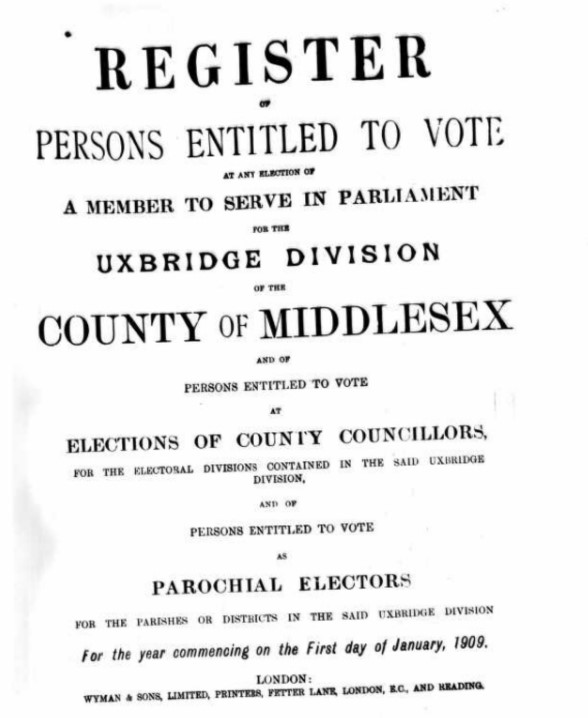
Our family could be in Fulwell Ward or Upper Teddington Ward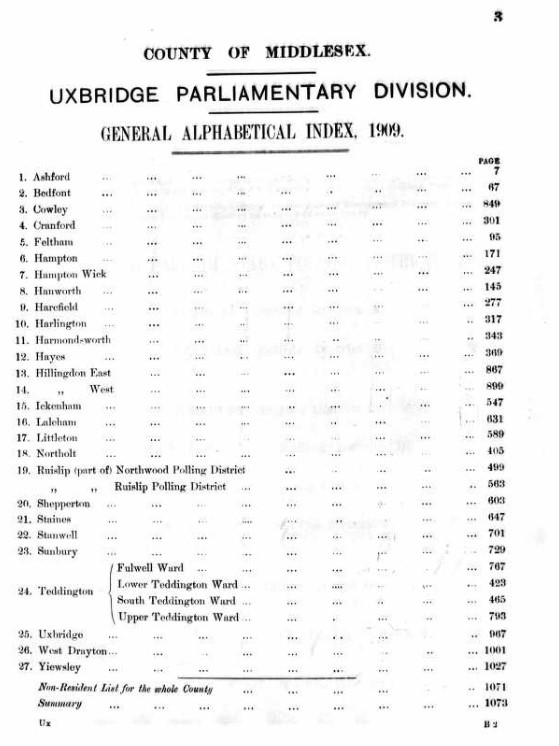
These front pages are similar irrespective of which year in the period. The detail follows within the particular address tab.
The "Register of Persons Entitled to Vote" is published generally for a year, 1st January to 31st December, and this is where I will place this record in the timeline. However, it should be remembered that the register is compiled the year before publication so could easily be six months out of date upon publication. There is therefore a time lag in this information. Also, as the published date is generally 1st January it will be the first entry of each year in our timeline, followed by other records chronologically.
Other sources of data regarding abode are Baptisms, Marriages, and Death Records, together with Census Records.
6 Beaconsfield Villas
6 Beaconsfield Villas, Fulwell Road, Teddington - 1892/1893 to 1904
Also known as 6 Beaconsfield Terrace, Fulwell Road, Teddington
Latterly known as 48 Fulwell Road, Teddington.
In the county of Middlesex.
Charles Pomeroy moved to Teddington from the Clerkenwell area of London between the baptism of Albert Pomeroy, on 3rd May 1891, which took place at St Mary's Church, Islington, and the birth of Emily Ellen Gertrude Pomeroy on 26th January 1893. Baptised on 3rd March 1893 at SS Peter and Paul, Upper Teddington, Middlesex..
1893 Charles 38 years of age
No entry for Pomeroy found in the Teddington "Register of Persons Entitled to Vote."
Baptism


The family had moved to 6 Beaconsfield Villas, Fulwell Road, their abode on the Baptism record and the probable place of birth for Emily Ellen Gertrude Pomeroy on 26th January 1893. Baptised on 3rd March 1893.
1894 Charles 39 years of age
1894 Register of Voters

For the electoral year commencing 1st January 1894, Charles Pomeroy was a voter qualified by occupation of a dwelling house, Division One, living at 6, Beaconsfield Villas, Fulwell Road, Teddington. Entitled to vote in Parliamentary, and County Elections.
1895 Charles 40 years of age
1895 Register of Voters
"Register of Persons Entitled to Vote" form the 30th day of November 1884 to the 31st day of December 1885, but included in the year 1895 for ease of reference.
Firstly, another generic front page, Index to Polling Districts. Teddington with two Wards, Hampton Wick and Teddington.
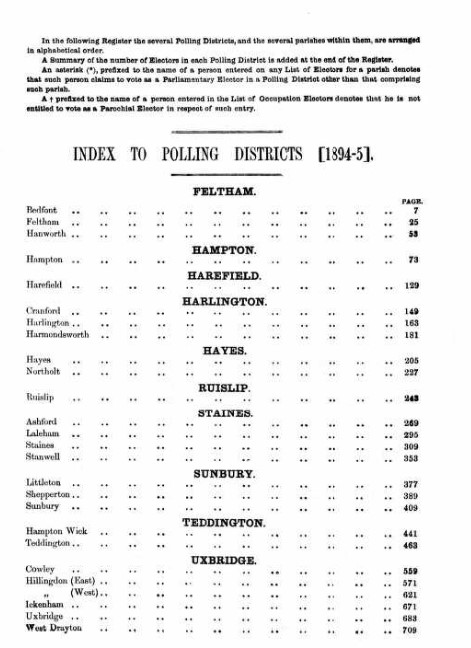

For the electoral year 30th November 1884 to 31st December 1885, Charles Pomeroy was a voter qualified by occupation of a dwelling house, Division One, living at 6, Beaconsfield Villas, Fulwell Road, Teddington. Entitled to vote in Parliamentary, County, and Parochial Elections.
Baptism


Edith Marrian Pomeroy was born of Charles and Charlotte Elizabeth Pomeroy on 2nd January 1895 and baptised on 19th February 1895 at SS Peter and Paul, Upper Teddington, Middlesex. Abode 6 Beaconsfield Terrace, Fulwell Road.
1896 Charles 41 years of age
1896 Register of Voters

Baptism
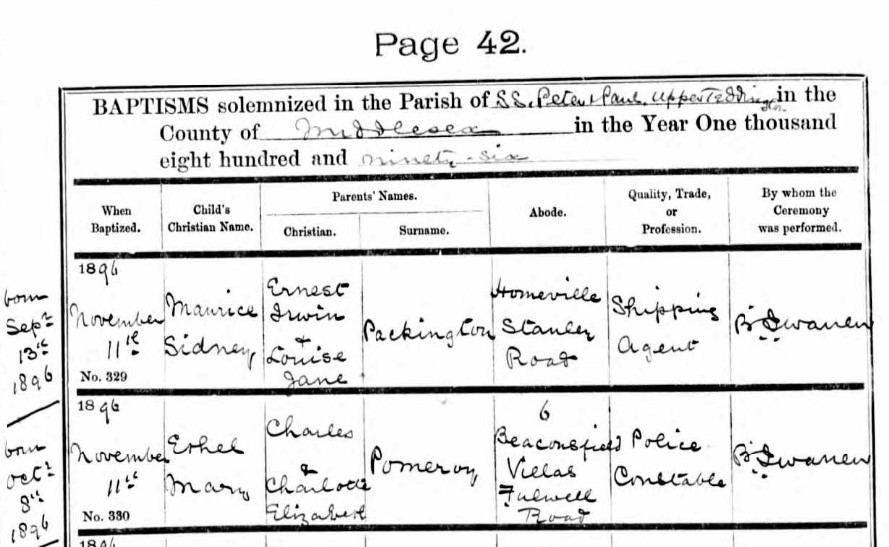
Another daughter. Ethel Mary Pomeroy was born of Charles and Charlotte Elizabeth Pomeroy on 8th October 1896 and baptised on 11th November 1896 at SS Peter and Paul, Upper Teddington, Middlesex.
Abode is still recorded as 6 Beaconsfield Villas, Fulwell Road.
1897 Charles 42 years of age
1897 Register of Voters

Baptism
In 1897 another child was born at their Teddington Home.

Evalyn Harriet Pomeroy was born of Charles and Charlotte Elizabeth Pomeroy on 2nd December 1897 and baptised on 26th January 1898 at SS Peter and Paul, Upper Teddington, Middlesex.
1898 Charles 43 years of age
1898 Register of Voters

1899 Charles 44 years of age
1899 Register of Voters

1900 Charles 45 years of age
1900 Register of Voters

For the electoral years, 1896, 1897, 1898, 1899, and 1900, 1st January to 31st December, each year, Charles Pomeroy was a voter qualified by occupation of a dwelling house, Division One, living at 6, Beaconsfield Villas, Fulwell Road, Teddington. Entitled to vote in Parliamentary, County, and Parochial Elections. Nothing much changed.
1901 Charles 46 years of age
1901 Register of Voters
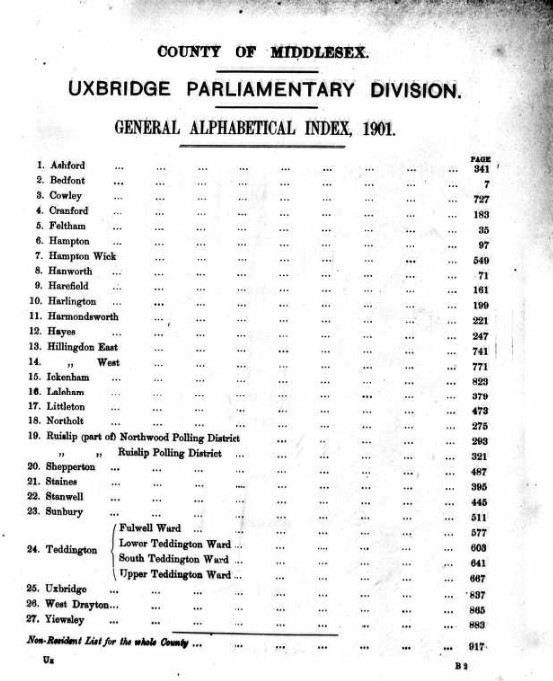
Teddington is expanding and has four Wards, Fulwell, Lower Teddington, South Teddington, and Upper Teddington. Fulwell Road and Prince's Road are both in Fulwell Ward. For the last few years Charles's voter number has been slowly increasing, together with the page number in the register, as more people join the register. Now his voter number is reset.
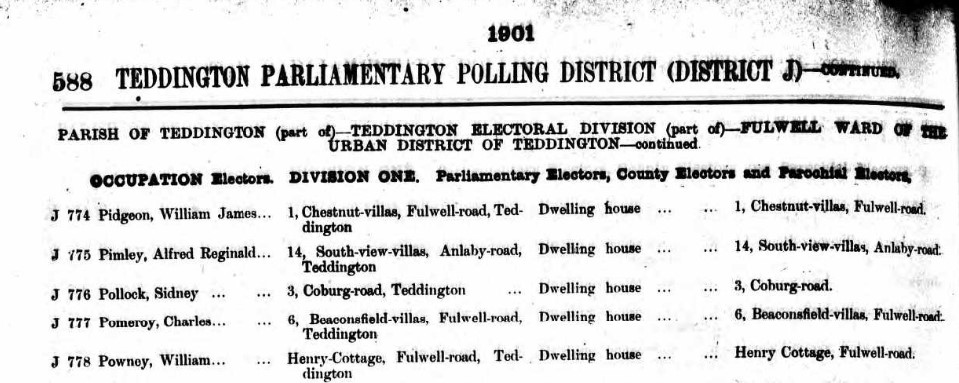
1901 Census
Another ten years and another census, on 31 March 1901.
Charles Pomeroy and his family was still living at 6 Beaconsfield Terrace, Fulwell Road, Teddington, Middlesex. He continued as a Police Constable, now aged 46. His wife Charlotte was now 44.
Charles and Charlotte had six children living with them on 31 March 1901. Three from Clerkenwell / Islington, and three from Teddington Middlesex.
- William, aged 16, a Groom (Baptised William Henry on 2nd November 1884)
- Edward, aged 14, a Gardener (Baptised Edward on 6th February 1887)
- Albert, aged 10 (Baptised Albert on 3rd May 1891)
- Emily, aged 8 (Baptised Emily Ellen Gertrude on 3rd March 1893)
- Ethel, aged 4 (Baptised Ethel Mary on 11 November 1896)
- Evelyn, aged 3, (Baptised Evelyn Harriet on 26 January 1898)
![]()
1902 Charles 47 years of age
1902 Register of Voters
![Ancestry Register of Electors 1902 P604]()
1903 Charles 48 years of age
1903 Register of Voters

Metropolitan Police Force
 On 6 May 1878 he joined G Division of Metropolitan Police in London, when he was still single and 23 years of age. He went on to do 25 years of service, retiring on the 11th May 1903.
On 6 May 1878 he joined G Division of Metropolitan Police in London, when he was still single and 23 years of age. He went on to do 25 years of service, retiring on the 11th May 1903.
This information is from the Metropolitan Police Pensioner records.
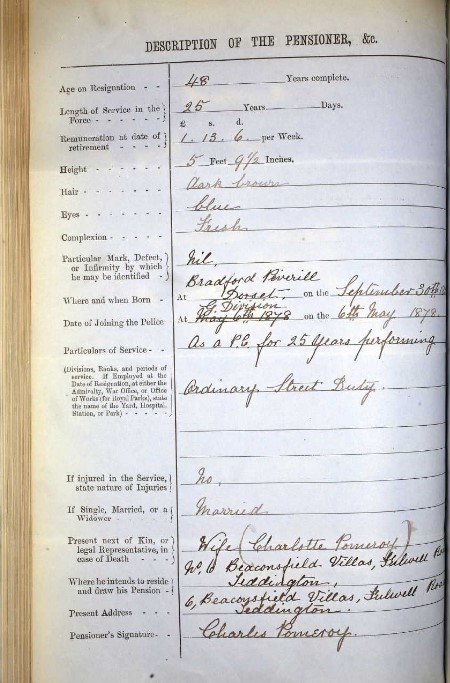
Also from these we can see he was 5ft 91/2 inches tall with dark brown hair and blue eyes.
His place of birth is Bradford Peverill, a misspelling of Bradford Peverell, Dorset.
His date of birth in this record is 30 September, with the year obscured in the page crease. His age on registration is 48, which gives a calculated year of birth of 1854.
He is married to Charlotte Pomeroy and lives at 6 Beaconsfield Villas, Fulwell Road, Teddington, Middlesex.
1904 Charles 49 years of age
1904 Register of Voters
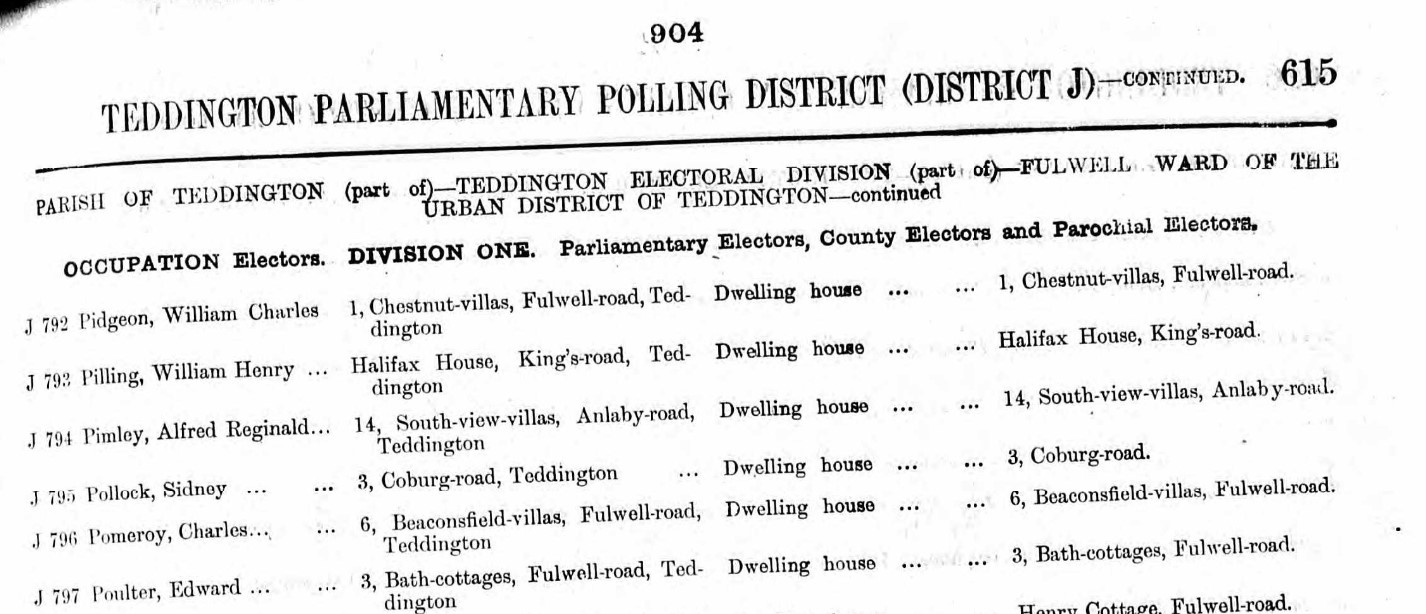
1905 Charles 50 years of age
1905 Register of Voters
 Sometime in 1904, Charles Pomeroy and family moved the short distance from 6 Beaconsfield Villas, Fulwell Road to 2 Albert Villas, Prince's Road, Teddington, after having spent about a dozen years living at the former address.
Sometime in 1904, Charles Pomeroy and family moved the short distance from 6 Beaconsfield Villas, Fulwell Road to 2 Albert Villas, Prince's Road, Teddington, after having spent about a dozen years living at the former address.
Date of first confirmed record at 6 Beaconsfield Villas 3rd March 1893. Date of last record, before 1st January 1905, the first date currency of Register of Voters. (1904 carried forward)
Go to the next tab to read the last record again. Evidence of the move transferred to the next section.
2 Albert Villas 23 Princes Road
2 Albert Villas, 23 Prince's Road, Teddington - 1904 to 1905
No approximate location identified yet, other than Prince's Road.
In the county of Middlesex.
From the military record of their son William Henry Pomeroy where Charles and Charlotte are recorded as next of kin, it appears they moved. Just one street away to number 2 Albion Villas, in Prince's Road. In the 1901 Census, on image 26, page 25 of district 17, 1 & 2 Albion Villas are unoccupied and sit between 10 and 4 Prince's Road.
1905 Charles 50 years of age
1905 Register of Voters
 Sometime in 1904, Charles Pomeroy and family moved the short distance from 6 Beaconsfield Villas, Fulwell Road to 2 Albert Villas, Prince's Road, Teddington, after having spent about a dozen years living at the former address.
Sometime in 1904, Charles Pomeroy and family moved the short distance from 6 Beaconsfield Villas, Fulwell Road to 2 Albert Villas, Prince's Road, Teddington, after having spent about a dozen years living at the former address.
1906 Charles 51 years of age
1906 Register of Voters
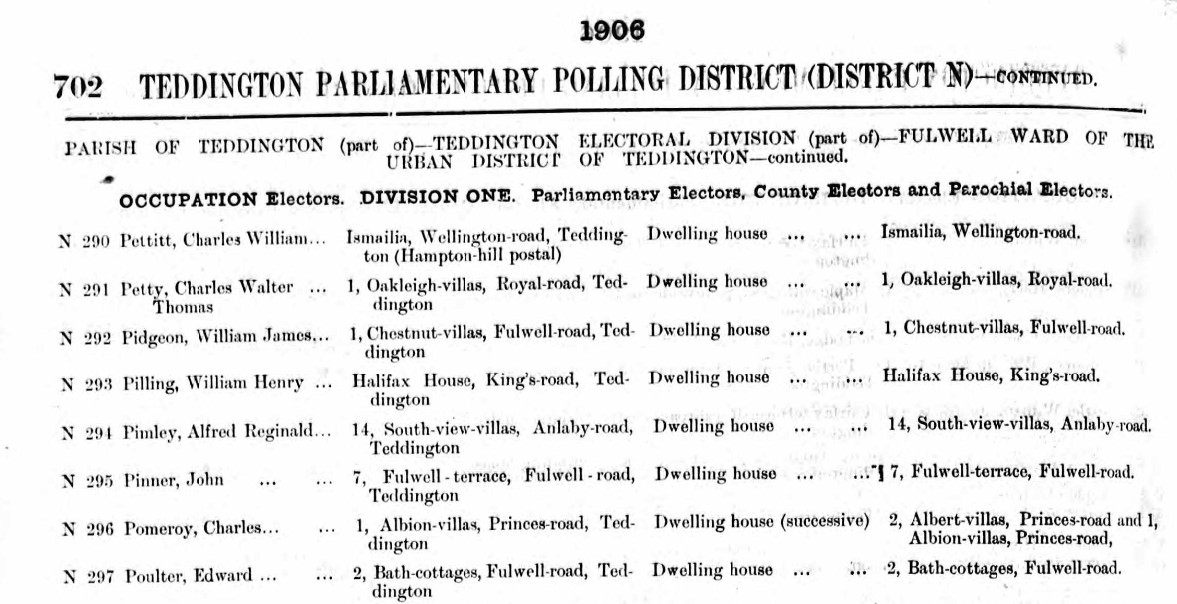
Charles had turned 51 years of age and the family living at home was no longer expanding, but contracting. The second move in as many years. 2 Albert Villas to 1 Albion Villas, both Prince's Road, Teddington.
Returning to the issue of location.
In the 1907 Register of Voters, a Walter Dearling was registered as occupying 1 Albert Villas, presumably next door to 2 Albert Villas on Prince's Road. Also in 1906, 1908 and as Walter William Dearling at 35 Princes Road in 1913 and 1912, but in 1911, successive 49 Princes Road to 35 Princes Road. So what of 1909 and 1910. In the FindMyPast data Charles Pomeroy is at 17 Princes Road in 1909, and Walter Dearling is at 21 Princes Road. Unfortunately the 1910 Register is indistinct in the area of Walter Dearling. It is clear again for the entry of Charles Pomeroy at 17 Princes Road.
Also, Solomon Lay had just moved into 11 Albert Villas Princes Road in 1908. In 1909 and 1910 Solomon Lay is at 23 Prince's Road. John King was at 2 Albion Villas, and is at 19 Prince's Road in 1910. Somewhat inconclusive apart from the renumbering appears to have taken place in 1908, and that Albert Villas and Albion Villas are very close to each other, in the vicinity of 17 to 23 Prince's Road.
Repeating the exercise, but for all entries in the Registers of Voters, 2006 to 2011, inclusive, with a reference of adobe in Princes Road, Teddington. Princes Road and Prince's Road are considered to be the same. Some of the information seems to suggest musical chairs, whilst other data is more consistent. The rationalisation of street numbering appears to have occurred in 2009, and some of the entries conveniently have both systems for one or two years.
The data source is a mix of Ancestry and FindMyPast.
| Entitlement | Voter Name | 1906 | 1907 | 1908 | 1909 | 1910 | 1911 |
| D1 | Pomeroy, Charles | 1 Albion Villas | 1 Albion Villas | 1 Albion Villas | 17 Princes Road | 17 Princes Road | 17 Princes Road |
| D1 | Dearling, Walter | 1 Albert Villas | 1 Albert Villas | 1 Albert Villas | 21 Princes Road | xx | 49 and 35 Princes Road |
| O | Byron, Albert Edward | St Elmo | St Elmo | St Elmo | St Elmo, 40 Prince's Road | St Elmo, 40 Prince's Road | 40 Prince's Road |
| O | Byron, Henry | Bretby | Bretby | Bretby | Bretby, 42 Prince's Road | Bretby, 42 Prince's Road | 42 Prince's Road |
| O | North, William John | Normanhurst | Normanhurst, 46 Princes Road | Normanhurst, 46 Princes Road | 46 Princes Road | ||
| O | Ryan, George Edward Norward | Fullwell House | Fullwell House | Fullwell House | Fullwell House, 1 Prince's Road | Fullwell House, 1 Prince's Road | 1 Prince's Road |
| O | Turney, James Alfred | 66 Princes Road | |||||
| O | Wallis, James | 2 Keswick Villas | 2 Keswick Villas | 2 Keswick Villas | xx | ||
| D1 | Adamson, Donald | Maissonette | Maissonette | Maissonette | xx | xx | xx |
| D1 | Affeltranger, Henry | xx | xx | Ashtead Villa | 39 Prince's Raod | 39 Prince's Raod | Anlaby Road |
| D1 | Allcock, Harry | 15 Prince Road | |||||
| D1 | Atkinson, James | 20 Princes Road | |||||
| D1 | Baker, Ernest Arthur | Redholme, Prince's Road | Windsor Road | ||||
| D1 | Baker, Victor | 12 Princes Road | |||||
| D1 | Barrett, Henry Egbert | xx | 52 Princes Road | 52 Princes Road | |||
| D1 | Bentley, William | 47 Princes Road | |||||
| D1 | Blackburn, George | Royal Road | xx | Princes Villa | xx | xx | xx |
| D1 | Blencowe, George | 47 Princes Road | 47 Princes Road | xx | |||
| D1 | Brydon, William | xx | 4 St John's Villas | 4 St John's Villas | 149 Fullwell Road | 149 Fullwell Road | 149 Fullwell Road |
| D1 | Chalk, Charles | xx | 48 Princes Road | 48 Princes Road | |||
| D1 | Chenery, Richard John | St Cathrine's | St Cathrine's | St Cathrine's | 76 Princes Road | 76 Princes Road | 76 Princes Road |
| D1 | Cluett, Thomas Hibbert | 2 Keswick Villas | 2 Keswick Villas | 2 Keswick Villas | 31 Princes Road | 31 Princes Road | |
| D1 | Condon, John | 2 Verona Villas | 2 Albion Villas | xx | xx | xx | |
| D1 | Cullanan, Peter | 21 Princes Road | |||||
| D1 | Dick, William | Gayhurst | Gayhurst | Gayhurst | 41 Princes Road | xx | xx |
| D1 | Durham, Phillip | 70 Princes Road | |||||
| D1 | Farrow, Harry | 12 then 8 Princes Road (successive) | |||||
| D1 | Feast, Richard | 2 Beaconsfield Villas | 2 Beaconsfield Villas | 2 Beaconsfield Villas | 13 Princes Road | 13 Princes Road | |
| D1 | Fowler, John Franklin | 1 Princes Villas | xx | xx | xx | xx | |
| D1 | Gilford, (Guildford) Christopher | xx | xx | 1 Beaconsfield Villas | 11 Princes Road | 11 Princes Road | 11 Princes Road |
| D1 | Gill, Allan Stuart | xx | Platburg, Princes Road | xx | |||
| D1 | Hanson, James | xx | 18 Princes Road | 18 Princes Road | |||
| D1 | Harris, Thomas Augustus | 68 Princes Road | |||||
| D1 | Hayman, William | Rosslyn, 10 Princes Road | |||||
| D1 | Hayes, William | 15 Princes Road | xx | ||||
| D1 | Hinds, Arthur | 3 Beaconsfield Villas | 3 Beaconsfield Villas | 3 Beaconsfield Villas | xx | xx | xx |
| D1 | Houghton, William Henry | Princes Villa | xx | xx | xx | xx | |
| D1 | Jones, John | 2 Princes Villas | 2 Princes Villas | 2 Princes Villas | 5 Princes Road | 5 Princes Road | 5 Princes Road |
| D1 | King, John | Stanley Road | Stanley Road | 2 Albion Villas | 19 Princes Road | 19 Princes Road | 19 Princes Road |
| D1 | Ladbrook, Alfred | 62 Princes Road | |||||
| D1 | Lay, Solomon | Sunnyside Road | Sunnyside Road | 11 Albert Villas | 23 Prince's Road | 23 Prince's Road | 23 Prince's Road |
| D1 | Lukyn, Clarence | xx | xx | Oregon | 88 Princes Road | 88 Princes Road | 88 Princes Road |
| D1 | Markland, William James | 1 Beaconsfield Villas | 2 Verona Villas | 2 Verona Villas | xx | xx | |
| D1 | Martin, John | Salisbury Villa | Salisbury Villa | Salisbury Villa | xx | Stanley Road | Stanley Road |
| D1 | Monk, John George | Coburg Road | 3 St John's Villas | 3 St John's Villas | 45 Princes Road | 45 Princes Road | xx |
| D1 | Munro, Patrick | Hazeldene, Princes Road | |||||
| D1 | Muirhead, George | 8 Princes Road | |||||
| D1 | New, William | xx | 38 Princes Road | xx | |||
| D1 | Nicholl, James | Westbury Villa | Westbury Villa | Westbury Villa | 51 Princes Road | 51 Princes Road | 51 Princes Road |
| D1 | Parrott, William Frederick | 72 Princes Road | 72 Princes Road | 72 Princes Road | |||
| D1 | Pilgrim, Herbert | 1 St John's Villas | xx | xx | |||
| D1 | Pond, Frank James | 10 Princes Road | |||||
| D1 | Randall, Robert | 2 Stanley Parade | 2 Stanley Parade | 2 Stanley Parade | 33 Princes Road | 33 Princes Road | 33 Princes Road |
| D1 | Saunders, William | 16 Princes Road | |||||
| D1 | Scovell, George | 50 Princes Road | |||||
| D1 | Snow, Edwin | 3 Stanley Parade | 3 Stanley Parade | 3 Stanley Parade | 37 Princes Road | 37 Princes Road | 37 Princes Road |
| D1 | Speer (Spears), James | xx | Sunnyside Road | 4 St John's Villas | 43 Princes Road | 43 Princes Road | 43 Princes Road |
| D1 | Speechley, Jonathan William | 16 Princes Road | Sunnyside Road | ||||
| D1 | Thorp, James Ebenezer | 1 Keswick Villas | 1 Keswick Villas | 1 Keswick Villas | 29 Princes Road | 29 Princes Road | 29 Princes Road |
| D1 | Wilkes, Walter William | Florence Villa | 1 Keswick Villas | Florence Villa | 53 Princes Road | 53 Princes Road | 53 Princes Road |
| D1 | Wood, Mitchell | 7 Princes Road | |||||
| D1 | Woods, Benjamin | xx | 1 Princes Villas | 1 Princes Villas | 3 Princes Road | 3 Princes Road | 3 Princes Road |
| D1 | Woodford, Thomas | Bethany, Princes Road (successive) from 14 Princes Road | |||||
| D3 | ??? Christopher | xx | 41 Princes Road | ||||
| D3 | Byron, Albert Edward | St Elmo | St Elmo | St Elmo | 40 Princes Road | 40 Princes Road | 40 Princes Road |
| D3 | Byron, Frances | Anniscroft | Anniscroft | Anniscroft | 44 Princes Road | 44 Princes Road | 44 Princes Road |
| D3 | Byron, Henry | Bretby | Bretby | Bretby | 42 Princes Road | 42 Princes Road | 42 Princes Road |
| D3 | Chenery, Richard John | 76 Princes Road | |||||
| D3 | Freeman, Evelyn | 74 Princes Road | 74 Princes Road | 74 Princes Road | |||
| D3 | Gray, Arthur | Weycroft, Princes Road | 22 Princes Road | Weycroft | |||
| D3 | Markland, Mary Ann (Successive) | 27 Princes Road | xx | ||||
| D3 | Markland, Mary Ann | 9 Princes Road | xx | ||||
| D3 | North, William John | Normanhurst | Normanhurst | Normanhurst | 46 Princes Road | 46 Princes Road | 46 Princes Road |
| D3 | Pidgeon, Helen | 90 Princes Road | 90 Princes Road | 90 Princes Road | |||
| D3 | Ryan, George Edward Norward | 1 Princes Road | 1 Princes Road | 1 Princes Road | |||
| L | Imber, Henry Charles | xx | 1 Albion Villas | 1 Albion Villas | 1 Albion Villas | xx | |
| L | ??? Arthur | 23 Princes Road | xx | ||||
| L | Pomeroy, Edward | 17 Princes Road | 17 Princes Road | ||||
| L | Rider, Harry | 49 Princes Road | |||||
| L | Webster, Henry | Westbury Villa | Westbury Villa, 51 Princes Road | ||||
It has taken four days to create this table of data.
The change of address form a collection of house or group of house names, to a continuous and sequential numbering along the length of the street seems to have taken place in 1908 and is reflected in the 1909 Register of Voters, with primarily Owners having address with both the old and new, in the same entry.
The next stage is to map the old and new addresses and the people who lived there. Firstly on the South side of Prince's Road, the odd numbers.
Mapping of Old style addresses to New addresses of Prince's Road.
| Certainty | Address | Old Address | 1906 | 1907 | 1908 | 1909 | 1910 | 1911 | 1911 Census |
|---|---|---|---|---|---|---|---|---|---|
| F | 1 Prince's Road | Fullwell House | Ryan, George Edward Norward | Ryan, George Edward Norward | Ryan, George Edward Norward | Ryan, George Edward Norward | Ryan, George Edward Norward | Ryan, George Edward Norward | xx |
| A | 3 Princes Road | 1 Princes Villas | Fowler, John Franklin | Woods, Benjamin | Woods, Benjamin | Woods, Benjamin | Woods, Benjamin | Woods, Benjamin | Woods, Benjamin |
| A | 5 Princes Road | 2 Princes Villas | Jones, John | Jones, John | Jones, John | Jones, John | Jones, John | Jones, John | xx |
| x | 7 Princes Road | Wood, Mitchell | Wood, Mitchell and Dale, Jesse | ||||||
| x | 9 Princes Road | Markland, Mary Ann | Newman, Alfred and Appleman, Frederick Herbert | ||||||
| A | 11 Princes Road | 1 Beaconsfield Villas | Markland, William James | Gilford, (Guildford) Christopher | Gilford, (Guildford) Christopher | Gilford, (Guildford) Christopher | Gilford, (Guildford) Christopher | Guildford, Christopher George and Winslet, Henry | |
| A | 13 Princes Road | 2 Beaconsfield Villas | Feast, Richard | Feast, Richard | Feast, Richard | Feast, Richard | Feast, Richard | Towers, Thomas Sidney Albert | |
| E | 15 Princes Road | 3 Beaconsfield Villas | Hinds, Arthur | Hinds, Arthur | Hinds, Arthur | Hayes, William | Allcock, Harry | Allcock, Henry | |
| A | 17 Princes Road | 1 Albion Villas | Pomeroy, Charles | Pomeroy, Charles | Pomeroy, Charles | Pomeroy, Charles | Pomeroy, Charles | Pomeroy, Charles | Rollison, Henry George and Mountjoy, William |
| A | 19 Princes Road | 2 Albion Villas | Condon, John | King, John | King, John | King, John | King, John | King, Jonathan | |
| E | 21 Princes Road | 1 Albert Villas | Dearling, Walter | Dearling, Walter | Dearling, Walter | Dearling, Walter | Cullanan, Peter | xx | |
| E | 23 Princes Road | 11 Albert Villas | Lay, Solomon | Lay, Solomon | Lay, Solomon | Lay, Solomon | Lay, Solomon | ||
| G | 25 Princes Road | 1 Verona Villas | Bunting, Emily | ||||||
| G | 27 Princes Road | 2 Verona Villas | Condon, John | Markland, William James | Markland, William James | Markland, Mary Ann (Successive) | Markland, Mary Ann (Successive) | xx | |
| A | 29 Princes Road | 1 Keswick Villas | Thorp, James Ebenezer | Thorp, James Ebenezer | Thorp, James Ebenezer | Thorp, James Ebenezer | Thorp, James Ebenezer | Thorp, James Ebenezer | Thorp, James Ebenezer |
| A | 31 Princes Road | 2 Keswick Villas | Cluett, Thomas Hibbert | Cluett, Thomas Hibbert | Cluett, Thomas Hibbert | Cluett, Thomas Hibbert | Cluett, Thomas Hibbert | Wallis, Clara Jane | |
| A | 33 Princes Road | 2 Stanley Parade | Randall, Robert | Randall, Robert | Randall, Robert | Randall, Robert | Randall, Robert | Randall, Robert | |
| x | 35 Princes Road | Dearling, Walter | Dearling, Walter William and Stevens, Elizabeth | ||||||
| A | 37 Princes Road | 3 Stanley Parade | Snow, Edwin | Snow, Edwin | Snow, Edwin | Snow, Edwin | Snow, Edwin | Snow, Edwin | Snow, Edwin |
| E | 39 Princes Road | Ashtead Villa | Affeltranger, Henry | Affeltranger, Henry | Affeltranger, Henry | Timpson, Maggie Lydia | |||
| E | 41 Princes Road | Gayhurst | Dick, William | Dick, William | Dick, William | Dick, William | Fox, Walter John | ||
| E | 43 Princes Road | 4 St John's Villas | Brydon, William | Speer (Spears), James | Speer (Spears), James | Speer (Spears), James | Speer (Spears), James | Speer, James and Gibbs, Edward Pratt | |
| E | 45 Princes Road | 3 St John's Villas | Monk, John George | Monk, John George | Monk, John George | Monk, John George | Ridley, Louisa | ||
| G | 47 Princes Road | 2 St John's Villas | Blencowe, George | Blencowe, George | Bentley, William | ||||
| G | 49 Princes Road | 1 St John's Villas | Pilgrim, Herbert | Dearling, Walter | Brown, Henry George and Ayling, Frederick George | ||||
| F | 51 Princes Road | Westbury Villa | Nicholl, James | Nicholl, James | Nicholl, James | Nicholl, James | Nicholl, James | Nicholl, James | Webster, Henry and Nichols, James |
| A | 53 Princes Road | Florence Villa | Wilkes, Walter William | Wilkes, Walter William | Wilkes, Walter William | Wilkes, Walter William | Wilkes, Walter William | Wilkes, Walter William |
Key for Certainty Column,
- F = Firm, there is an entry with both the old and new address
- A = Assumption, there is a continuous, or almost continuous occupation by one person.
- E = Estimate, there is a reasonable presumption that there is a link between the old and new address.
- G = Guess, patterns or sequences suggest a link.
- x = no relationship found to provide an old address.
In the 1911 Census column there are sometimes more than one family recorded as in residence, whereas in the Register of Voter only one person would gain entitlement to vote.
I said firstly, the South Side, but there is very little correlation on the North Side of Prince's Road, so unless I find more information I will not bore you with it here.
The significant outcome from this work is that 2 Albert Villas, is probably also 11 Albert Villas, which presumably a derivation of II Albert Villas, is 23 Prince's Road in the revised address. The previous information will be adjusted to Charles Pomeroy and family living at 2 Albert Villas, 23 Prince's Road, Teddington.
Going forward, also from this work, 1 Albion Villas is the same address as 17 Prince's Road and not a separate home. There will be an adjustment therefore to 1 Albion Villas, 17 Prince's Road.
Date of first confirmed record at 2 Albert Villas before 1st January 1905, i.e. 1904. Date of last record, before 1st January 1906, the first date currency of Register of Voters. (1905 carried forward)
Go to the next tab to read the last record again and continue.
1 Albion Villas 17 Princes Road
1 Albion Villas, 17 Prince's Road, Teddington - 1905 to 1910/1911
In the region of about 8 to 6 Prince's Road, which is probably more indicative than definitive.
Possibly also known as 17 Prince's Road, Teddington, now considered confirmed.
In the county of Middlesex.
1906 Charles 51 years of age
1906 Register of Voters

Charles had turned 51 years of age and the family living at home was no longer expanding, but contracting. The second move in as many years. 2 Albert Villas to 1 Albion Villas, both Prince's Road, Teddington.
1907 Charles 52 years of age
1907 Register of Voters

Charles appeared again in that year's Register of Voters, as somebody who let out part of his property to a Lodger, who was entitled to vote. I this case it was Henry Charles Imber who has two unfurnished rooms on the first floor for the sum of 4s 6d per week, £0.225. Relative income value of that income or wealth is £143.60 per week, or £7,526.00 per year, in 2019.

1908 Charles 53 years of age
1908 Register of Voters
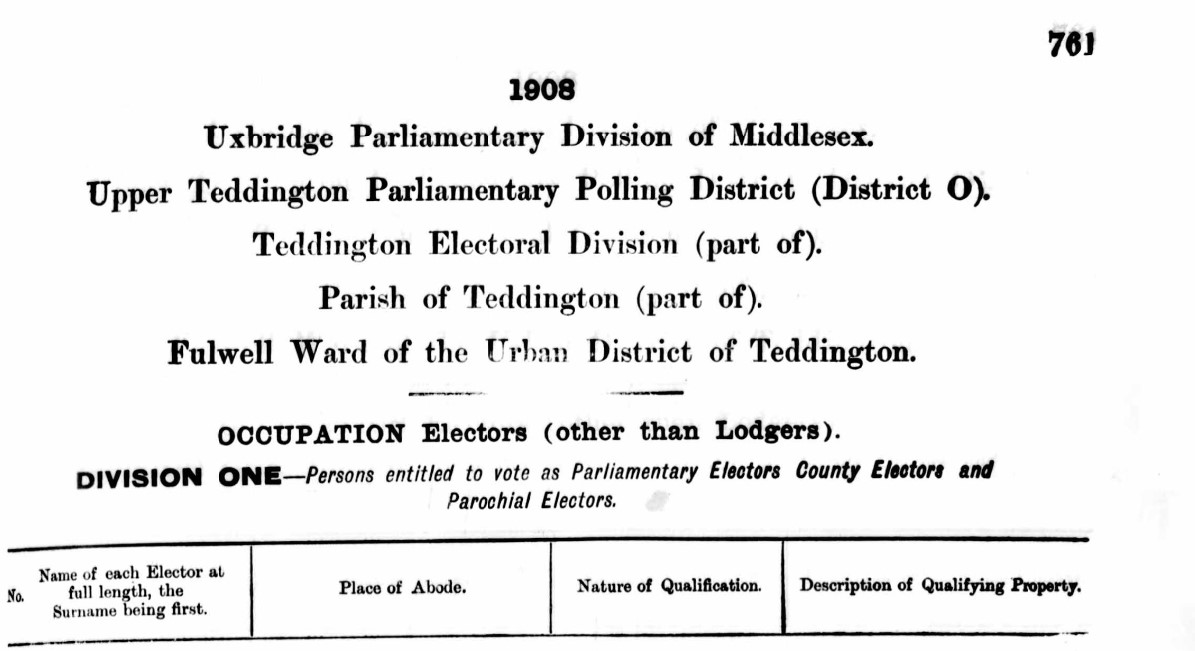
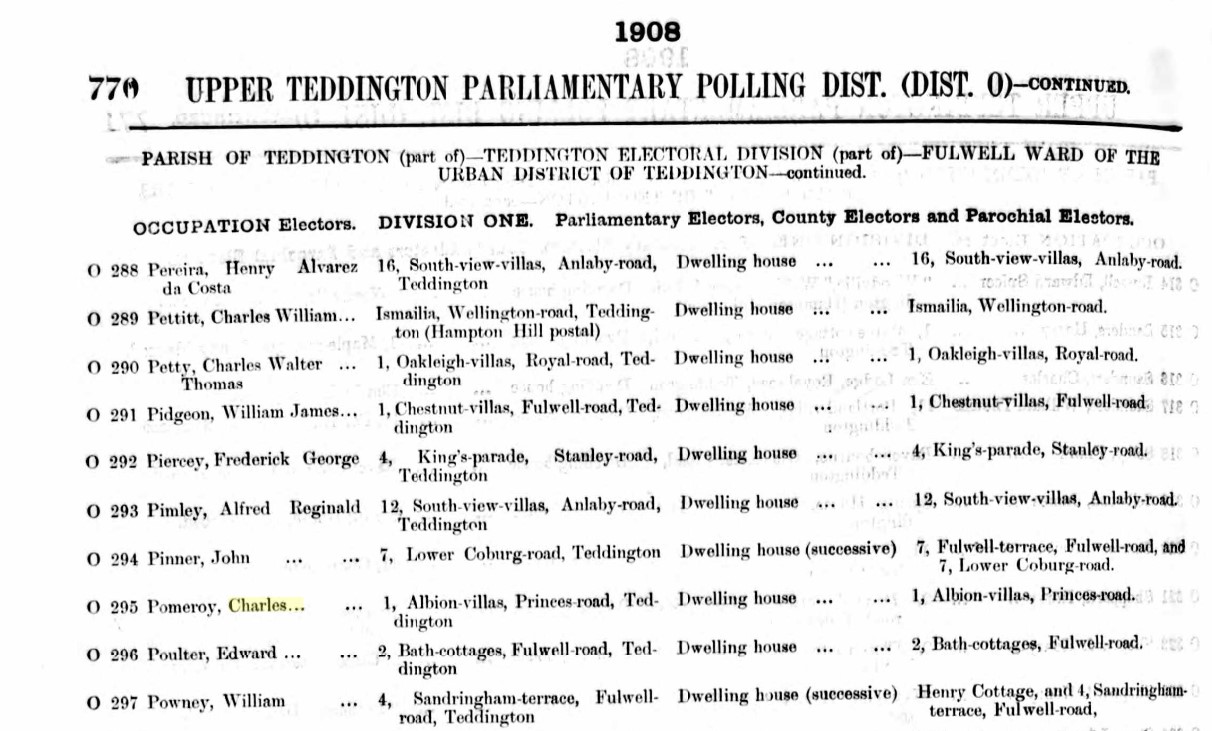
For the electoral year commencing 1st January 1908, Charles Pomeroy was a voter qualified by occupation of a dwelling house, Division one, living at 1, Albion villas, Princes Road, Teddington.

He still had a Lodger in 1908.

I am not sure who George Joseph Pomery was, or even if he is part of our story. However, I have found him, and as these register images are not consistently well transcribed and indexed, which results in having to turn digital pages though the book to find entries, I am not about to pass it over and lose him. He was a Lodger renting a sitting room on the first floor and second floor bedroom, furnished, at Fairley, Church Road, Teddington from a Miss M Strubell, Church Road, Teddington. Rent paid not disclosed. Number 1977 on the Electoral Roll, fifth up from the bottom of the page. Thr rent was stated as 11s per week, (£0.55) in the 1905 register, but again blank in 1906 and 1907, all for the same place.
1909 Charles 54 years of age
Source missing from Ancestry, unfortunately this omission means that there is a lack of continuity of addresses, at a point where the address changes from 1 Albion Villas to 17 Prince's Road. Is this the same home re-addressed by numbering the whole of the street, or a different home?
FindMyPast had the relevant document.
1909 Register of Voters
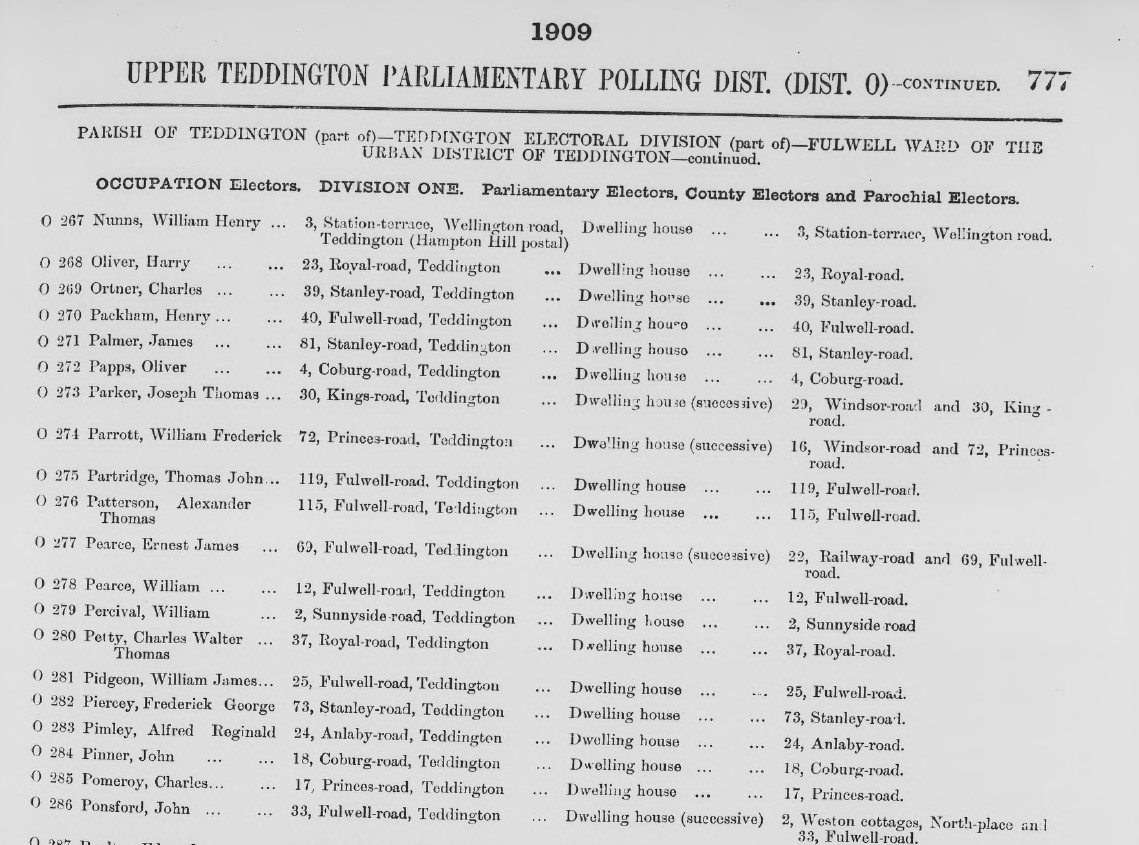
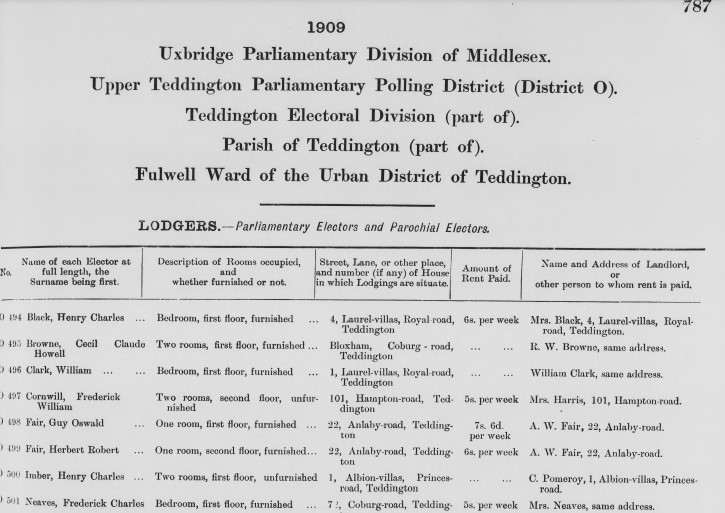
Charles still has the same lodger as in the last two years of Registers of Voters books.
In the same 1909 Register of Voters, Charles Pomeroy is living at 17 Princes Road in the 'Occupation Electors - Division one' (two images above) and at 1 Albion Villas, Princes Road in the Lodgers section of the same book, just ten pages further on. I think this confirms the thought that 1 Albion Villas and 17 Princes Road are one and the same.
17 Princes Road, Teddington
Also known as 17 Prince's Road, Teddington, and previously as 1 Albion Villas.
In the county of Middlesex.
1910 Charles 55 years of age
1910 Register of Voters

Charles Pomeroy at 17 Princes Road and his eldest Son William Henry Pomery (Pomeroy) at White Cottage, Wellington Road, Teddington (Hampton Hill postal), just a few minutes walk apart.
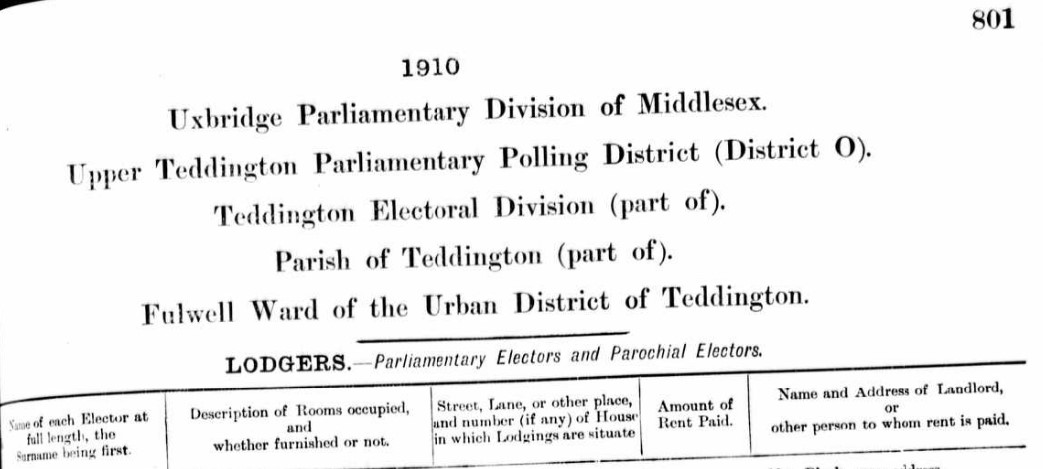

Another son, Edward Pomeroy, has managed to get on the Electoral Roll by renting a second floor furnished room from his father at 17 Princes Road. Note that on the earlier OS map it was Prince's Road but has lost the apostrophe to become Princes Road.
1911 Charles 56 years of age
1911 Register of Voters


1912 Charles 57 years of age
1912 Register of Voters

Notable by his absence, Charles Pomeroy is not in the Registry next to / above his son William Henry Pomeroy.
Date of first confirmed record at 1 Albion Villas / 17 Prince's Road before 1st January 1906, i.e. 1905. Date of last record, before 1st January 1911, the first date currency of Register of Voters. (1910 carried forward)
Teddington
Bing Maps aerial view of the three homes of Charles and Charlotte Elizabeth Pomeroy in Teddington, together with the White Cottage, one time home of their eldest son William Henry Pomeroy, and Teddington Cemetery, opened in 1879. Baptised as Edith Marian Pomeroy but buried as Edith Mary Pomeray in Teddington Cemetery on 19th March 1895, 10 weeks old.
Hillingdon
Hillingdon is
The Prince Albert
The Prince Albert Public House, Colham Green 1910/1911 - 1912/1913
Now demolished and replaced with Prince Albert Court, Pield Heath Road, Colham Green, Hillingdon, Uxbridge.
In the county of Middlesex.
1912 Charles 57 years of age
1912 Register of Voters

Notable by his absence, Charles Pomeroy is not in the Registry next to / above his son William Henry Pomeroy.
1911 Cenus
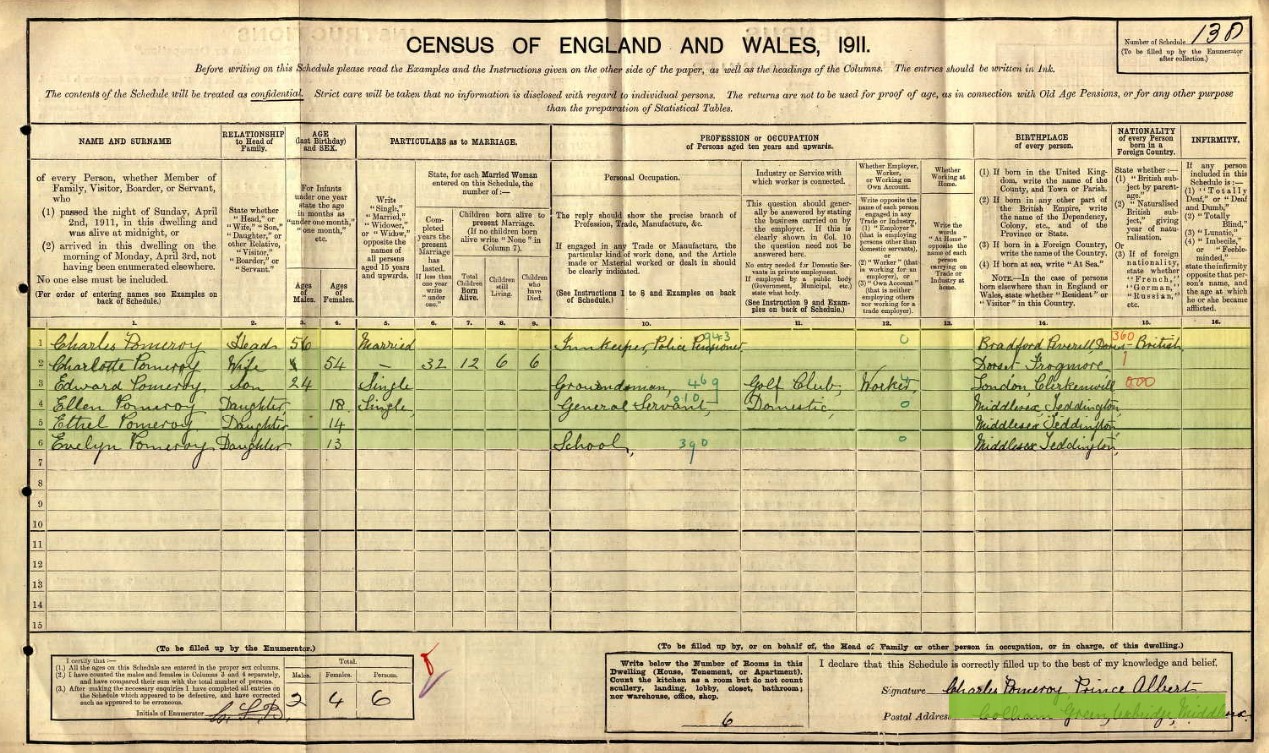
Charles Pomeroy and his family was are no longer living at 6 Beaconsfield Terrace, Fulwell Road, Teddington, nor at either of the Prince's Road addresses. Another move, this time further, into another constituency, but still in Middlesex. He has retired as a Police Constable, now aged 56. His wife Charlotte was now 54.
Charles and Charlotte had four children living with them on 2 April 1911. Compared to the last census in 1901, William, a Groom, than aged 16, now 26 and Albert, then aged 10, now 20, have moved out or were not there on the day of the census.
- Edward, aged 24, single a Groundsman at the Golf Club (Baptised Edward on 6th February 1887)
- Ellen, aged 18, single, a general domestic servant (Baptised Emily Ellen Gertrude on 3rd March 1893)
- Ethel, aged 14 (Baptised Ethel Mary on 11 November 1896)
- Evelyn, aged 13, (Baptised Evelyn Harriet on 26 January 1898)
According to the census record, Charles and Charlotte had 12 children born alive, with 6 still living and 6 who had died.
Again, according to the census, Charles and Charlotte had been married 32 years, which equates to 1879. They were married on 15th December 1878 at Maiden Newton, Dorset, England.
Both children and marriage correlate to information already established.
This census is the first one that is not completed by an Enumerator, but by the occupants themselves. This is most probably the hand writing of Charles Pomeroy, as the head of the family.
The property a 6 Beaconsfield Terrace appears externally to be a two up two down, which would mean all six children occupying the same bedroom, and their parents the other bedroom.
According to the 1911 Census for 48 Fulwell Road, Teddington, the dwelling has 5 rooms, which includes the kitchen, hence confirming it as two reception rooms plus kitchen, downstairs and two bedrooms upstairs. Closet and Bathroom are not counted and are not necessarily indoors or in existence. The new home, Prince Albert, Colham Green, Uxbridge, Middlesex, has 6 rooms, one more, with two less adult children.
The Registration District for the 1911 Census is 40 with the sub-district 40-05 and the Enumeration district 17, for Mr Henry Imber, of 14 Coburg Road, Teddington. However, Teddington appears to have moved into Surrey according to Ancestry, but is still part of the Uxbridge Division of Middlesex from the Census.
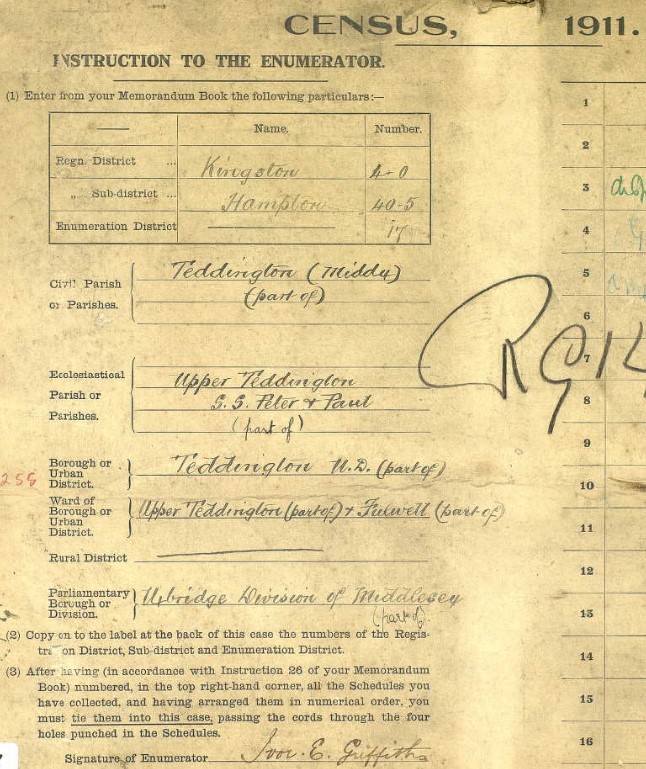
In the 1911 Census 17 Prince's Road Teddington can be found in Enumeration District 18, Number in Schedule 147, and image 302 in Ancestry.
Henry George Rollison. aged 24, a Tram Conductor from Brixton, London, England is living there with his wife Edith Mary Rollison from Hungerford, Berkshire, England. They have been married 2 years and have a 9 month old daughter, Maud Ellen Rollison who was born in Teddington.
The property is recorded as having four rooms.
Also recorded in the Census as living at 17 Prince's Road is William Mountjoy, aged 25, a Police Constable for the Metropolitan Police Force, from Midsomer, Norton, Somerset, England living with his wife of one year, Mabel Mountjoy, aged 22, from Kenton, Devon, England. They had had a child but sadly it had died by the date of the Census.
I wonder if there is any connection with both William and Charles both being Police Constables, and from the West Country?
The property has a further 3 rooms, a total of seven rooms.
Number 19 Prince's Road is still occupied by John / Jonathan King, as it has been since 1908 according to the Register of Voters, and has seven rooms. The family is of seven people living at the address.
Next in the Census is number 23, with a family of six headed by Solomon Lay, who also first appeared in the Register of Voters at that address in 1908. It is recorded as having six rooms.
Number 21 appears to be missing.
Both 17 and 23 are previous residencies of Charles Pomeroy and the only interest here is the size of the property provided by the 1911 Census.
1912 Register of Voters

According to the 1911 Census, Charles Pomeroy and his family that had not moved out, had moved to the Prince Albert public house, Colham Green. This is the Ward and Parish that he should appear on the Register of Electors. The Qualifying Property for Edward Allen confirms that we are on track. Charles is in the 1911 Register as being in Teddington, but in Colham Green for the Census. This is not a surprise as the Register takes time to collate and print, and subsequently comes into force on the 1st January. Perhaps there is as much as a six month lag. The census is a record of the day of the census, 2nd of April 1911. Different timescales. However, that may explain the 1911 entry, but it is surprising not to find a 1912 entry.
Whilst there are a number of entries that refer to 'near' Prince Albert, and there are a number of other establishments referred to by the Pub Name, there appears to be no entry for specifically the Prince Albert, in any of the categories, including ownership, both Home and Away.
1913 Charles 58 years of age
1913 Register of Voters
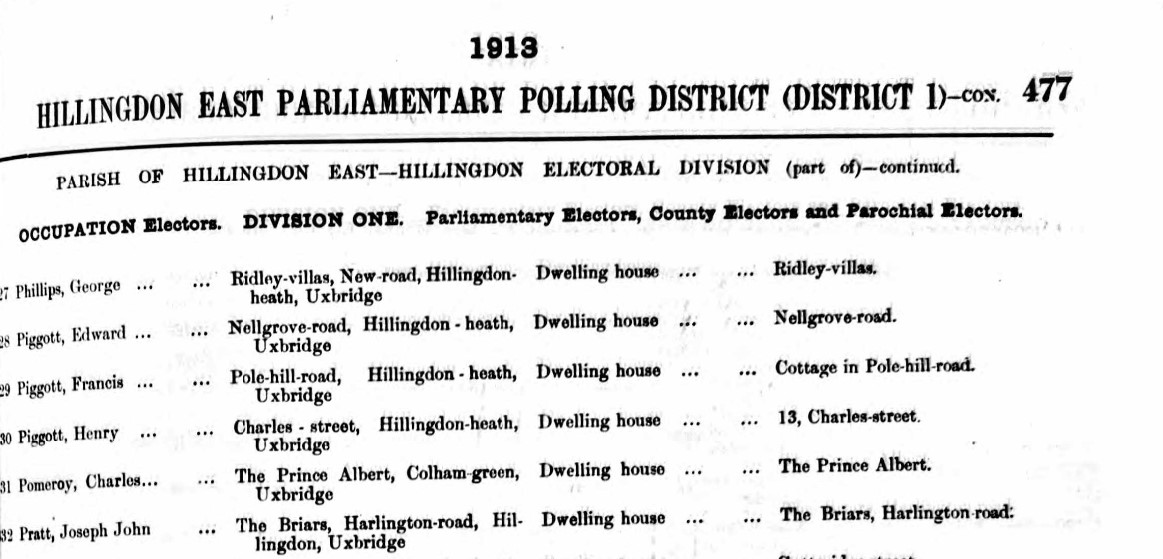
Charles Pomeroy has an entry for 1913, at The Prince Albert, Colham Green, Uxbridge, in the Parish of Hillingdon East, as expected.
Date of first confirmed record at The Prince Albert Colham Green, the Census dated 2nd April 1911, i.e. 1911. Date of last record, before 1st January 1913, the first date of currency of Register of Voters. (1912 carried forward)
3 Stewkley Terrace 38 Heath Road
3 Stewkley Terrace, 38 Heath Road, Hillingdon, Uxbridge 1912/1913 to 1930/1931
In the Registers for 1914 and 1915, the abode is just recorded as Heath Road, Hillingdon, Uxbridge. I have assumed that they are one in the same. This is an assumption and is not necessarily correct. The '(successive)' notes seen previously is not evident, perhaps due to the missing records, or the change of layout and requirements for being eligible to vote. However, I have currently assumed it is just additional information, as there was no number of Heath Road on the 1914 and 1915 records.
In the county of Middlesex.
The photo is of Stewkley Terrace in Heath Road. At the left end is number 40, with the front door to the side. The white door is number 36, and presumably, 34 is at the side. The property out of shot to the left is Bryantwood Villa and Prospect Villa, which by reference to the 1931 Register of Voters below, which is by order of address, instead of alphabetical by surname, is next to 4 Stewkley Terrace. That would make 3 Stewkley Terrace number 38 Heath Road.
1914 Charles 59 years of age
1914 Register of Voters
From the 1914 Registry Charles has moved again. From The Prince Albert to Heath Road, Hillingdon, about a mile away.
1915 Charles 60 years of age
1915 Register of Voters

1916 Charles 61 years of age
Missing from source
1917 Charles 62 years of age
Missing from source
1918 Charles 63 years of age
1918 Register of Voters


More than just the layout has changed. More men are allowed to vote, with different criteria. Look at voter number 685, Charles Pomeroy's wife, Charlotte Elizabeth Pomeroy is allowed to vote, by virtue of HO, Qualification through Husbands occupation. Read more about Women get the vote at Parliament UK
1919 Charles 64 years of age
1919 Register of Voters


Charles and Charlotte Elizabeth Pomeroy still living at 3 Stewkley Terrace, Heath Road, Hillingdon, (Division 1) together with their surviving son, Albert Pomeroy (Division 2). Florence Pomeroy, of Ash's Cottages, Colham Green, the widow of Edward Pomeroy, as this was where they lived before his Military Service and death in France. Florence Pomeroy is recorded as being at this address, in the Register of Voters up to 1923.
1920 Charles 65 years of age
1920 Register of Voters
1921 Charles 66 years of age
1921 Register of Voters

Let's look at Florence Pomeroy, the widow of Edward Pomeroy. Living at Ash's Cottages, Colham Green. Who else is living at Ash's Cottages? If the Register of Voters in a few years time, it is easy as the Register is ordered by address. However, In 1921 it is still ordered alphabetically by surname and then first name. You have to look through the whole Register to find all addresses and record the names.
So, lets build a table and get started.
| 1919 | 1920 | 1921 | 1922 | 1923 | 1924 | 1925 |
| |
|---|---|---|---|---|---|---|---|---|
| Bishop, Jesse Joseph | Bishop, Jesse Joseph | Bishop, Jesse Joseph | Bishop, Jesse Joseph | Bishop, Jesse Joseph | Bishop, Jesse Joseph | M | Bishop, Jesse Joseph | 3 Ash's Cottage, Pield Heath Road |
| Bishop, Minnie Amelia | Bishop, Minnie Amelia | Bishop, Minnie Amelia | Bishop, Minnie Amelia | Bishop, Minnie Amelia | Bishop, Minnie Amelia | I | Bishop, Minnie Amelia | |
| -- | Floyd, John | Floyd, John | Floyd, John | Floyd, John [FMP] | Floyd, John | S | -- | |
| -- | -- | Green, George Herbert | Green, George Herbert | Green, George Herbert [FMP] | -- | S | -- | |
| -- | -- | Green, Emma | Green, Emma | Green, Emma [FMP] | -- | I | -- | |
| Pomeroy, Florence | Pomeroy, Florence | Pomeroy, Florence | Pomeroy, Florence | Pomeroy, Florence | -- | N | -- | |
| Russell, Arthur Edward | Russell, Arthur Edward | Russell, Arthur Edward | Russell, Arthur Edward | Russell, Arthur Edward | Russell, Arthur Edward | G | Russell, Arthur Edward | 2 Ash's Cottage, Pield Heath Road |
| Russell, Stella Ann | Russell, Stella Ann | Russell, Stella Ann | Russell, Stella Ann | Russell, Stella Ann | Russell, Stella Ann | Russell, Stella Ann | ||
| Templeman, Harry | Templeman, Harry | Templeman, Harry | Templeman, Harry | Templeman, Harry | Templeman, Harry | Templeman, Harry | Bedford Cottage, Pield Heath Road | |
| Templeman, Rebecca | Templeman, Rebecca | Templeman, Rebecca | Templeman, Rebecca | Templeman, Rebecca | Templeman, Rebecca | Templeman, Rebecca | ||
| Mattingley, Joseph | 1 Ash's Cottage, Pield Heath Road | |||||||
| Mattingley, Eliza Jane | ||||||||
| Davis, Luke | 4 Ash's Cottage, Pield Heath Road | |||||||
| Hall, Sidney | ||||||||
It is only through doing exercises like this that you find out that the image for the 1923 scan is missing pages 12 and 13 of the Register of Voters. Doing a normal search would just not produce the results, only by looking at the images and checking the page numbers can you see that something is missing. Fortunately, I found the missing pages in FindMyPast, annotated [FMP], all other from Ancestry. The 1925 Register is missing, on Ancestry but I have checked on FindMyPast and the information is the same and the 1926 entries.
Ash's cottages are on Pield Heath Road, Colham Green, between the Prince Albert and the Prince of Wales, with number 1 being closer to the Prince Albert.
I was hoping for an entry of Arthur George Nicholls, the possible second husband of Florence, at Ash's Cottages, but alas not to be. Nor did I find out which cottage Florence lived in, although I did narrow it down to 1 or 4 Ash's Cottage.
Fairly inconclusive really.
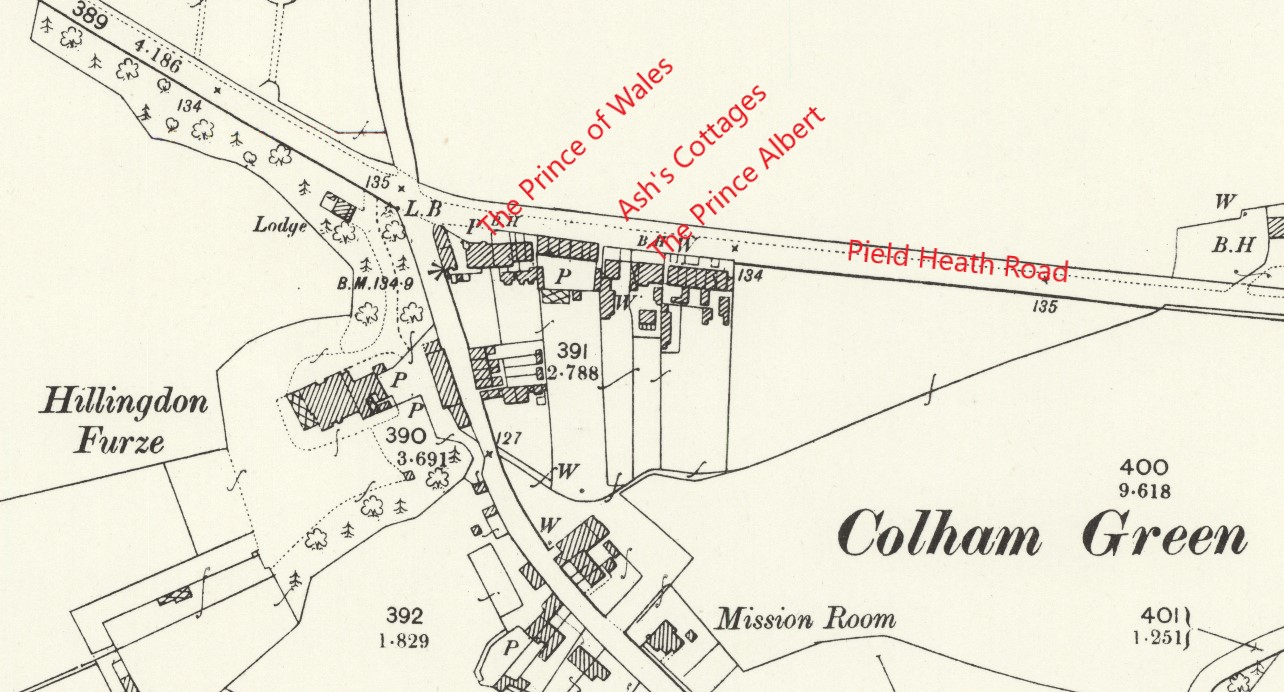
1922 Charles 67 years of age
1922 Register of Voters
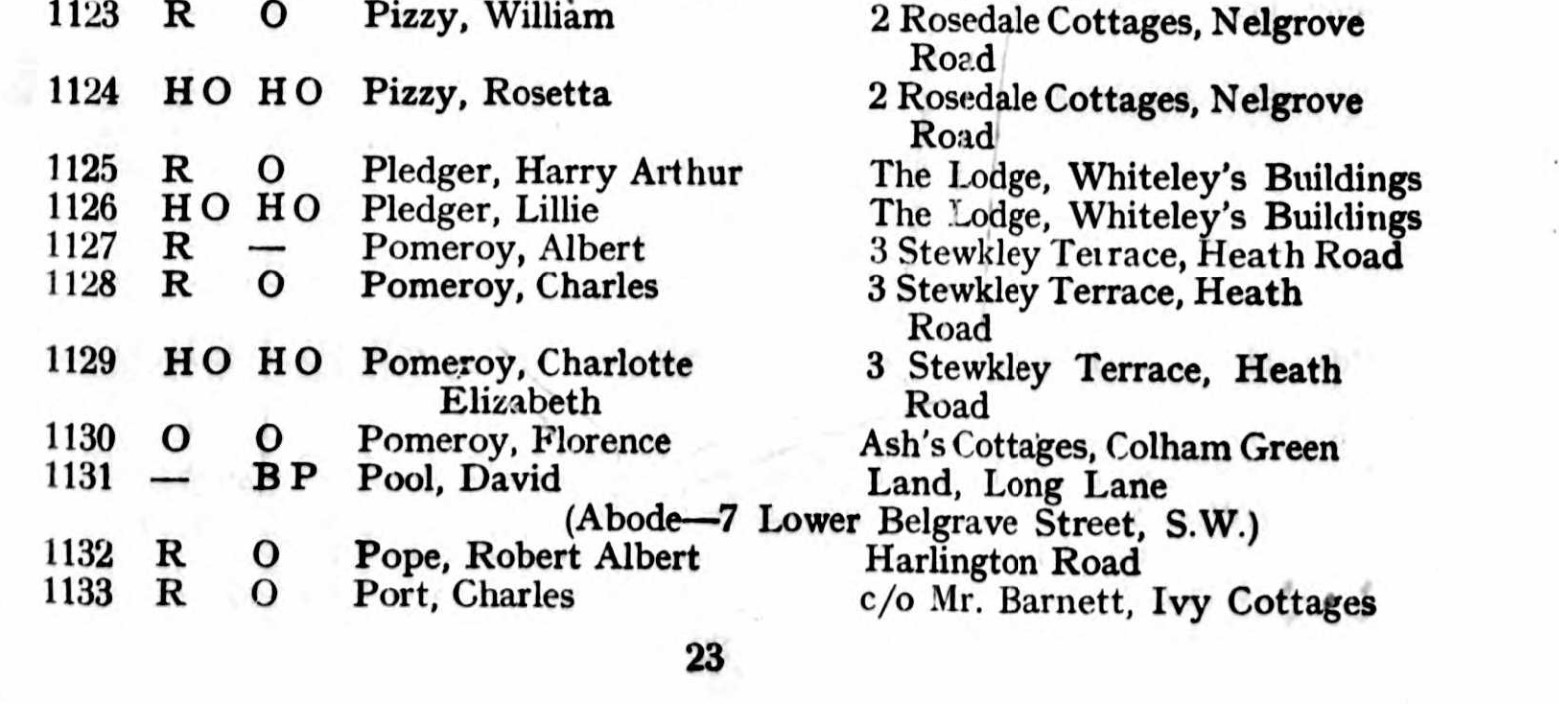
1923 Charles 68 years of age
1923 Register of Voters
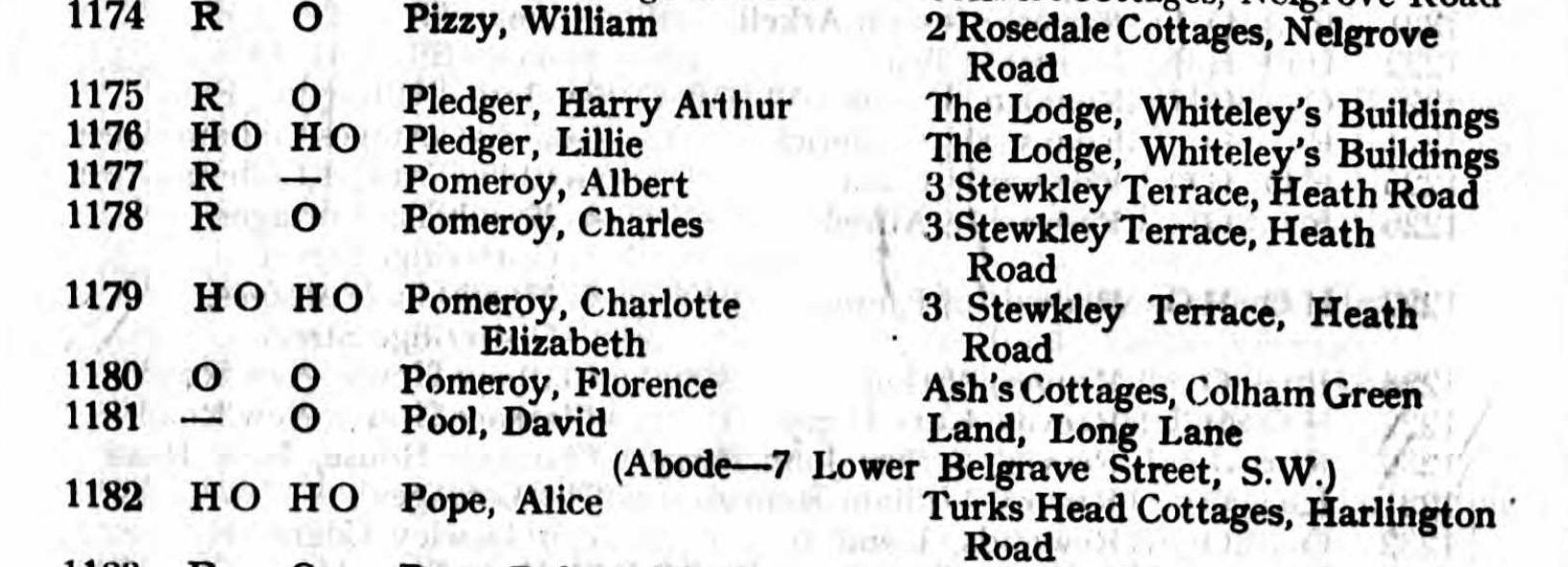
1924 Charles 69 years of age
1924 Register of Voters
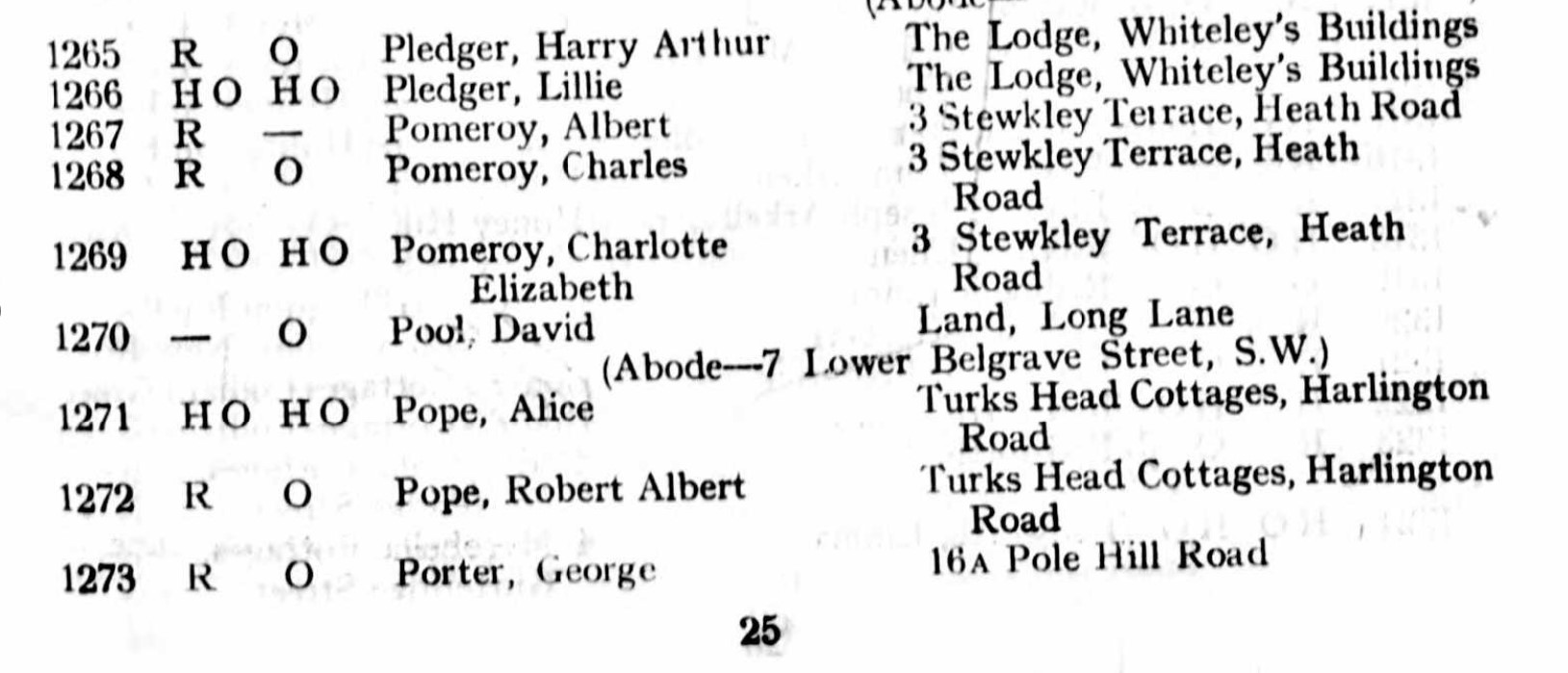
1925 Charles 70 years of age
1925 Register of Voters
Missing form source
1926 Charles 71 years of age
1926 Register of Voters
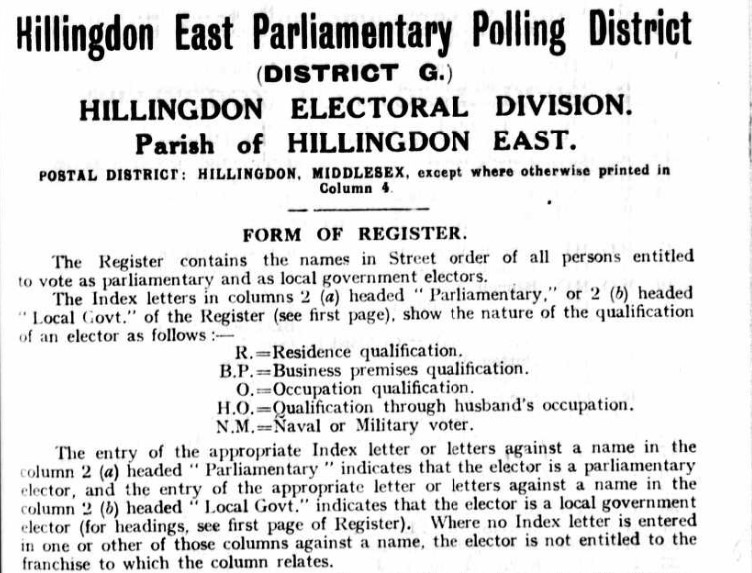

1927 Charles 72 years of age
1927 Register of Voters
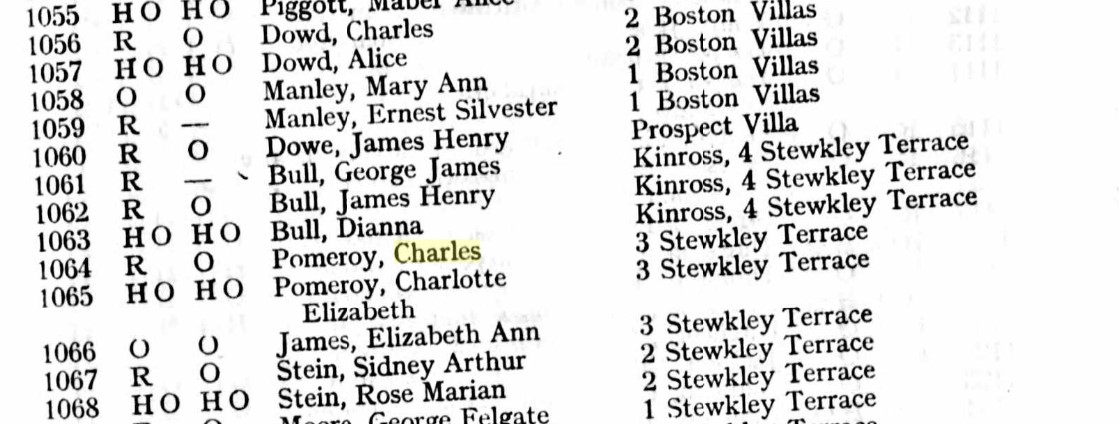
1928 Charles 73 years of age
1928 Register of Voters

1929 Charles 74 years of age
1929 Register of Voters
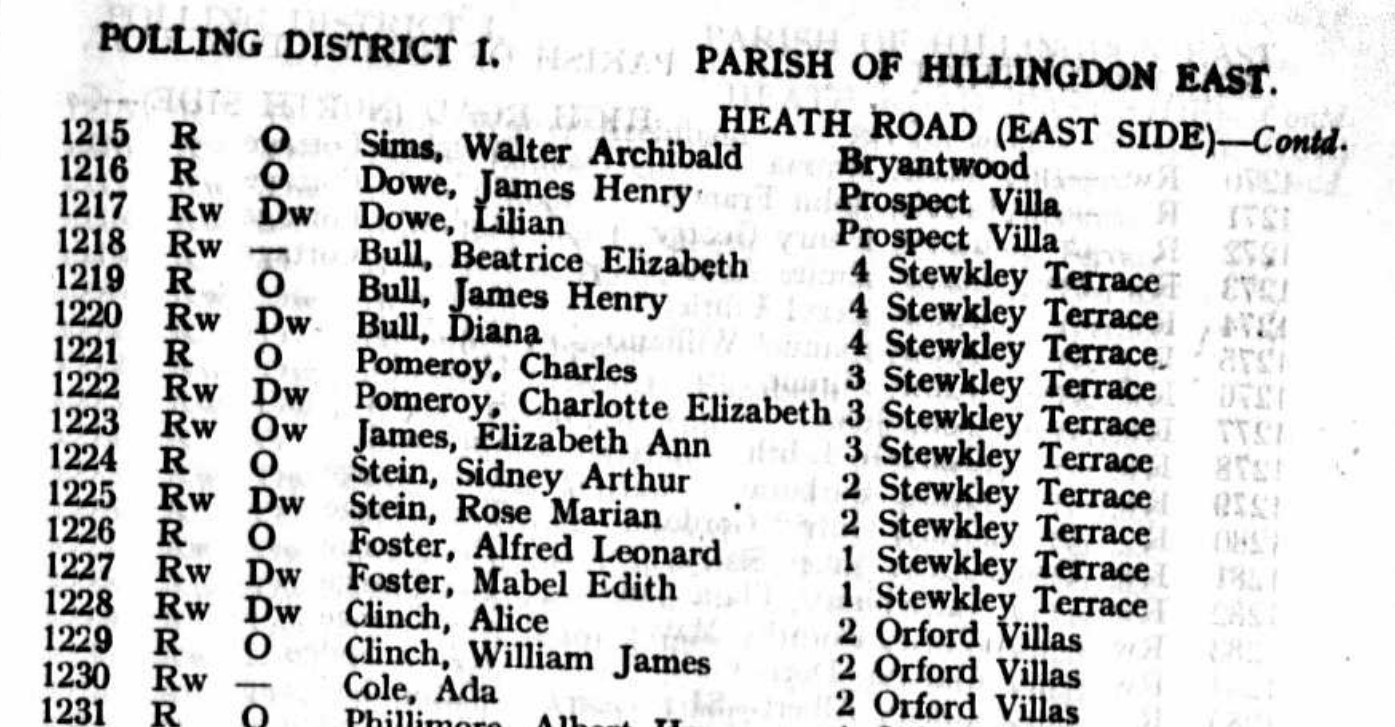
1930 Charles 75 years of age
1930 Register of Voters

1931 Charles 76 years of age
1931 Register of Voters
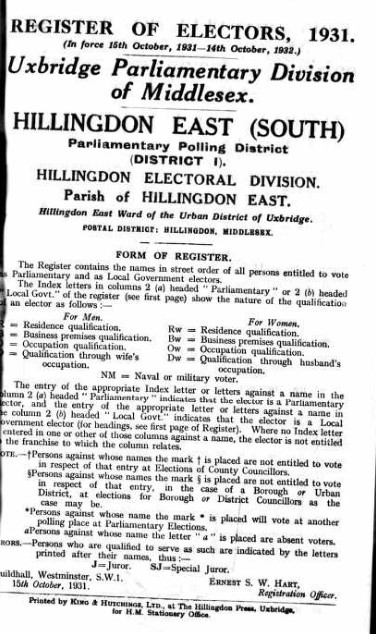

1932 Charles 77 years of age
1932 Register of Voters

3 Stewkley Terrace is occupied by Evelyn Annie and Phyllis in the 1932 Register of Voters, instead of Charles and Charlotte Elizabeth Pomeroy as found in preceding years.
Charles and Charlotte Elizabeth Pomeroy had moved, presumably in 1931 and appeared in the following year's Register of Voters, at 47 Marlborough Road with the Notley family.
Date of first confirmed record at 3 Stewkley Terrace, 38 Heath Road, Hillingdon, before 1st January 1914, i.e. 1913. Date of last record, before 1st January 1931, the first date of currency of Register of Voters. (1930/1931 carried forward)
47 Marlbrough Road
47 Marlbrough Road, Hillingdon, Uxbridge 1930/1931 to 1931/1932
Two families at 47 Marlbrough Road, Notley and Pomeroy.
In the county of Middlesex.
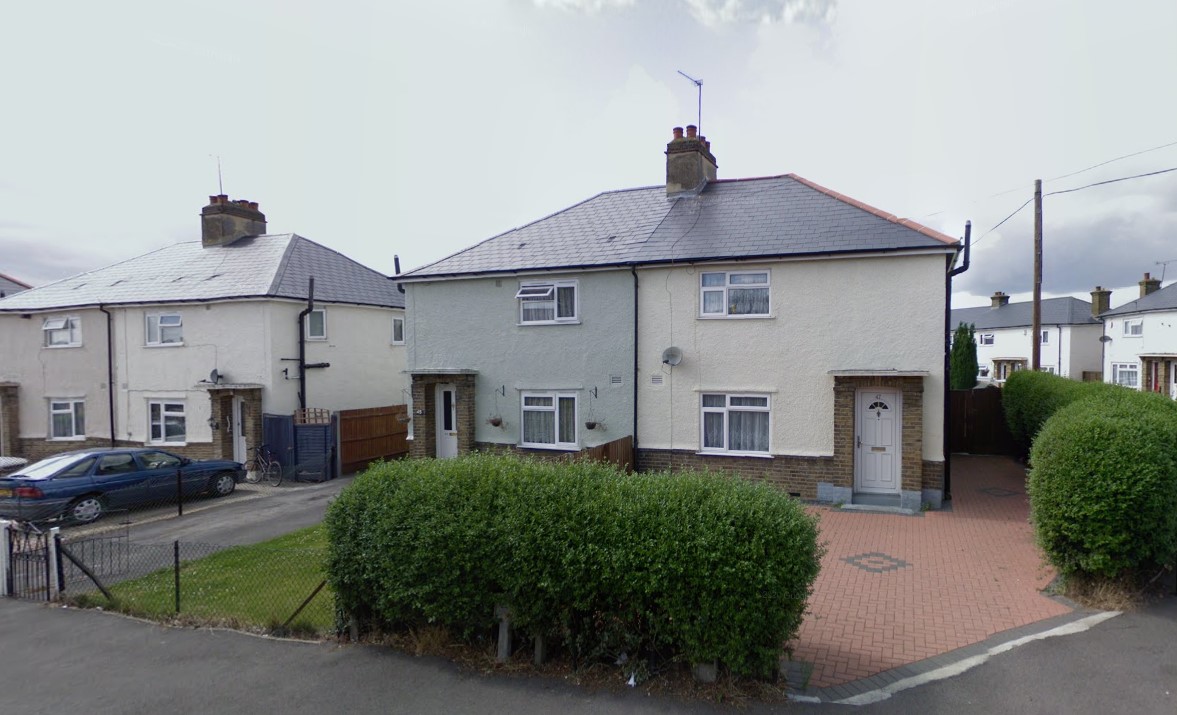
47 Marlborough Road is the house with the very green hedge.
47 Marlborough Road, Uxbridge is a 3 bedroom freehold semi-detached house - it is ranked as the 9th most expensive property in UB10 0PS, with a valuation of £389,000.
Since it last sold in June 2018 for £385,000, its value has increased by £4,000.
This property was constructed between 1930 and 1949 and has an energy efficiency rating of C.
So, this could have been a brand new house when occupied by the Notley and Pomeroy families in 1931/1932, or the previous number 47 could have been replaced by the one in the photo above.
1932 Charles 77 years of age
1932 Register of Voters
Charles and Charlotte Pomeroy had a daughter Evelyn Harriet Pomeroy on 2 December 1897 in Teddington, whilst they were living at 6 Beaconsfield Villas, Fulwell Road.

Evalyn Harriet Pomeroy was born of Charles and Charlotte Elizabeth Pomeroy on 2nd December 1897 and baptised on 26th January 1898 at SS Peter and Paul, Upper Teddington, Middlesex.
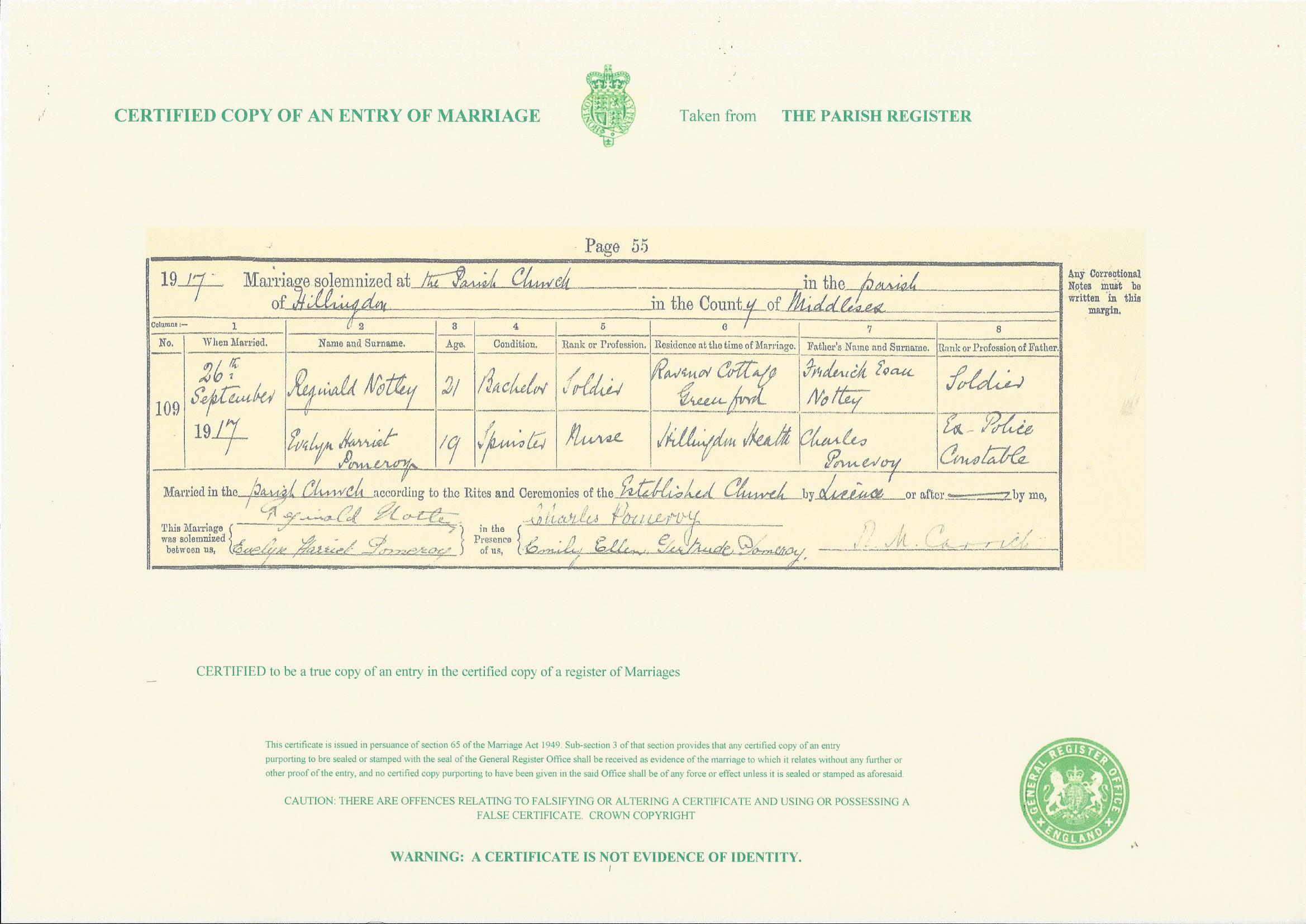
Evelyn Harriet Pomeroy married a Reginald Samuel Notley on 26 September 1917. Not yet sure who Frederick Josiah Notley is, possibly Reginald's father, but it appears that Charles and Charlotte Pomeroy are living with their daughter and son in law at 47 Marlbrough Road.
Going back in time to the Register of Voters 1921, Reginald Notley was living at 3 Stewkley Terrace, with his in-laws, as he was in 1922, extract of Register below.

By the 1923 Register of Voters, Reginald Notley, and presumably his wife, Evelyn Harriet had moved to 15 Pole Hill Road, a mere 4 minutes walk from 47 Marlborough Road, on a road both joining and parallel to Marlborough Road.

He was at the same address in the 1924 Register of Voters. Below is a Google Streetview of 15 Pole Hill Road. Well set back from the road, with large gardens.
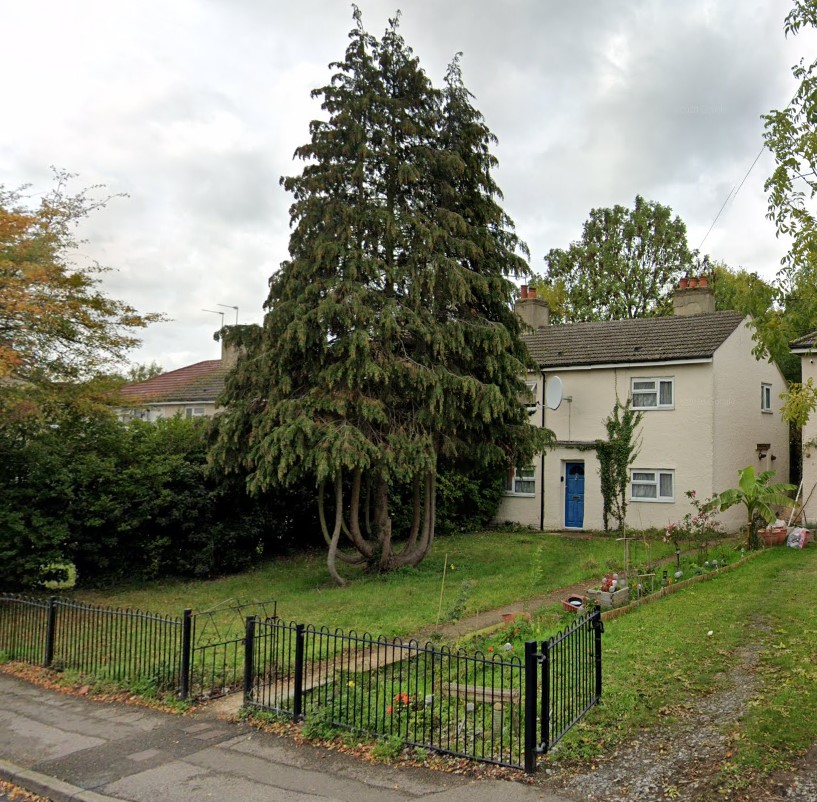
The above Ordnance Survey 25" Map was revised 1895 and published 1897. Heath Raod is clearly shown and has a number of buildings. Poleshill Road is adjacent to the text Hillingdon Heath. That field, plot 513 of just under 17 acres is where Marlborough Road and Nelson Road, Close, and Lane were built. Indeed you can still see the shape of the field on the satellite image of the location.
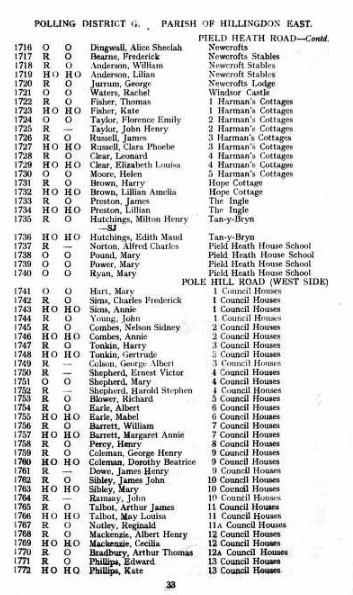
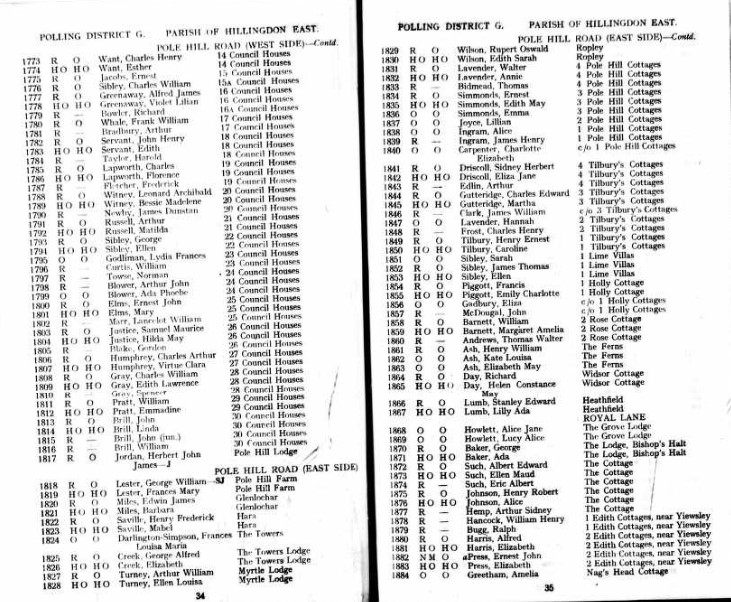
An extract from the 1926 Registers of Voters for the Pole Hill Road. Note the West Side is all the new buildings, Council Houses. The East Side has the older, named properties. 15 Pole Hill Road is no longer occupied Reginald Notley as he has moved to 11A Pole Hill Road.

In the 1927 Register for Voters Reginald Samuel Notley and his wife Evelyn Harriet Notley are at 47 Marlborough Road. There was no mention of Marlborough Road in the 1926 Register of the same area.

In conclusion, I consider that 47 Marlborough Road. was built with the rest of the Council Estate on plot 513 in 1926, or thereabouts, so the property in the photo of 47 Marlborough Road is probably the one lived in by the family.
47 Marlborough Road is within the field boundary, as is 11A and 15 Pole Hill Road, and 7 Nelson Lane, as well as Nelson Road and Nelson Close.
1933 Charles 78 years of age
1933 Register of Voters
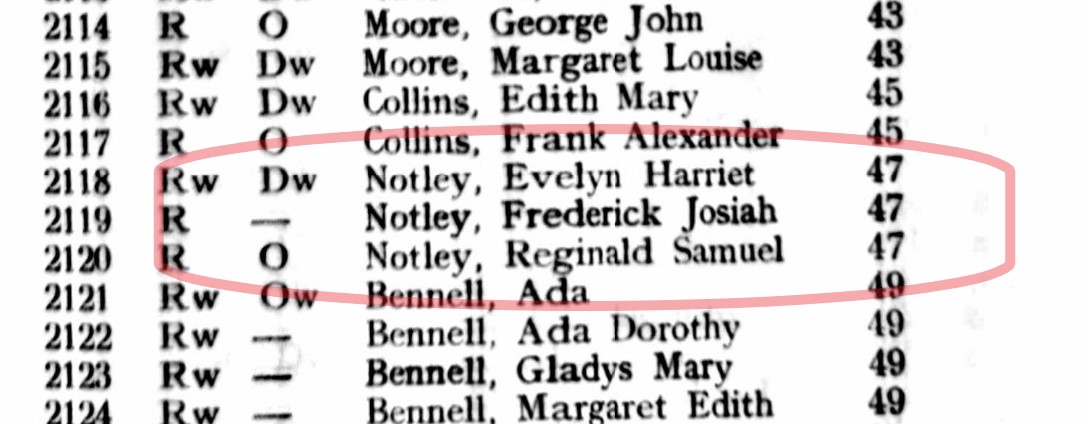
The Notley family remain in their council house, 47 Marlborough Road, but the Pomeroy family have moved back to Heath Road, this time at 4 Virginia Cottages, with Phyllis Selina Edgington.
1933 Charles 78 years of age
1933 Register of Voters
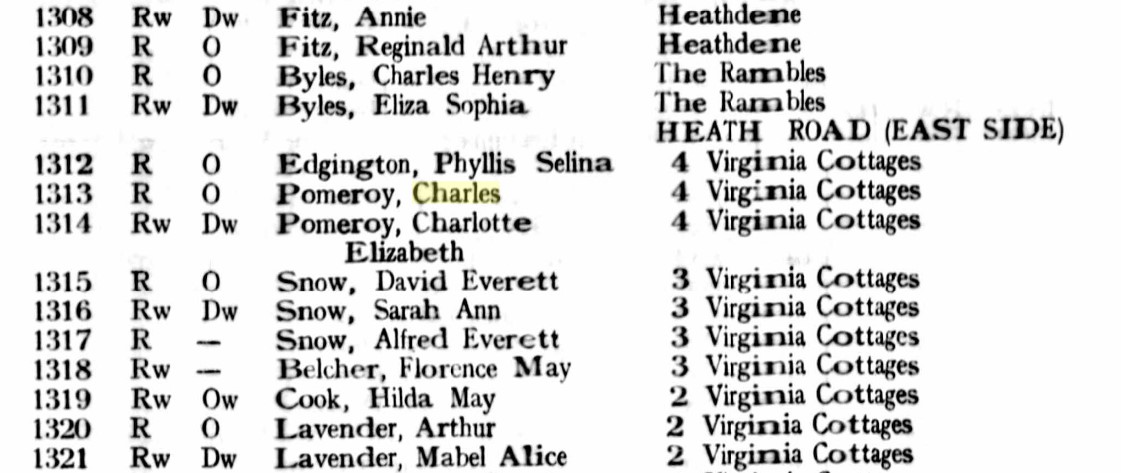
There was only one entry in the Register of Voters with Charles Pomeroy at 47 Marlbrough Road.
Date of first confirmed record at 47 Marlbrough Road, Hillingdon, before 1st January 1932, i.e. 1931. Date of last record, also before 1st January 1932, the first date of currency of Register of Voters. (1931/1932 carried forward)
4 Virginia Cottages, 60 Heath Road
4 Virginia Cottages, 60 Heath Road, Hillingdon, Uxbridge 1931/1932 to 1938
Back to Heath Road, but from number 38 to 60.
In the county of Middlesex.
The terrace of four does not have a plaque but on the right of the photo it can be seen that the adjacent semi has a datestone. A close up of it reveals it is difficult to read but probably Milton Villas.
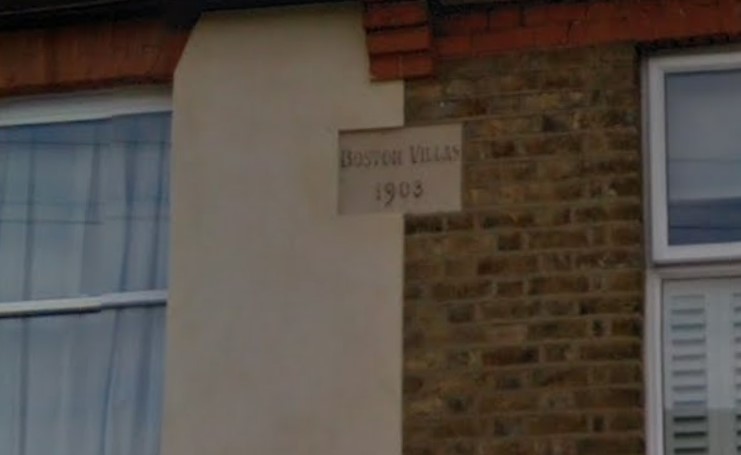 The next semi along is much clearer, Boston Villas 1903. The sequence matches that in the Street arranged Register of Voters. The property on the left of the terrace, with the tree, which matches the sequence to be 4 Virginia Cottages, is 60 Heath Road. The Register of Voters below is out of order 1934, but demonstrates the sequence of properties in Heath Road (East Side), from 4 Virginia Cottages to Stewkley Terrace.
The next semi along is much clearer, Boston Villas 1903. The sequence matches that in the Street arranged Register of Voters. The property on the left of the terrace, with the tree, which matches the sequence to be 4 Virginia Cottages, is 60 Heath Road. The Register of Voters below is out of order 1934, but demonstrates the sequence of properties in Heath Road (East Side), from 4 Virginia Cottages to Stewkley Terrace.
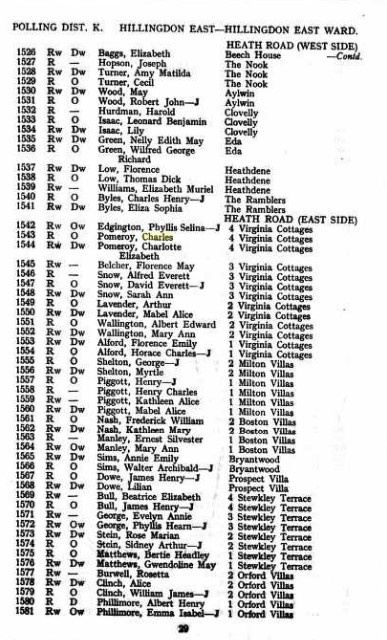
1933 Charles 78 years of age
1933 Register of Voters

The Pomeroy family have moved back to Heath Road, this time at 4 Virginia Cottages, with Phyllis Selina Edgington. 4 Virginia Cottages is also 60 Heath Road.
1934 Charles 79 years of age
1934 Register of Voters
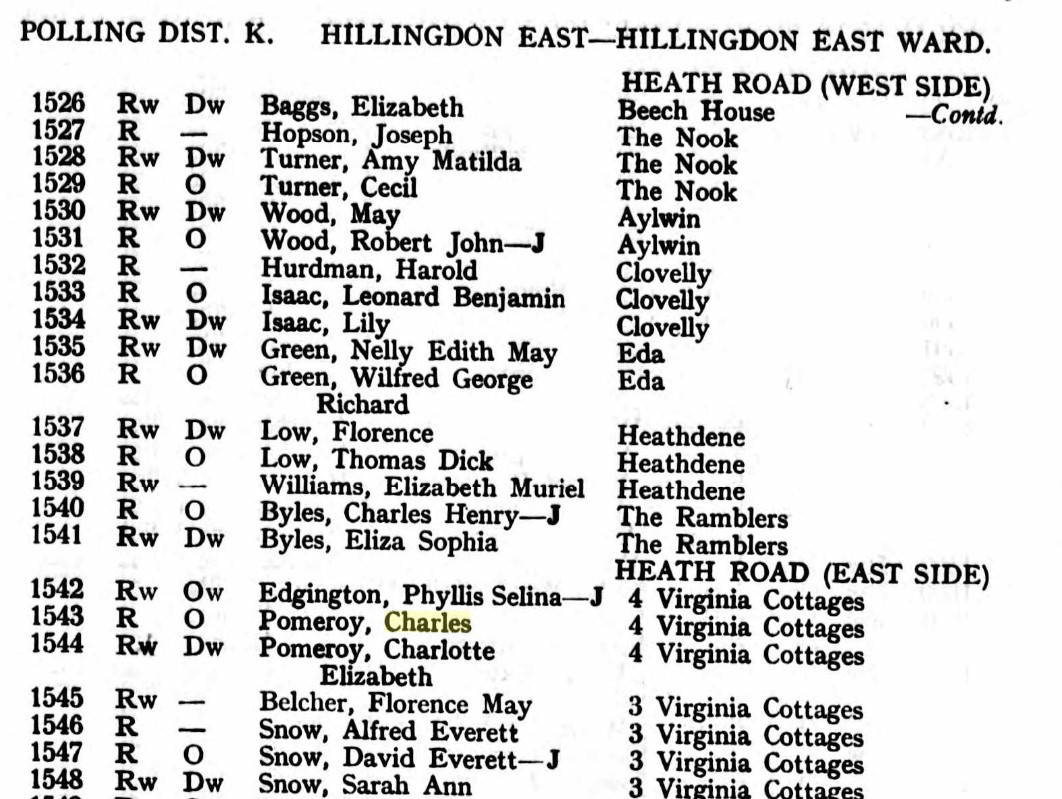
1935 Charles 80 years of age
1935 Register of Voters

1936 Charles 81 years of age
1936 Register of Voters

1937 Charles 82 years of age
1937 Register of Voters

1938 Charles 83 years of age
1938 Register of Voters
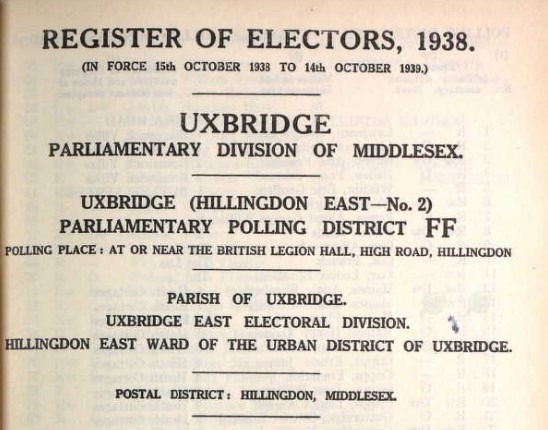
Instead of the 1st January this Register of Voters is in force from 15th October 1938 to 14th October 1939. Hillingdon East has been devided as a polling district in light of the increase in population.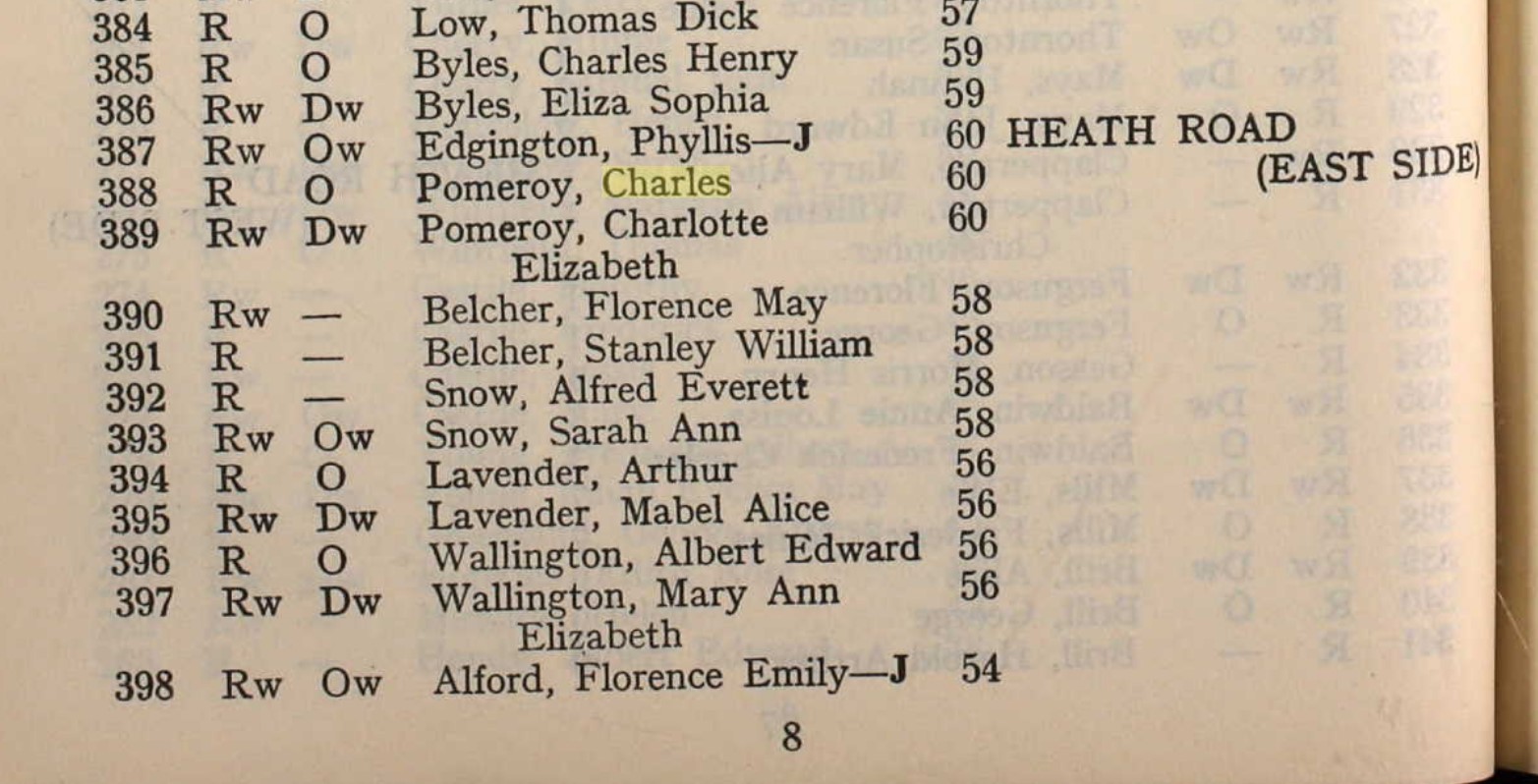
Still 4 Virginia Cottages as it is also 60 Heath Road, and still with Phyllis Selina Edgington.
Who is Phyllis Selina Edgington of 4 Virginia Cottages, 60 Heath Road, always in the Register of Voters with Charles and Charlotte Elizabeth Pomeroy, from 1933 to 1938? Apart from 1933, with a 'J' after her name indicating a Juror.
Is she somehow related to Charles and Charlotte, or perhaps looking after them, after all, Charles is 78 to 83 years old in this period and Charlotte is only two years younger.
I though it would be easy to find some information on Phyllis Selina Edgington, it is not exactly Jane Smith nor a particularly common name. A quick search revealed a 1911 Census with a person of that name a servant, which in turn led to earlier Census results finding parents in Clerkenwell. No direct link, but perhaps some proximity association.
However, it soon became complicated, with a Phyllis Selina Edgington in the Register of Voters at Bartram Lodge, Harlington Road, Hillingdon, Middlesex, England, from 1929 to 1937. Just 16 minutes walk away for the entry for the same name at 60 Heath Road. According to The Workhouse Org. Bartram Lodge was from 1929 a Children's Home. A Phyllis Selina Edgington was found at 4 King Edwards Grove, Twickenham, Spelthorne, Middlesex, England. In the 1939 Register, she is described as being in charge of Children.
Are there two people of the same name in the same Voter district, just five pages apart in the Register of Voters (1935), at the same time, one working at the Children's Home and another less than a mile away looking after Charles and Charlotte Elizabeth Pomeroy?
Death Certificate

Charles Pomeroy died on 24th September 1938 at his home, 60 Heath Road, Hillingdon, Uxbridge at the age of 83. His widow Charlotte Pomeroy registered his death on 26th September 1938
Date of first confirmed record at 4 Virginia Cottages, 60 Heath Road, before 1st January 1933, i.e. 1932. Date of last record, before 15th October 1938, the first date of currency of Register of Voters, and after 26th September 1938. (1938 carried forward)
7 Nelson Lane
7 Nelson Lane, Hillingdon, Uxbridge 1938 to 1940
In the Register of Voters in her own right, as Rw Ow, in the bunglow 7 Nelson Lane, off Nelson Close, Hillingdon.
In the county of Middlesex.

1939 Charles passed but would have been 84 years of age
1939 Register of Voters

Death Certifiacte of Charlotte Elizabeth Pomeroy

Charles Pomeroy died on 24th September 1938 at 60 Heath Road, Hillingdon, Uxbridge at the age of 83. His widow Charlotte Elizabeth Pomeroy died 18 months 27 days later on 20th April 1940 at her home, 7 Nelson Lane, Hillingdon, Uxbridge, also aged 83. Her daughter C. M. Blower registered his death on 22th April 1940, and her residence was 1 Pole Hill Road, Hillingdon.
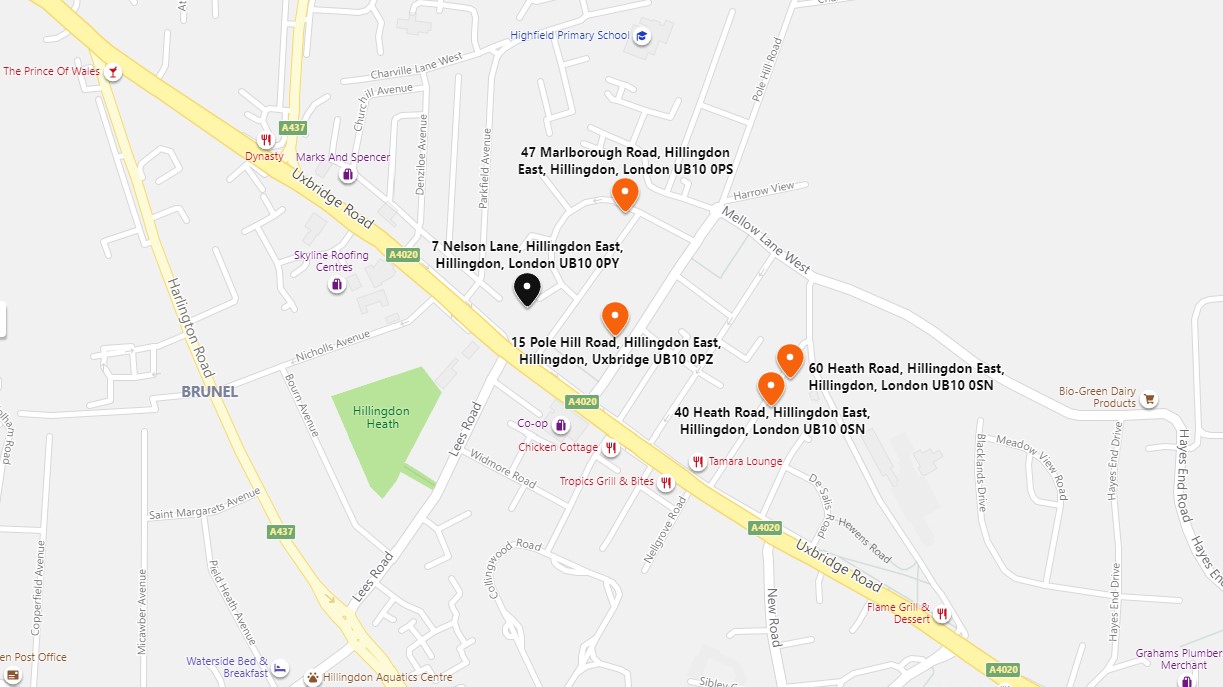
Hillingdon and Hillingdon Heath

Bing Maps Aerial view with Hillingdon Hoispital, the site of the old Workhouse, lower left, and The Prince Albert, Charles and Charlotte Elizabeth Pomeroy's first home in the area, together with the locations and relative distance of the places in Hillingdon Heath, on the upper right.
No. |
Section |
Place of abode |
Estimate of commencement
|
Estimate of finish
|
|
| 1 | Dorset |
Giles Cross, Bradford Peverell, Dorset |
Birth - 1854 |
1861/1871 |
|
| 2 | Dorset |
Compton Valence, Dorset |
1861/1871 |
c.1878 |
|
| 3 | Clerkenwell |
29 John Street, near Wilmington Square |
1878/1880 |
1882/1884 |
|
| 4 | Clerkenwell |
20 Torrens Buildings, Torrens Street, Islington |
1882/1884 |
1887/1889 |
|
| 5 | Clerkenwell |
104 Saint John Street, Clerkenwell |
1887/1889 |
1889/1891 |
|
| 6 | Clerkenwell |
18 Palmerston Buildings, City Garden Row |
1889/1891 |
1892/1893 |
|
| 7 | Teddington |
6 Beaconsfield Villas, Fulwell Road, Teddington |
1892/1893 |
1904 |
|
| 8 | Teddington |
2 Albert Villas, 23 Prince's Road, Teddington |
1904 |
1905 |
|
| 9 | Teddington |
1 Albion Villas, 17 Prince's Road, Teddington |
1905 |
1910/1911 |
|
| 10 | Hillingdon |
The Prince Albert Public House, Colham Green |
1910/1911 |
1912/1913 |
|
| 11 | Hillingdon |
3 Stewkley Terrace, 38 Heath Road, Hillingdon, Uxbridge |
1912/1913 |
1930/1931 |
|
| 12 | Hillingdon |
47 Marlbrough Road, Hillingdon, Uxbridge |
1930/1931 |
1931/1932 |
|
| 13 | Hillingdon |
4 Virginia Cottages, 60 Heath Road, Hillingdon, Uxbridge |
1931/1932 |
1938 |
|
| 14 | Hillingdon |
7 Nelson Lane, Hillingdon, Uxbridge(Only Charlotte) |
1938 |
1940 |
|
